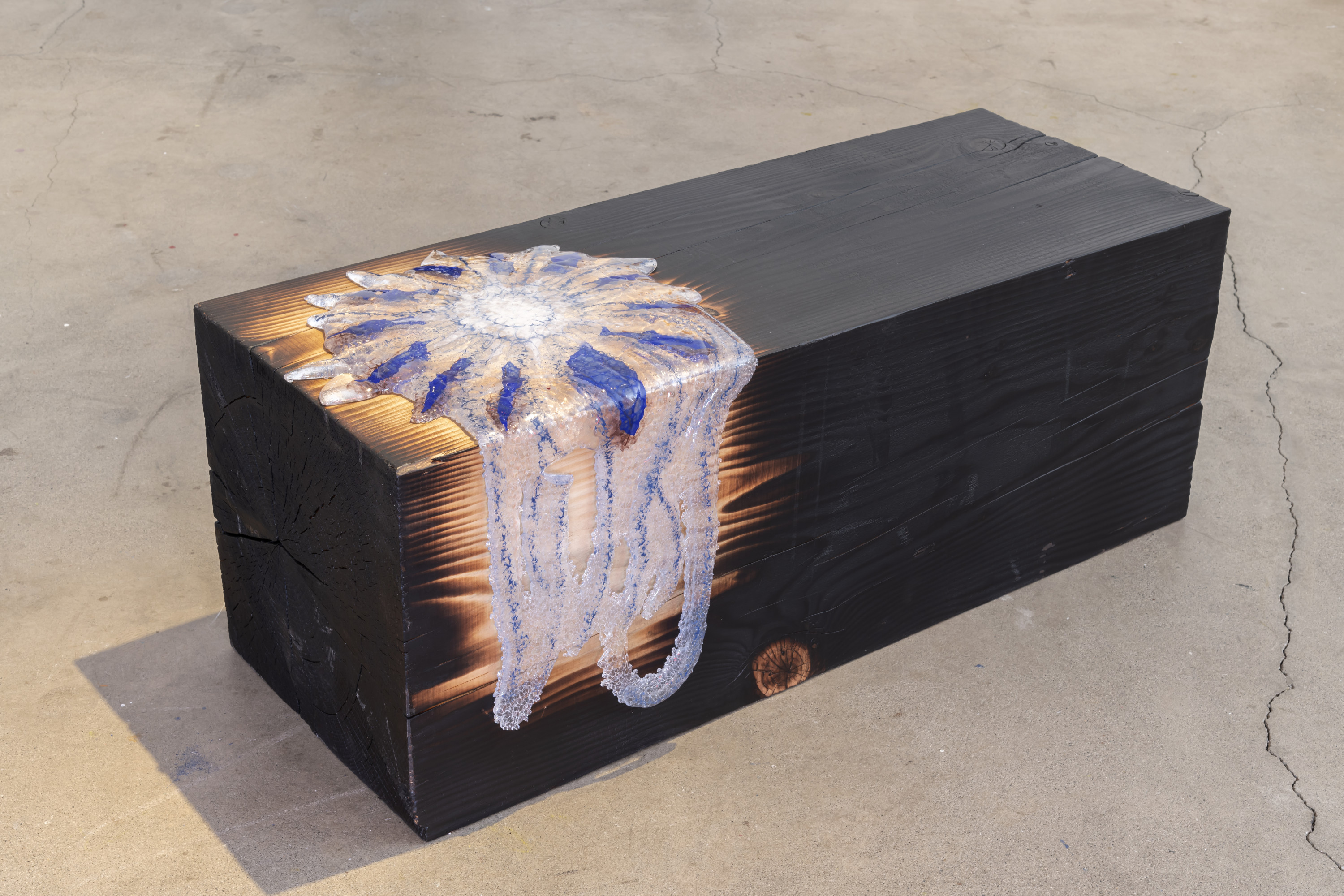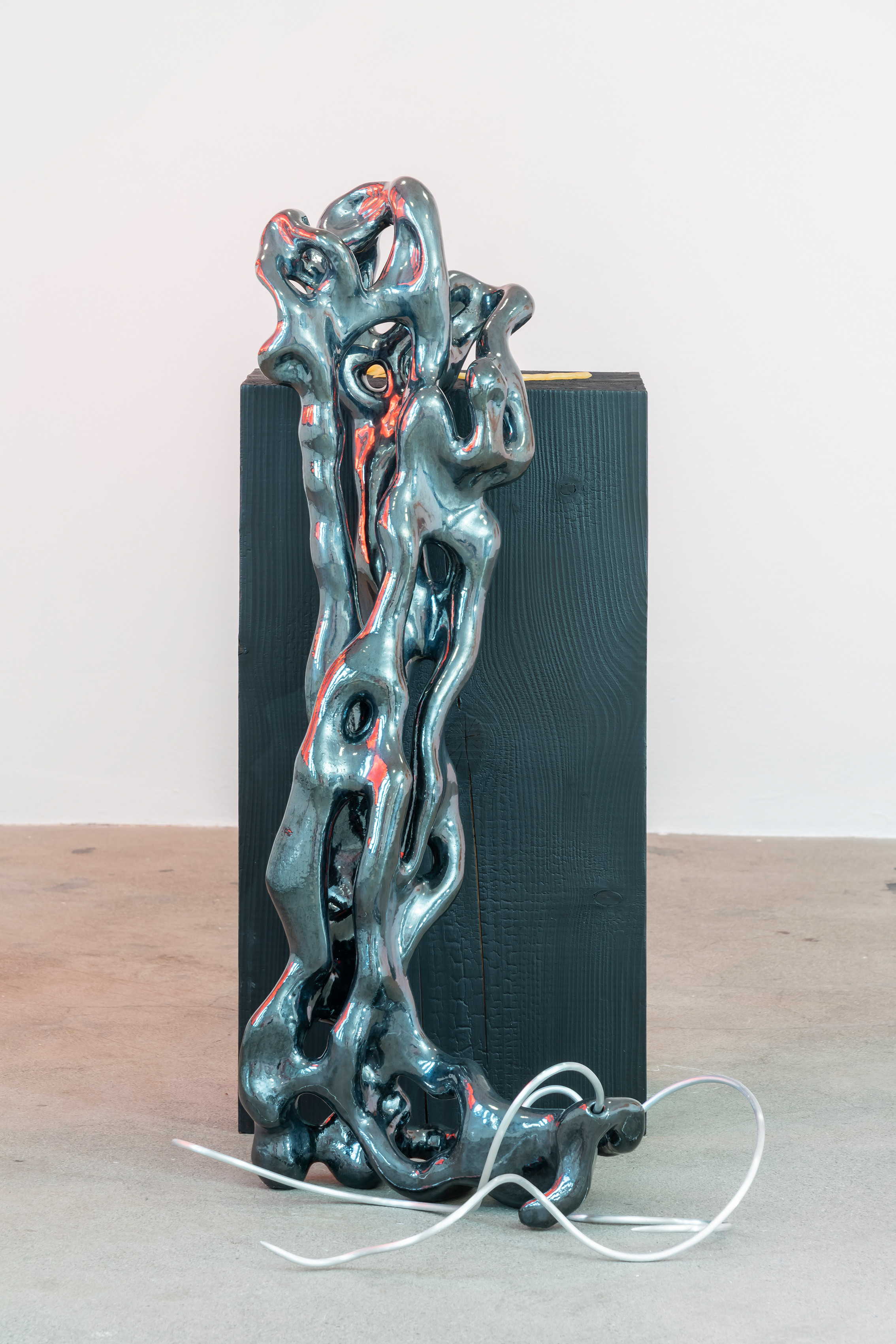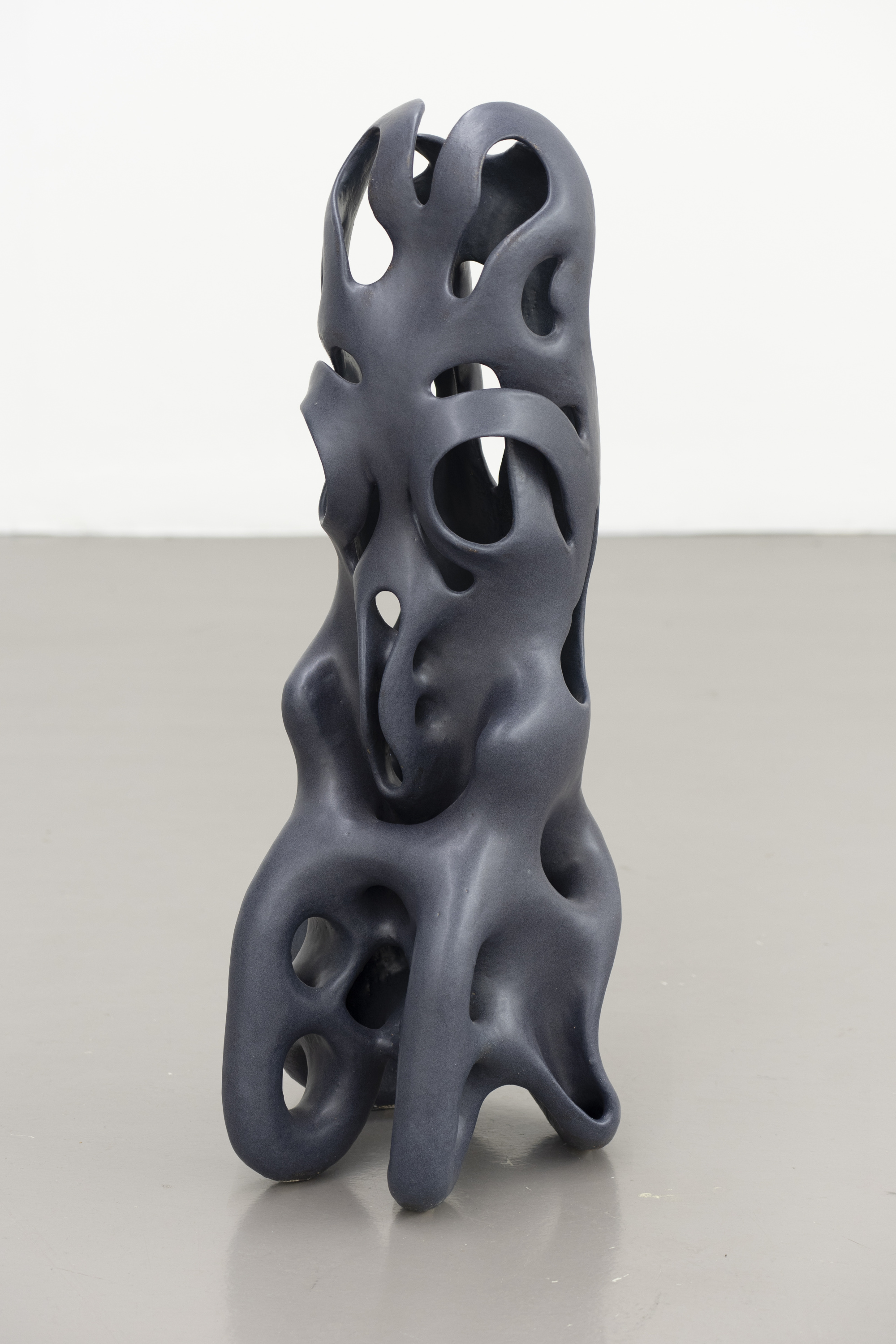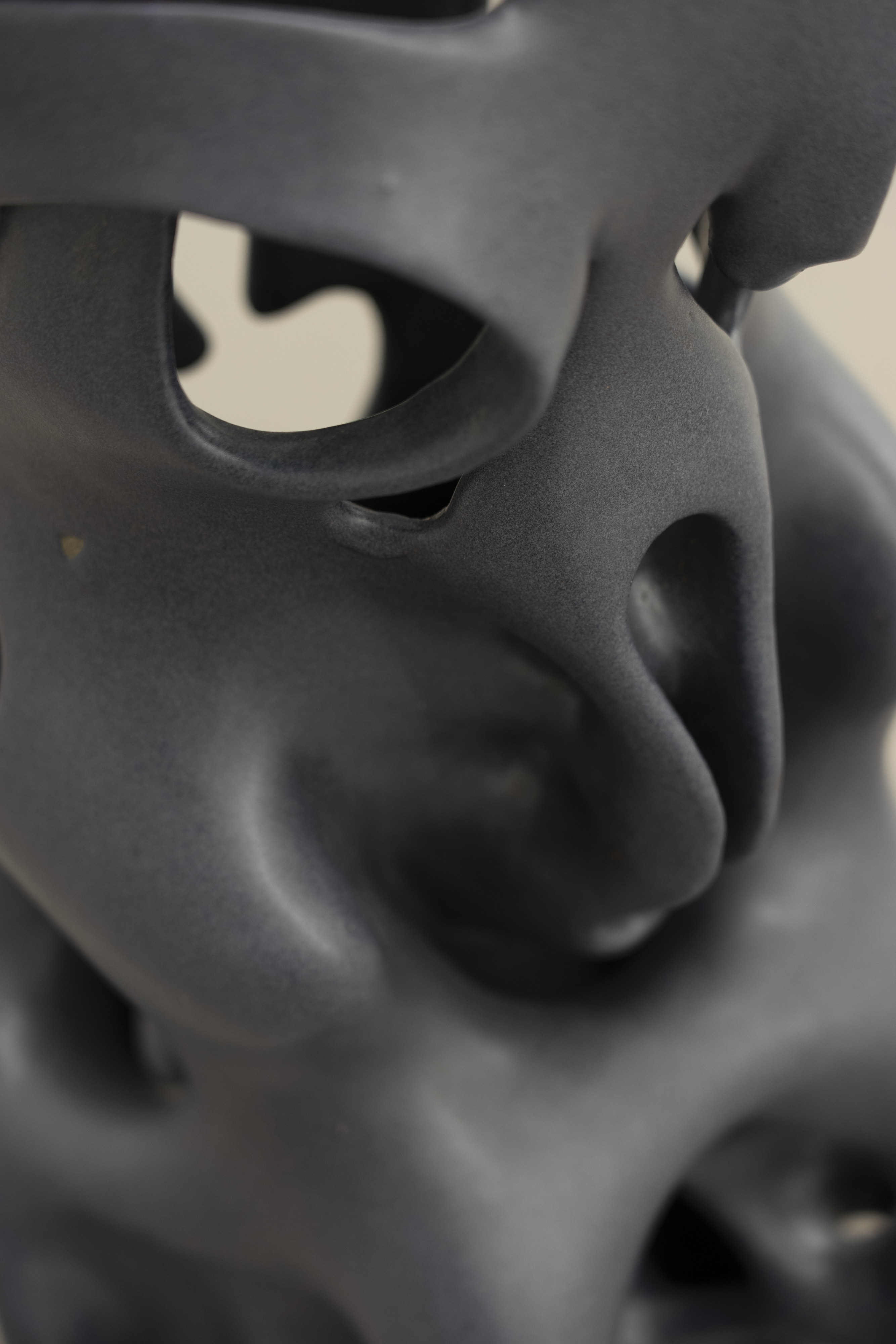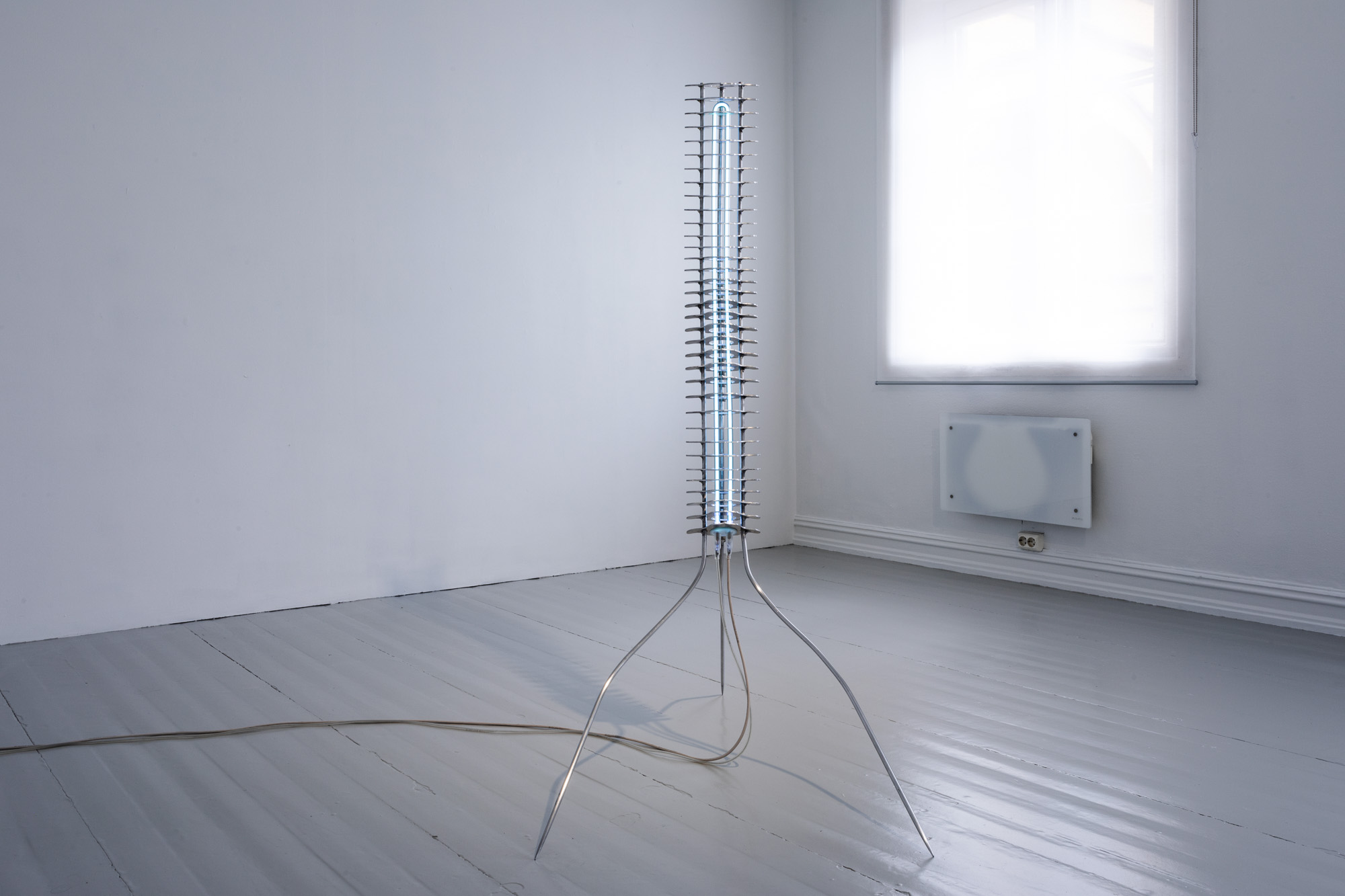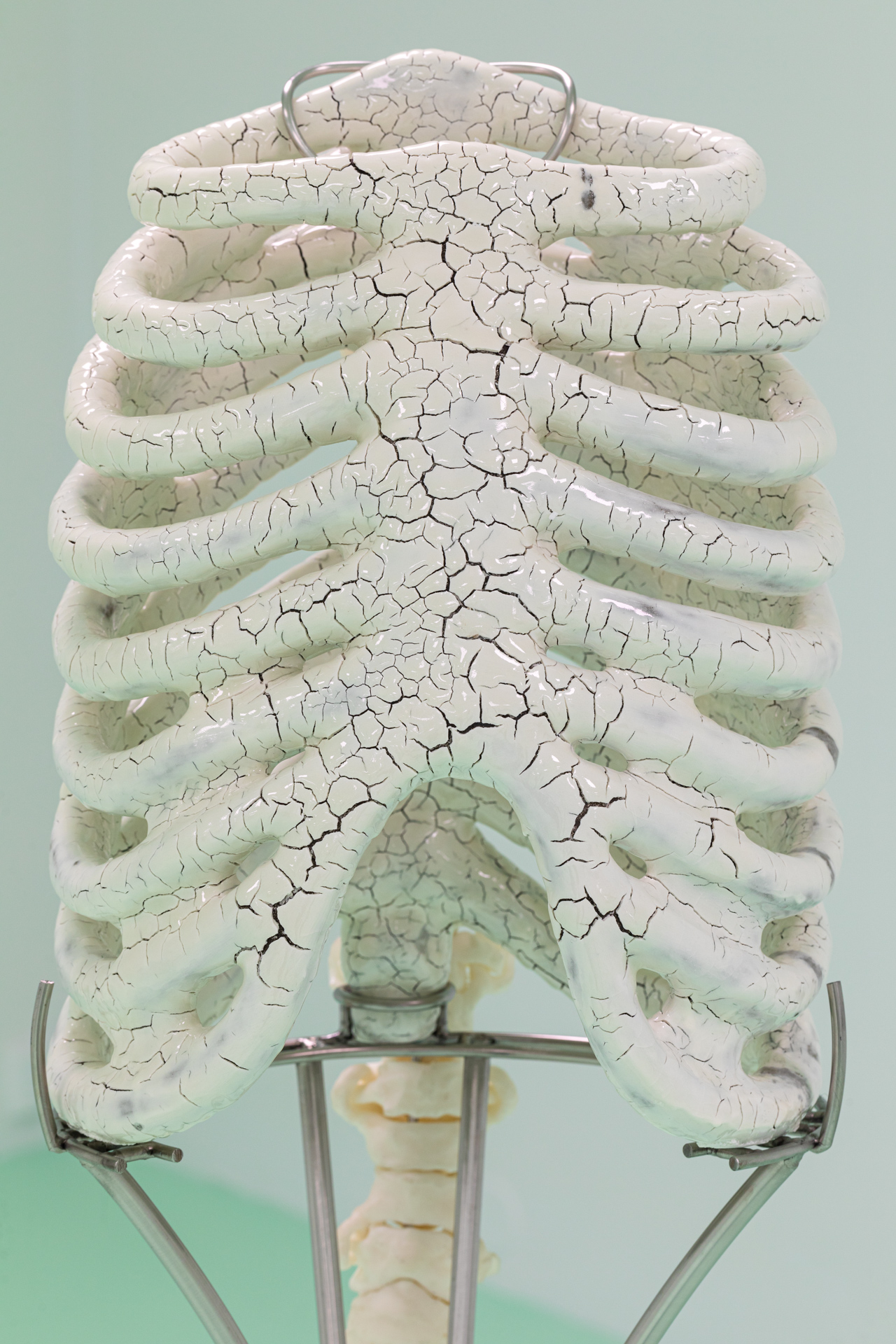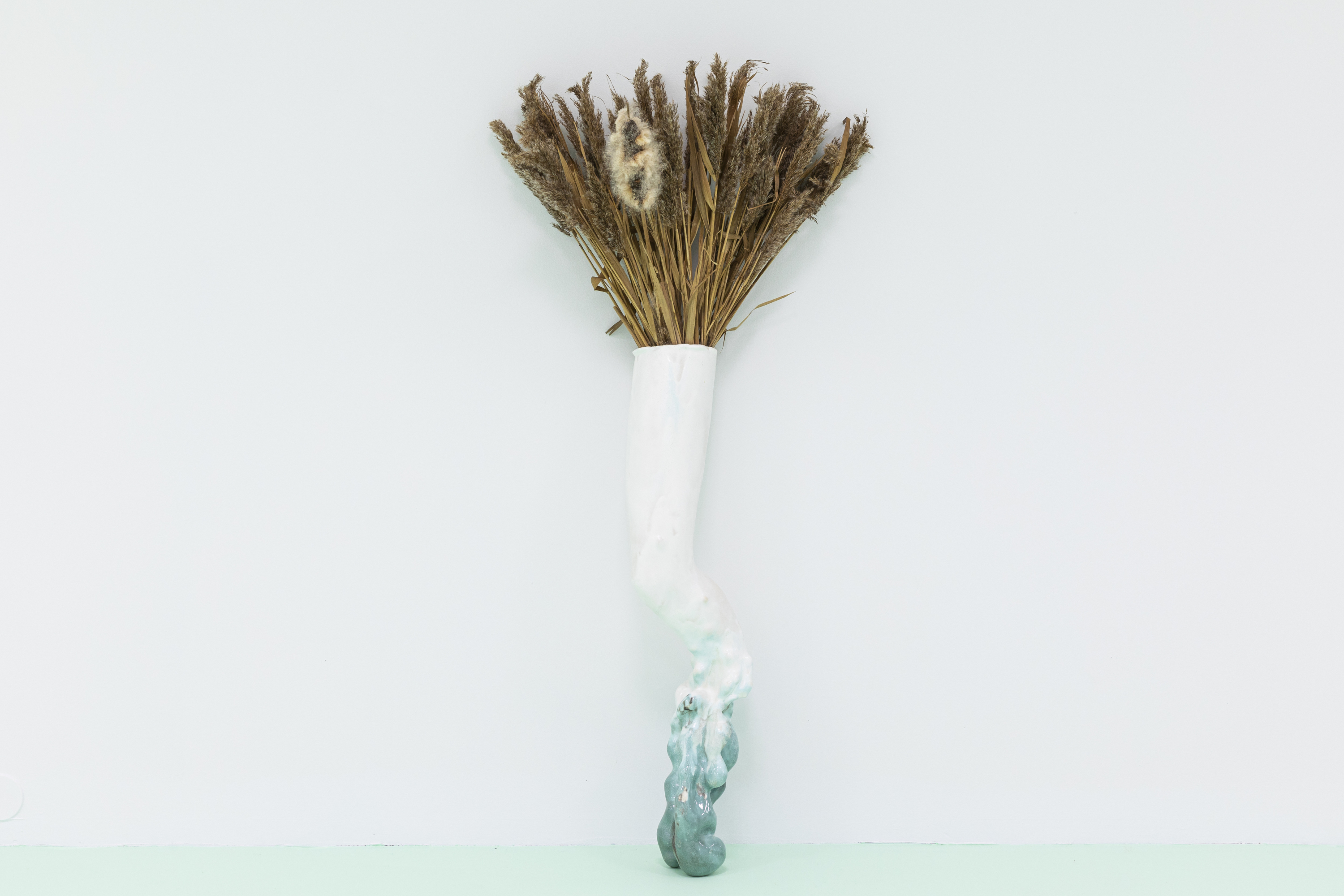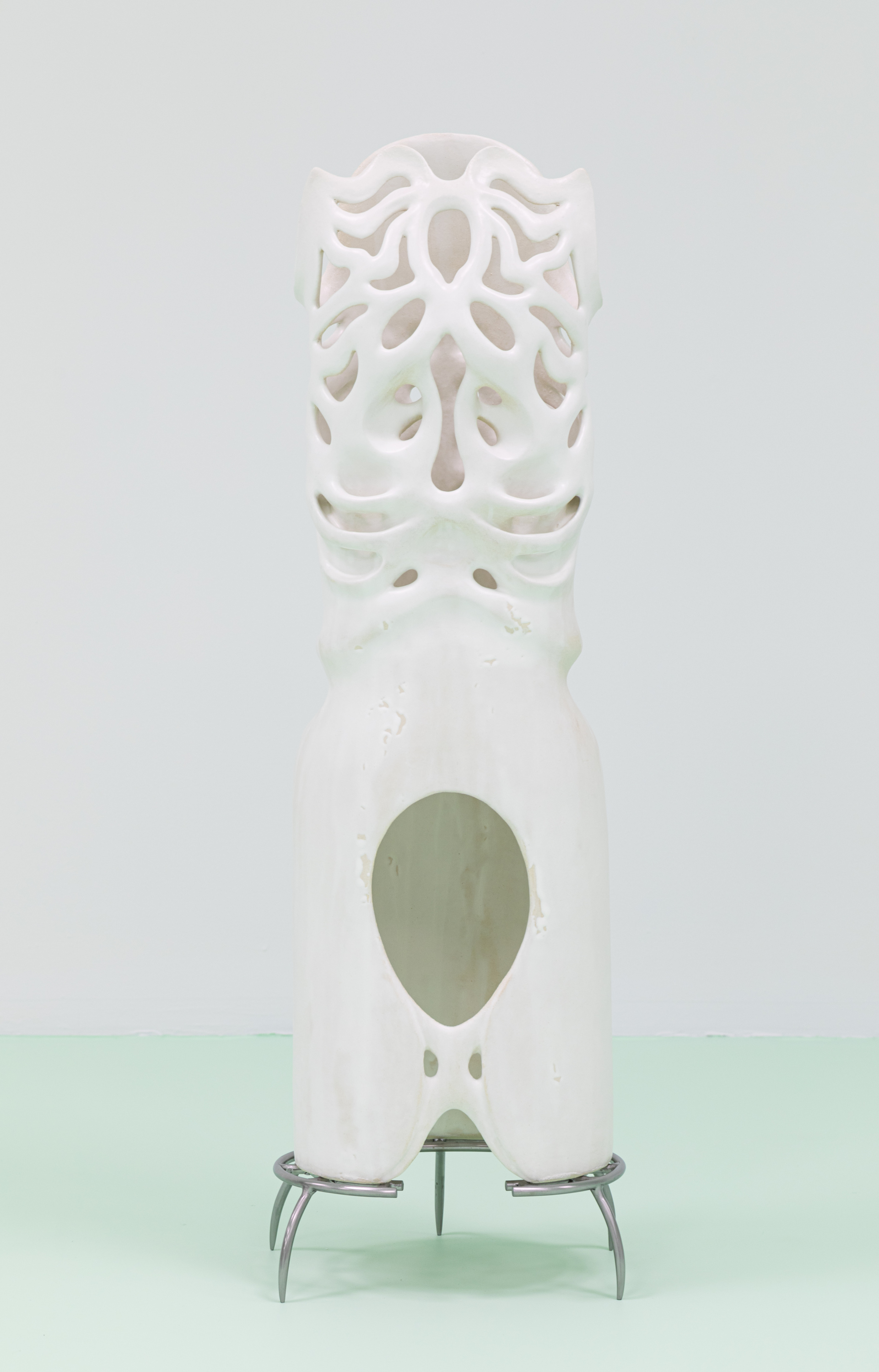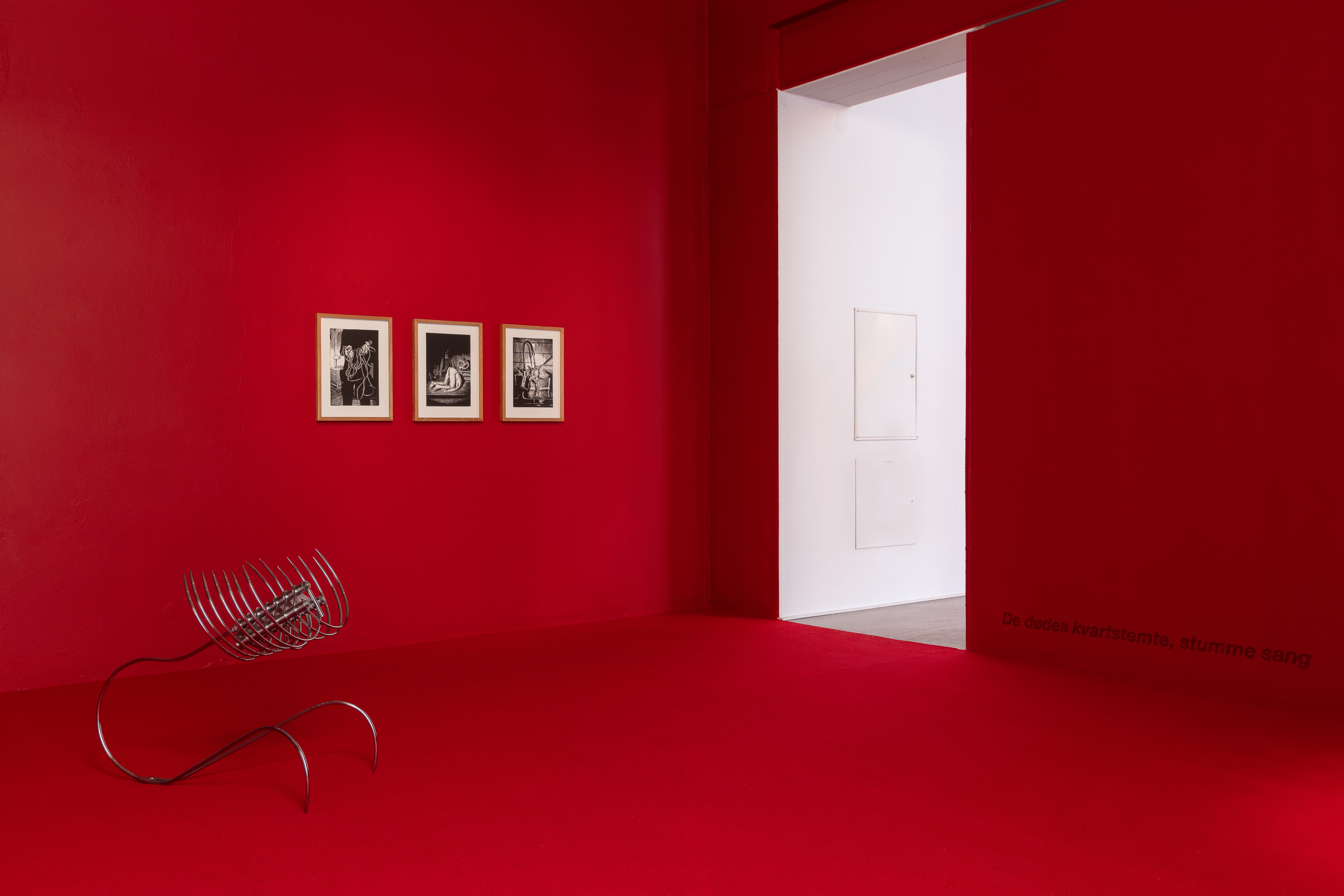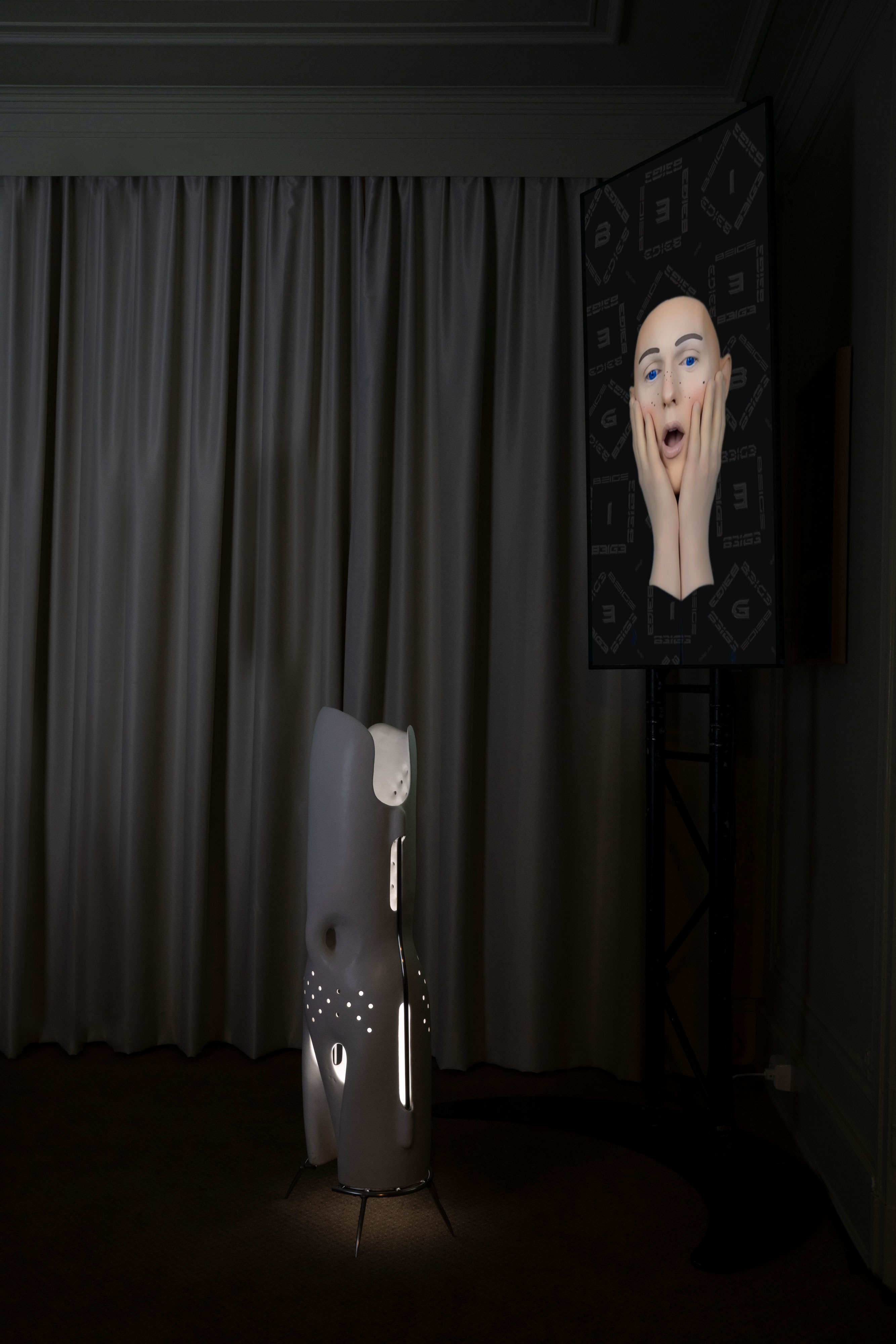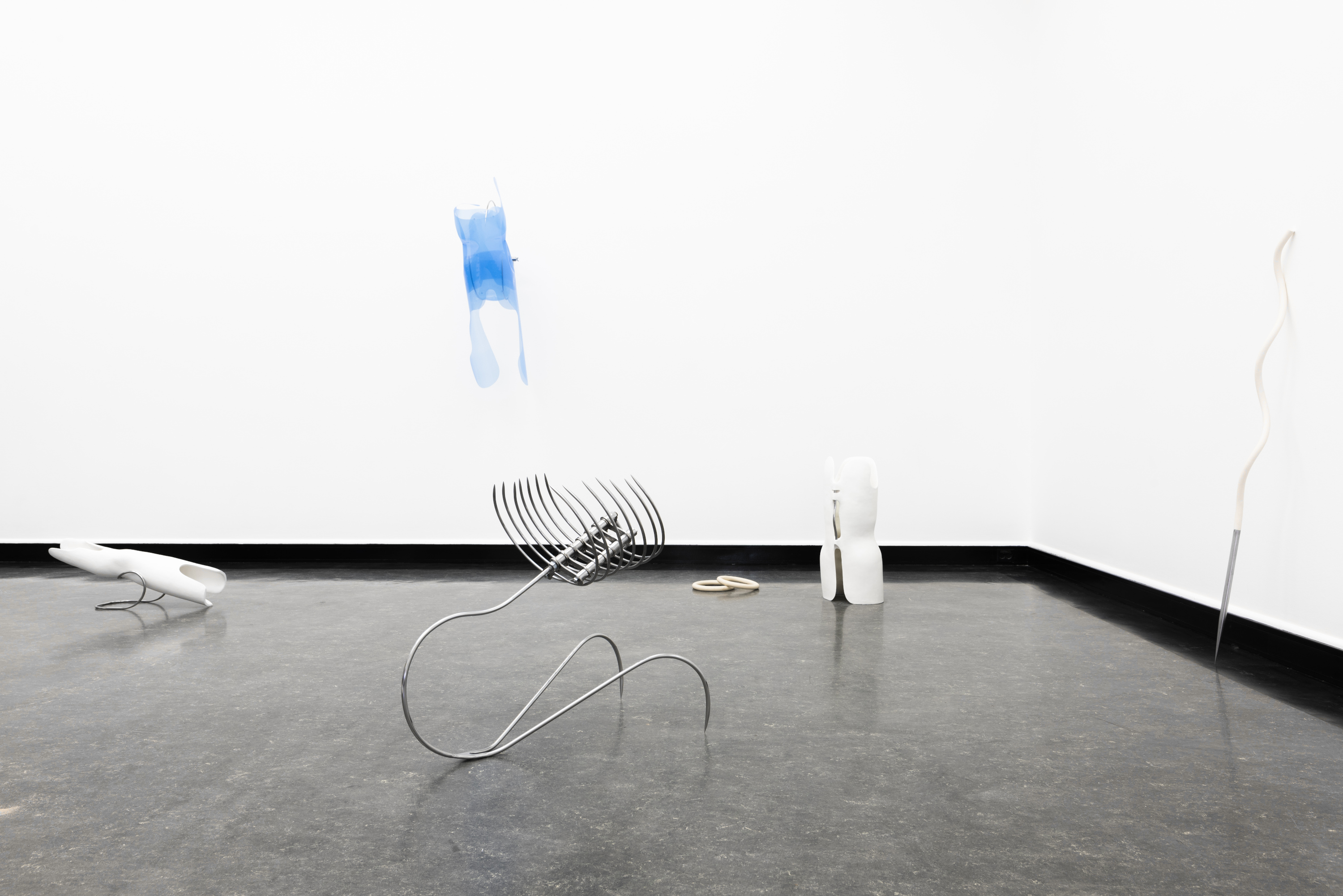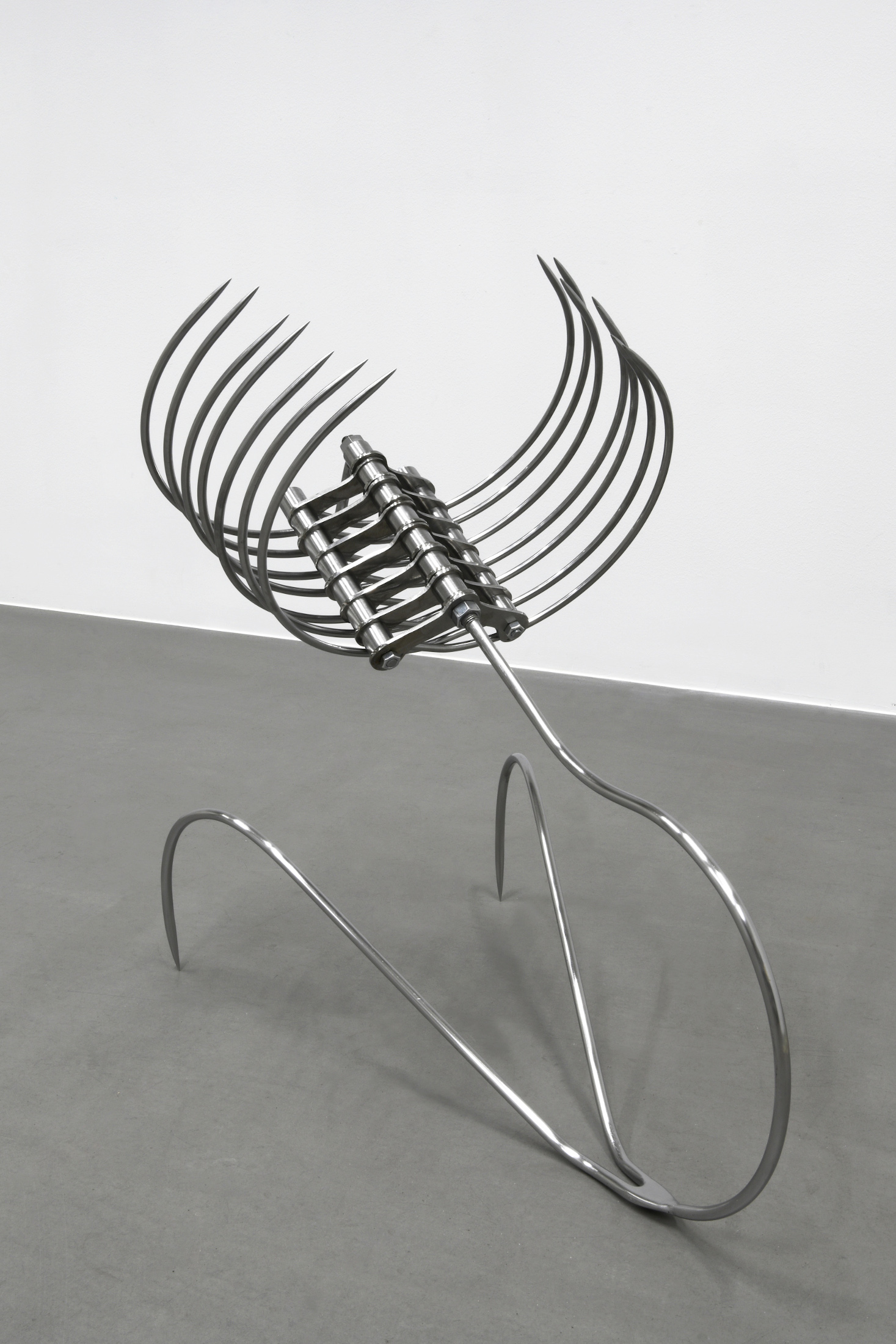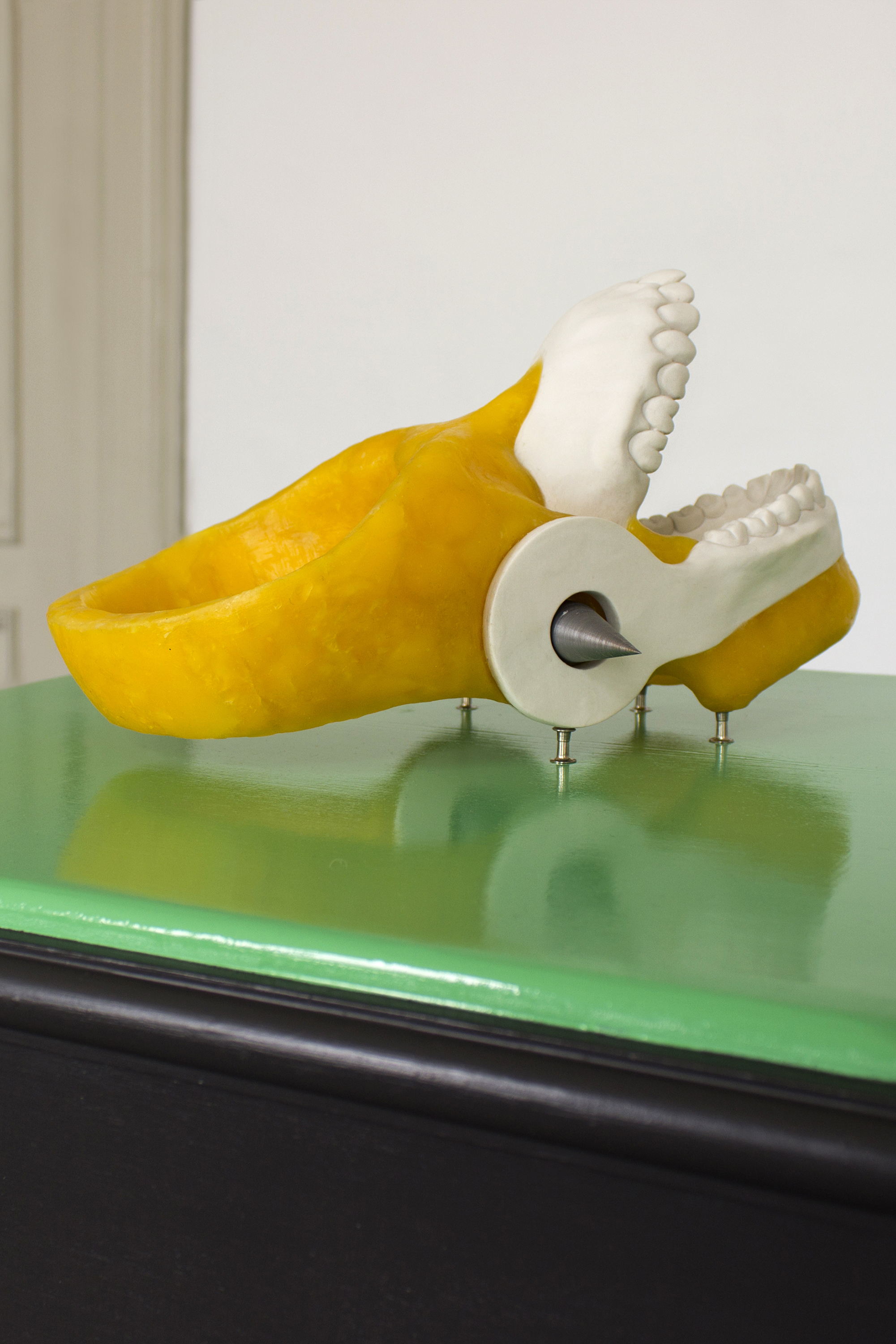Phytosleep
19. – 29. September 2023
Studio PRÁM, Prague
Curator: Šárka Koudelová
Documentation: Filip Švácha
The exhibition Phytosleep was the result of a two month residency at Studio PRÁM, Prague
Exhibition text written by curator Šárka Koudelová
The word “synthetic” does not in itself mean more than “put together” or “made up of several parts”. Yet we subconsciously perceive it as a negative quality, a toxic opposition to our dream kalokagathia. Conversely, anything with the label “natural” or “organic” is perceived as the best for the human body, soul and moral profile. But what are the real meanings of these words, aside from capitalist marketing, in the context of the so-called chemical Anthropocene, about which the theorist Lenka Veselá writes1? The term Anthropocene has come to mean an epoch in which the consequences of human activity have caused irreversible changes in the planetary ecosystem. The chemical Anthropocene can then refer to the era when human and any other cells were colonized by the emissions of industrial production. Chemicals that affect hormone production have become an integral part of metabolism, affecting our mood, lifespan and reproduction.
In her new series of works, most of which are surprisingly painterly given her exclusively sculptural focus, Linda Morell processes her own surprise at the banana’s form before its domestication. The banana – a humorous sexual metaphor – and yet it has been stripped by man of its own capacity for sexual reproduction. The seeds inside the fruit unnecessarily took the place of the sweet flesh and had to give way to our vision of a healthy natural snack. Imagining a healthier self, we reach for seedless fruits in the supermarket and guaranteed organic supplements in the pharmacy to give us more energy for our stressful lives and to relieve our environmental grief. In the context of the theory of the chemical Anthropocene, Linda inquires herself about the meaning of the glorification of health, “clean” raw materials in a polluted world, and explores the possibilities of rearranging plant and human life forms.
Plant bodies, which we have cut off from the possibility of evolution by domestication and control of their reproduction, cannot synthesize with the new conditions. Do we accept that new human bodies synthesized with bypasses, implants, anti-age methods, added hormones or queer modifications can be natural?
Aloe vera, with which we potentially share much of our bodies in the planet-wide water cycle, is perhaps the absolute best-seller of natural products. Its leaf, with whose skin, succulent flesh and morphology we readily identify, lies ready on the ambo, dominating the space of the exhibition, to wither solemnly and be devoured by parasitic tendrils.
The entire installation is bathed in a yellow light, the hue of which seems exactly on the borderline between soothing and toxic waste. Linda Morell thus intuitively connects the current social atmosphere of reconciled limbo with the anxious anticipation of catastrophe. The situation suggests that even the threat of extinction will not change human habits. However, our species position, built on the exploitation and control of other species, obliges us to at least make a conscious effort to emancipate ourselves from the industries that non-consensually controls the lives of all earthly beings at the molecular level. The beginning of liberation is the change of the obsolete idea of the “naturalness” of our bodies.
1Veselá Lenka, Chemický antropocén, Flash Art #66, 12/2022 – 3/2023
Czech & Slovak Edition [online], zdroj: https://flashart.cz/2023/02/02/chemicky-antropocen/


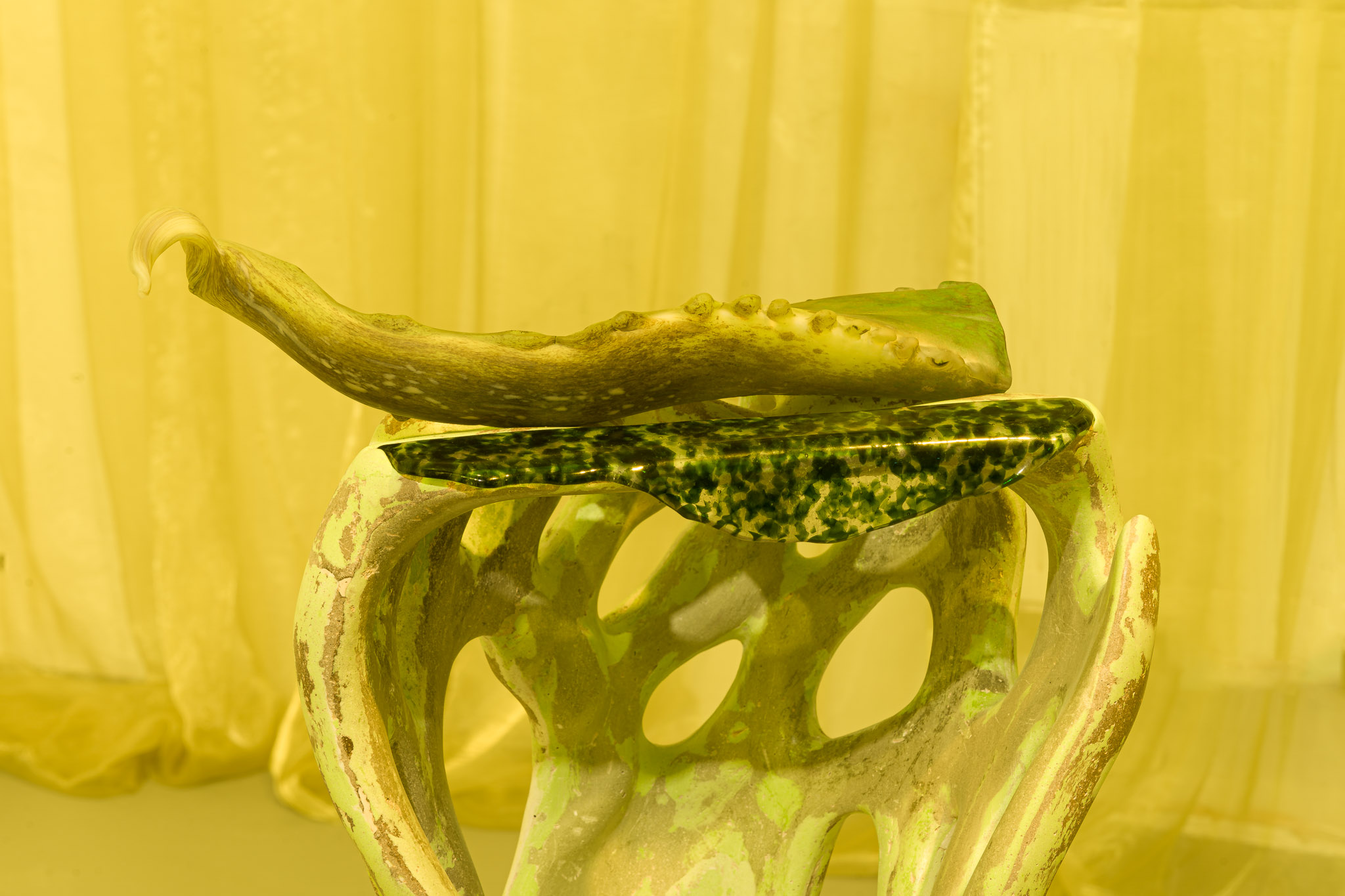

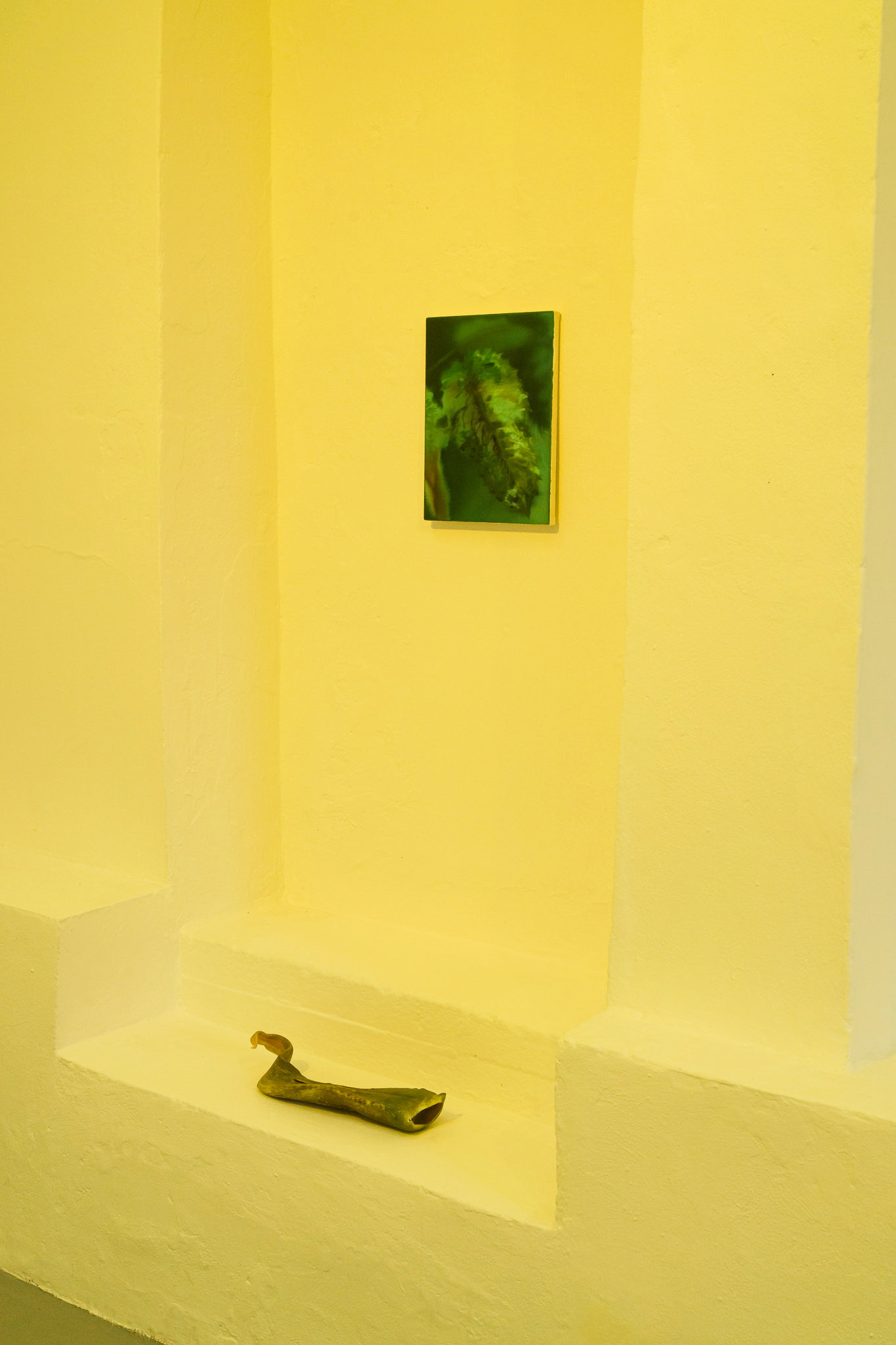
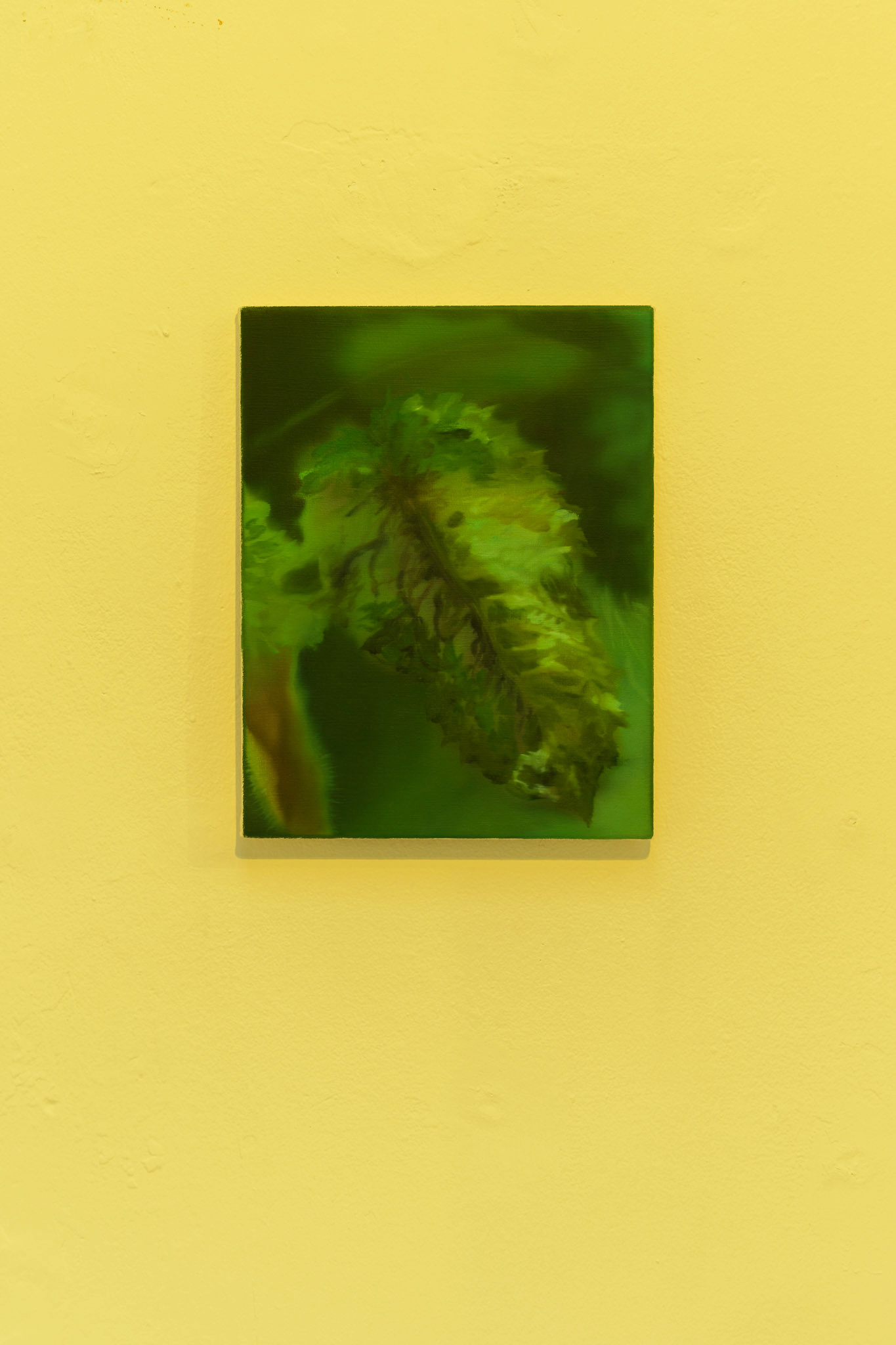




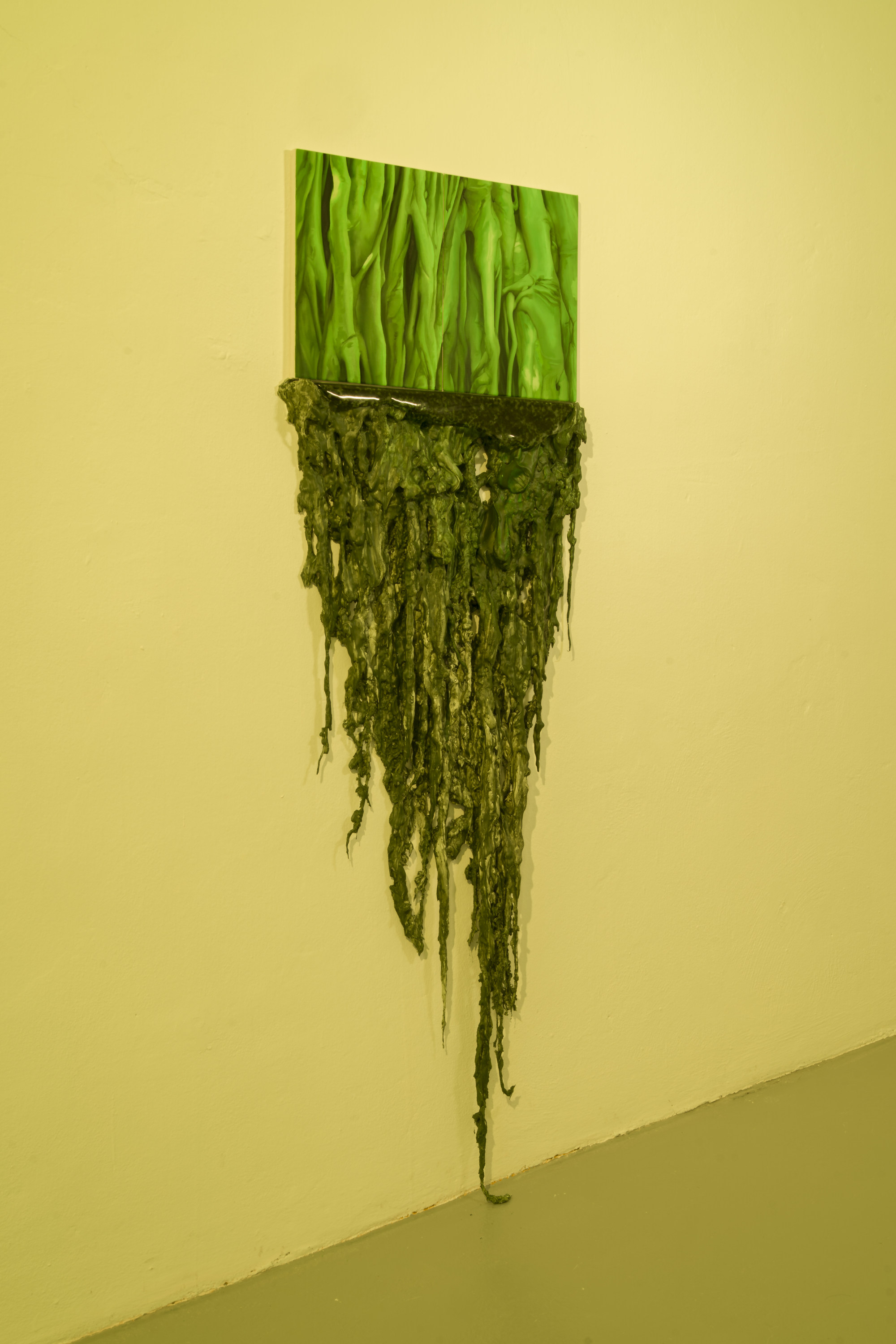







Documentation: Linda Morell





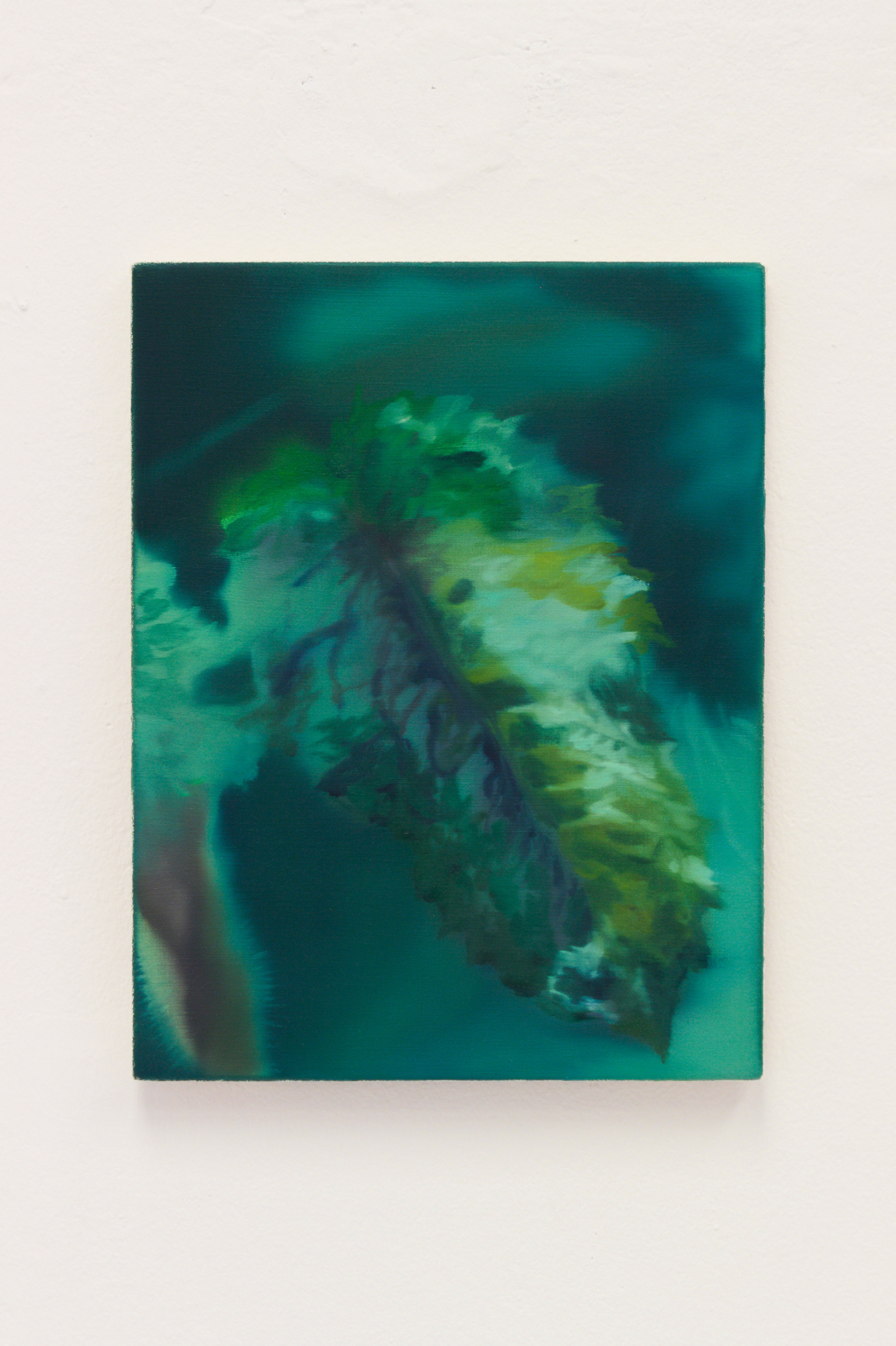

Oil nebula
Oppland Kunstsenter, Lillehammer, 2022
Vestfold Kunstsenter, Tønsberg, 2022
S12, Bergen, 2023
Documentation: Øystein Thorvaldsen, Linda Morell
The exhibition Oil nebula uses the concept of the abyss, the vast cosmic sea as described in John Milton's Paradise Lost (1667) which separates earth from hell, as a metaphor for societal collapse. The project draws parallels to the jellification of the oceans, where ecosystems are changing and new organisms thrive. Inspired by the increasing prevalence of invasive species and environmental changes, the exhibition consisting of works in ceramics, glass, wood and aluminium strives to mythologize the defamiliarized earth. The works form a visual language which speaks about the future of the oceans and humanity whilst forming the inhospitable sea of the abyss itself. Like Milton’s abyss, simultaneously described as the worlds cradle and it's grave, the exhibition becomes an ouroboros focusing on both the perils and prospects of the future.


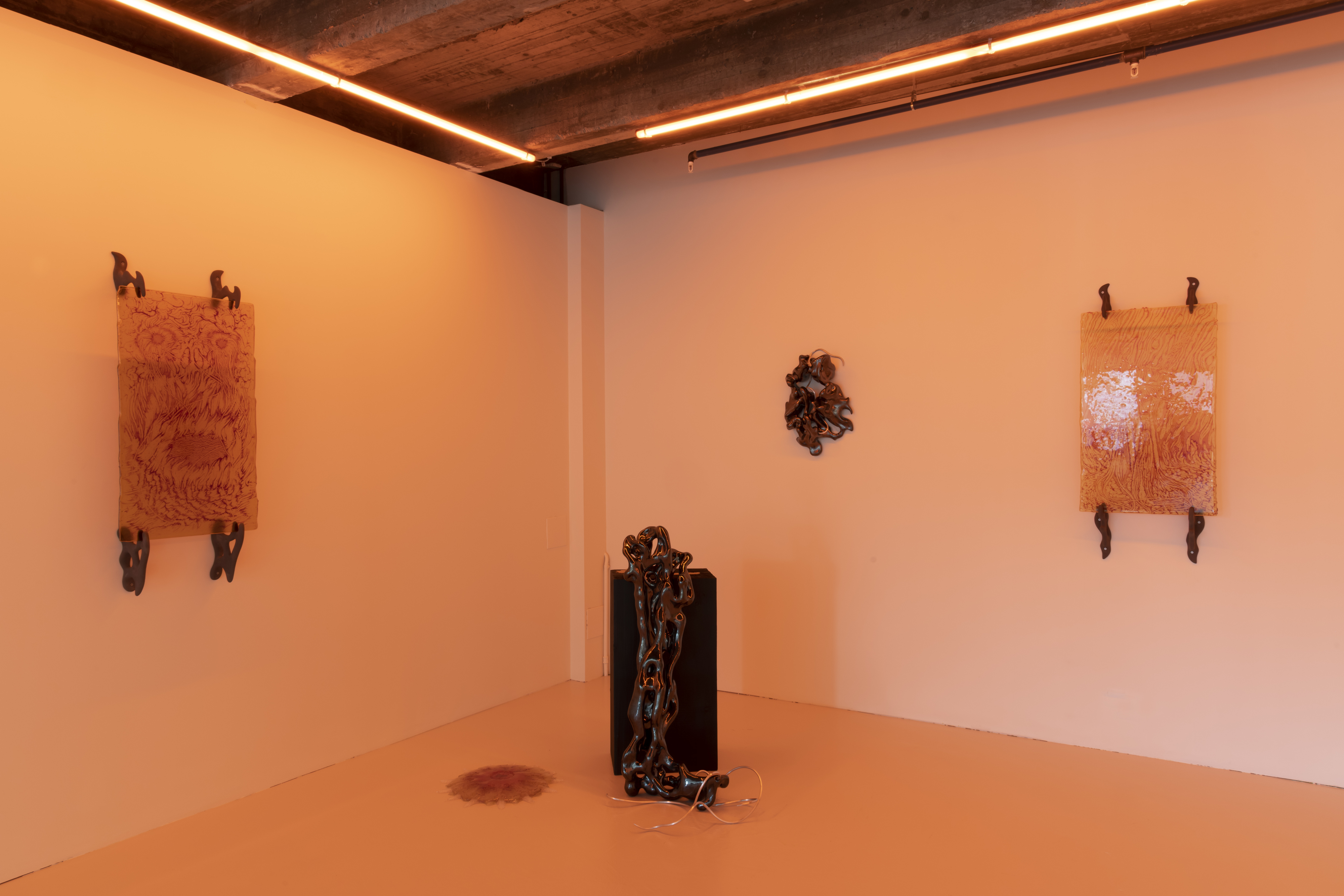




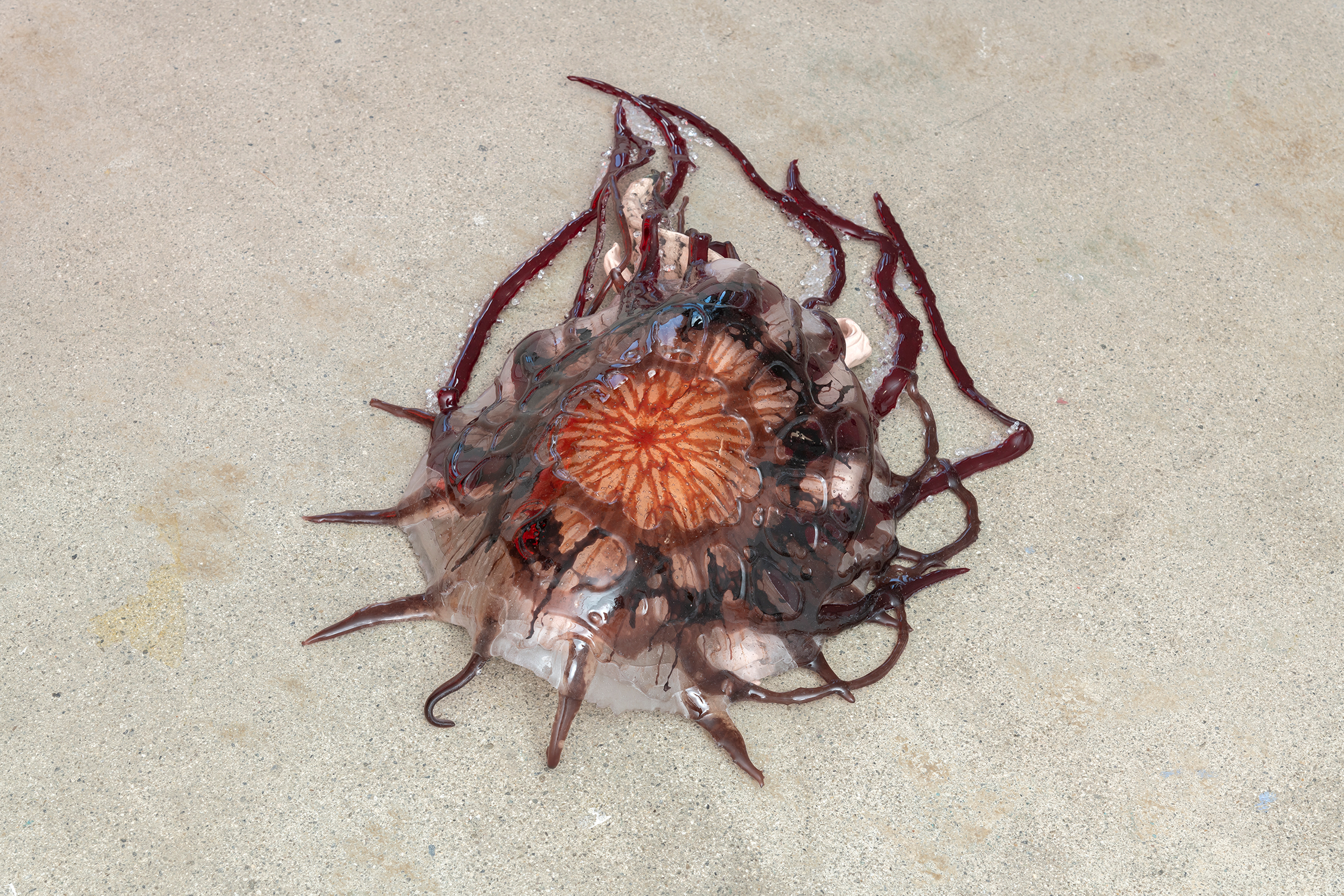
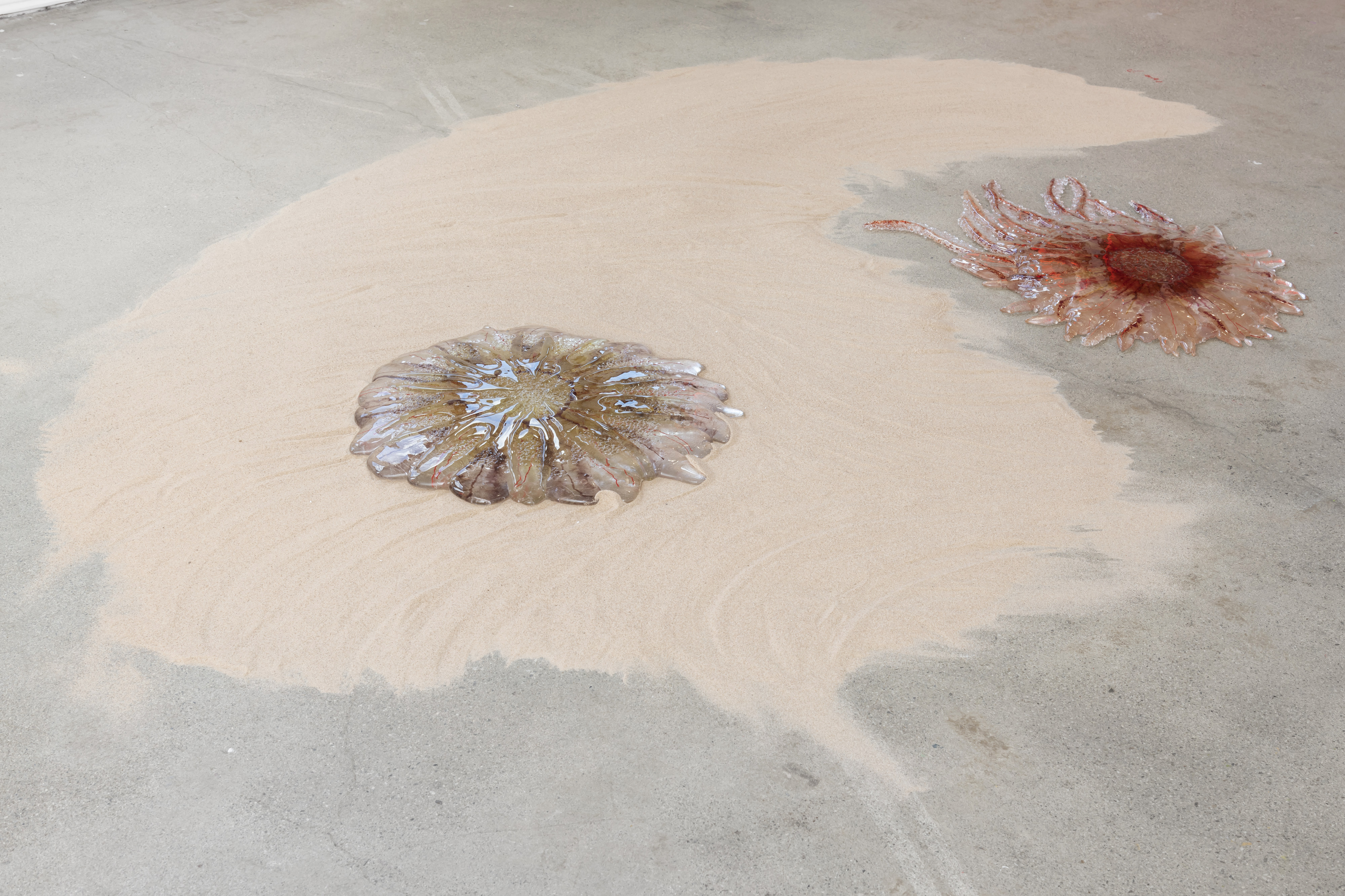


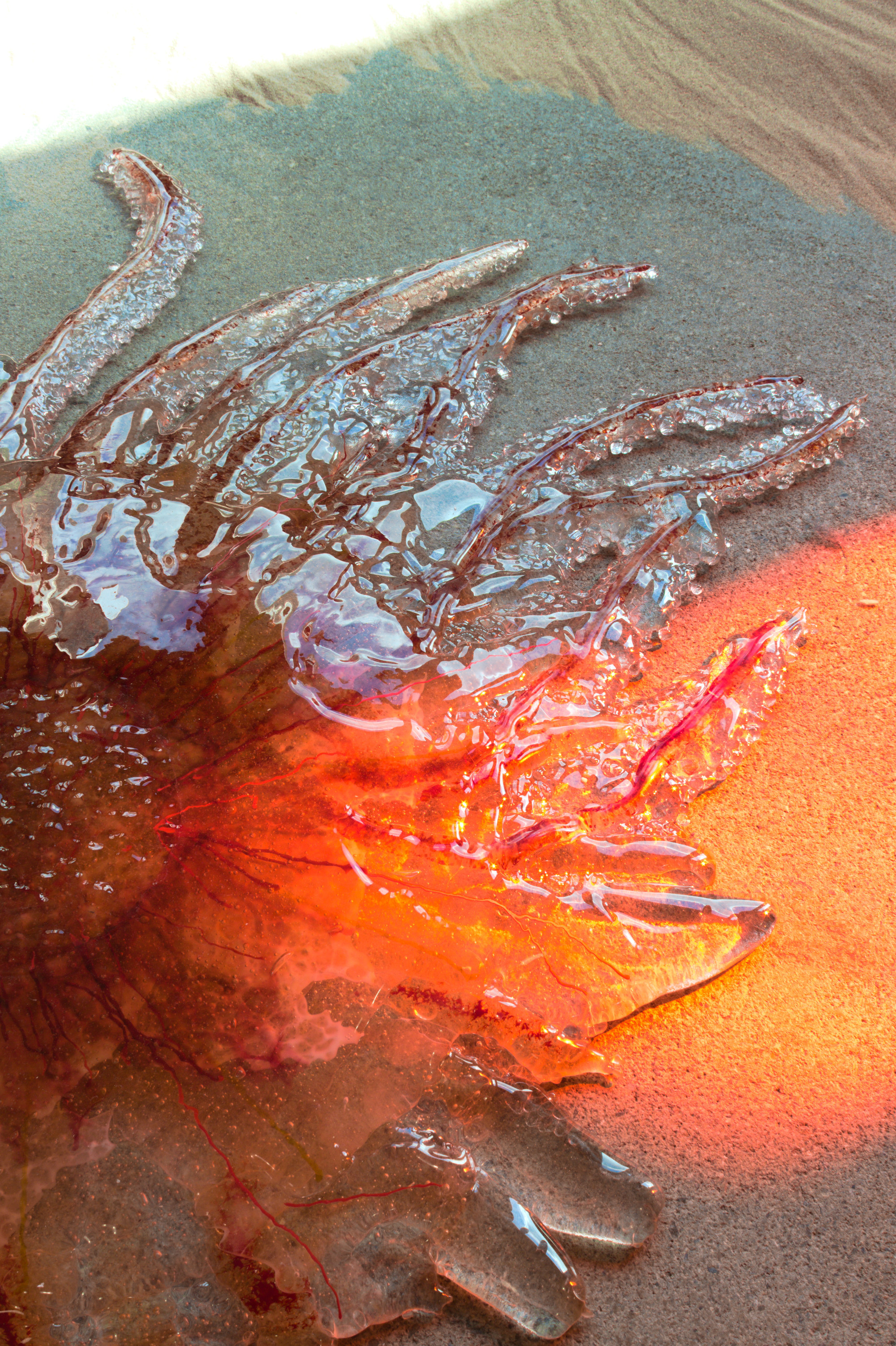



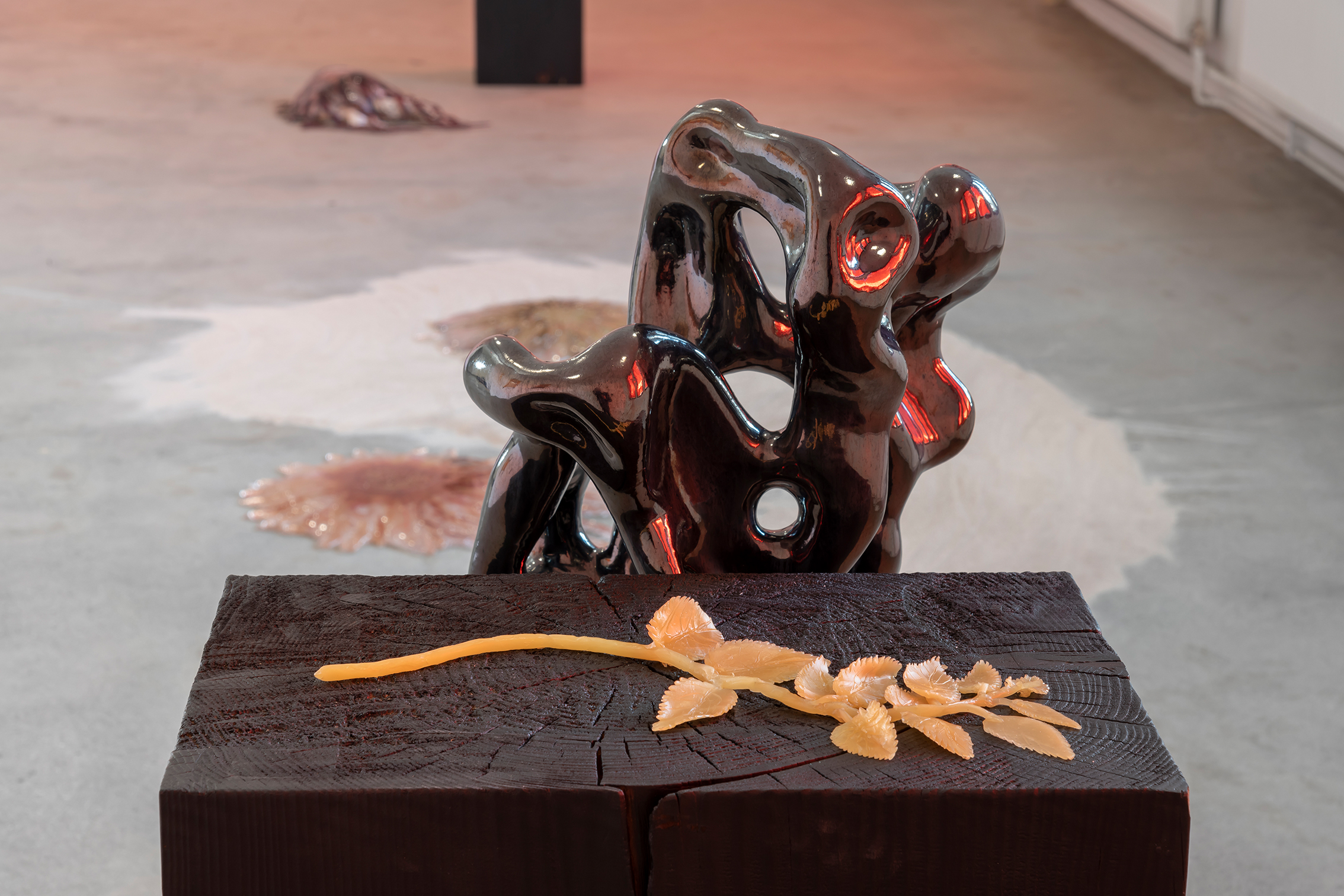


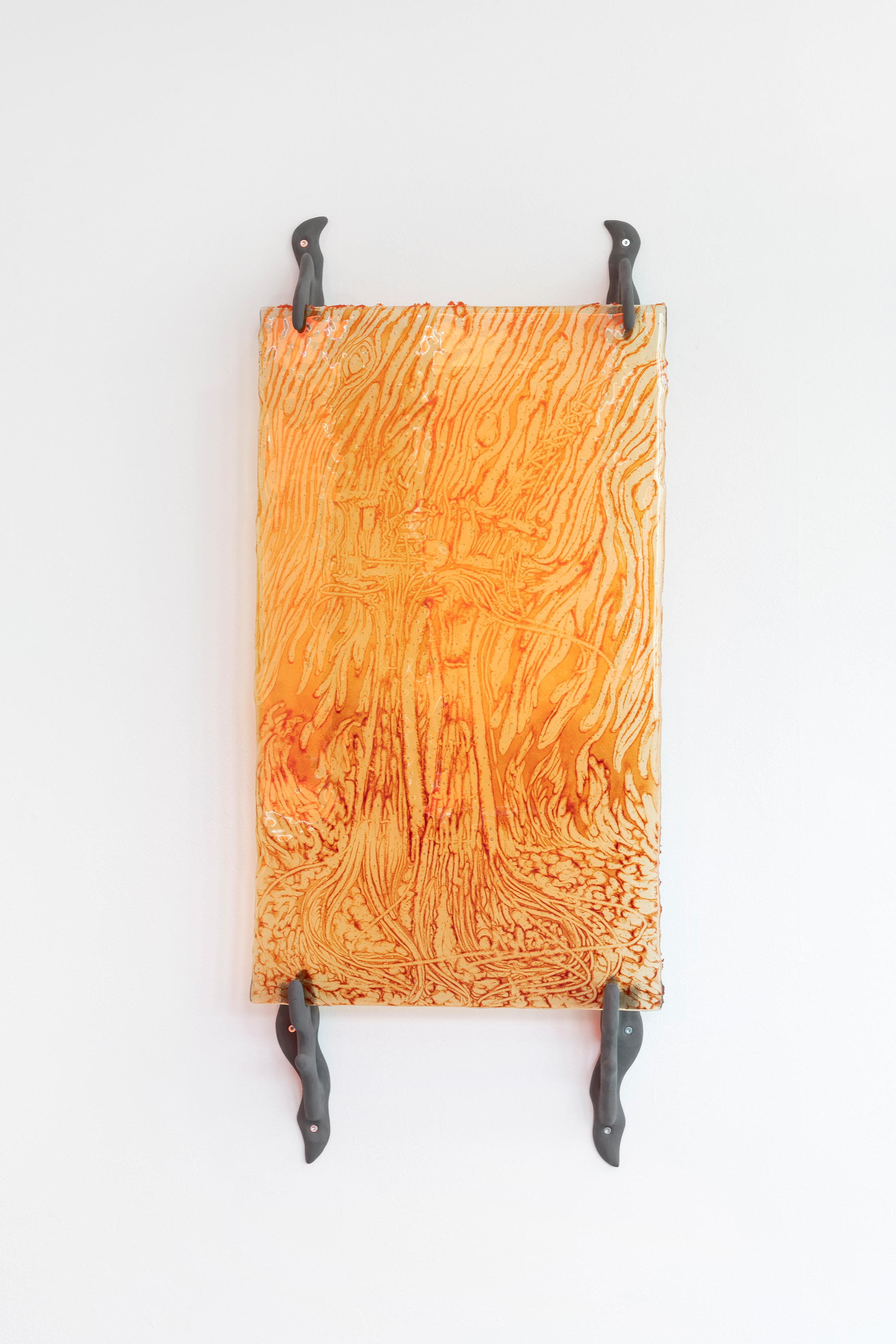
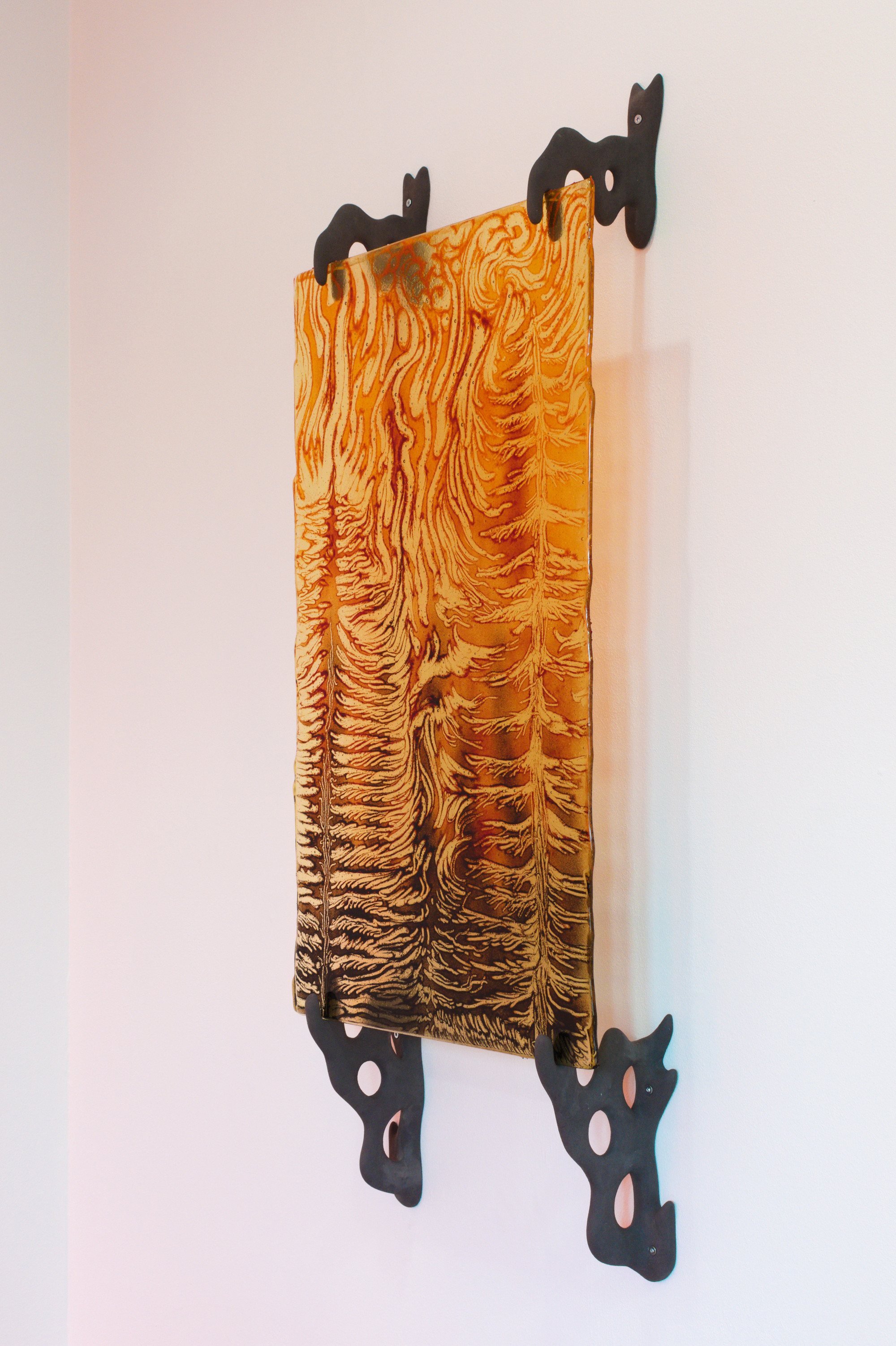
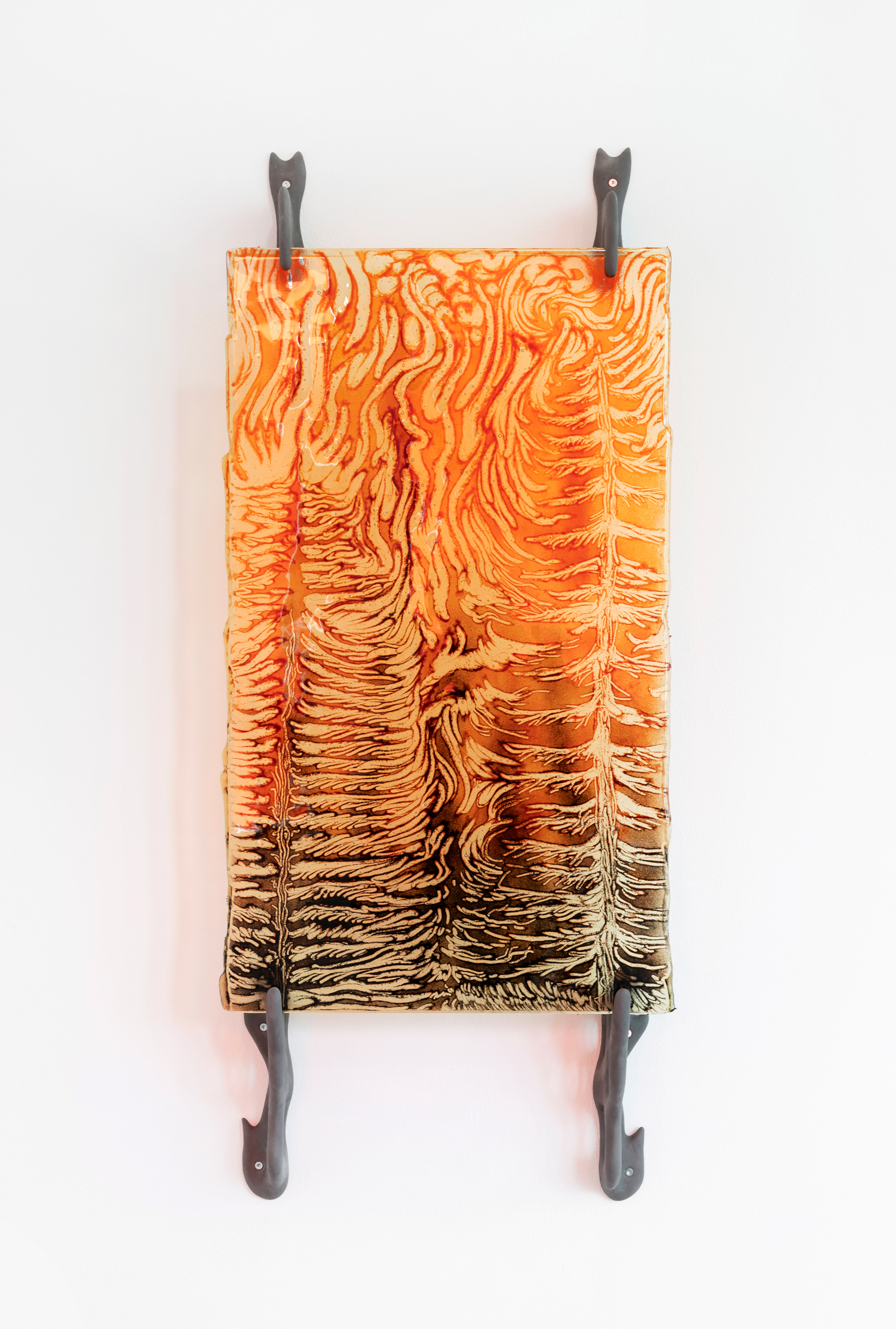
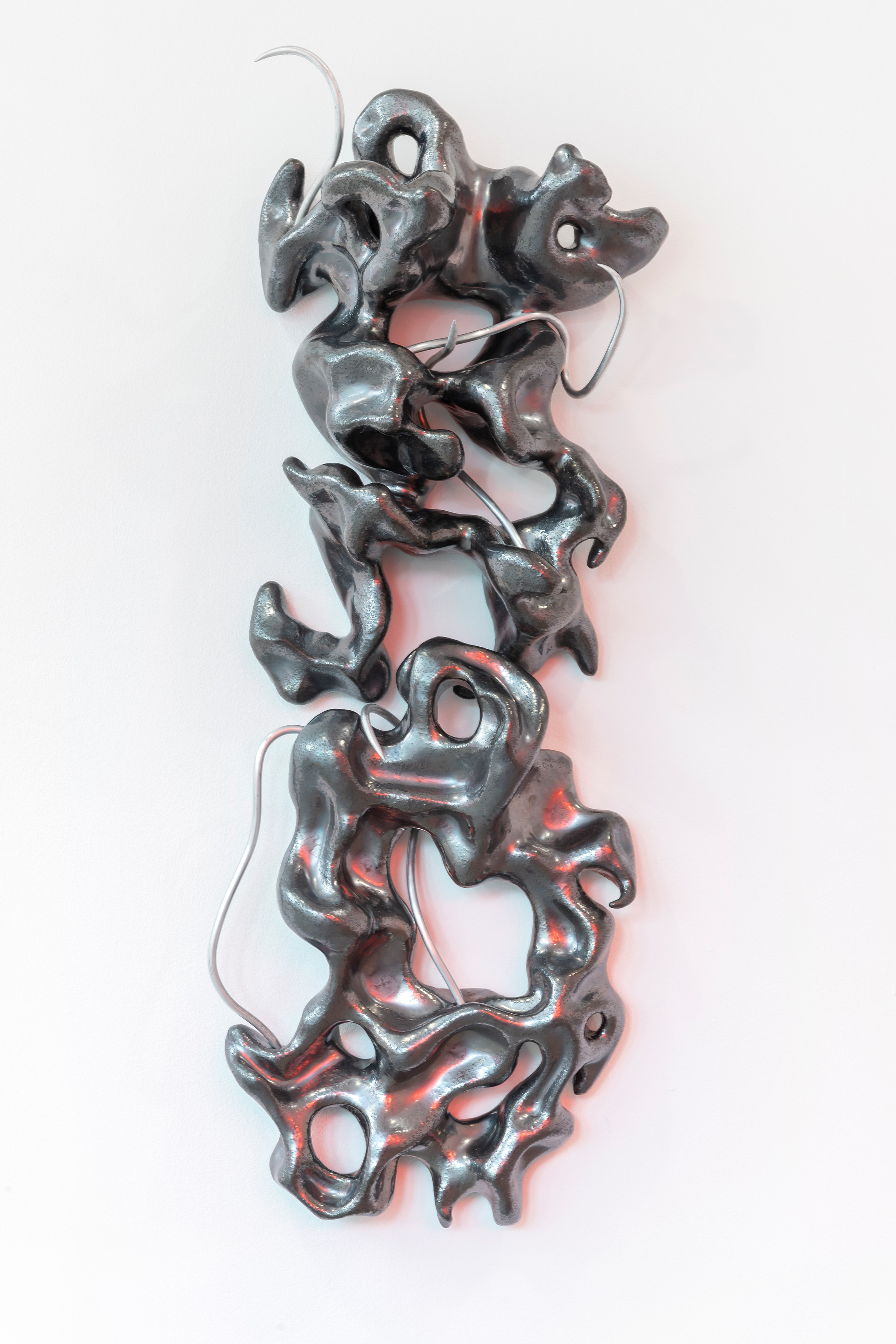

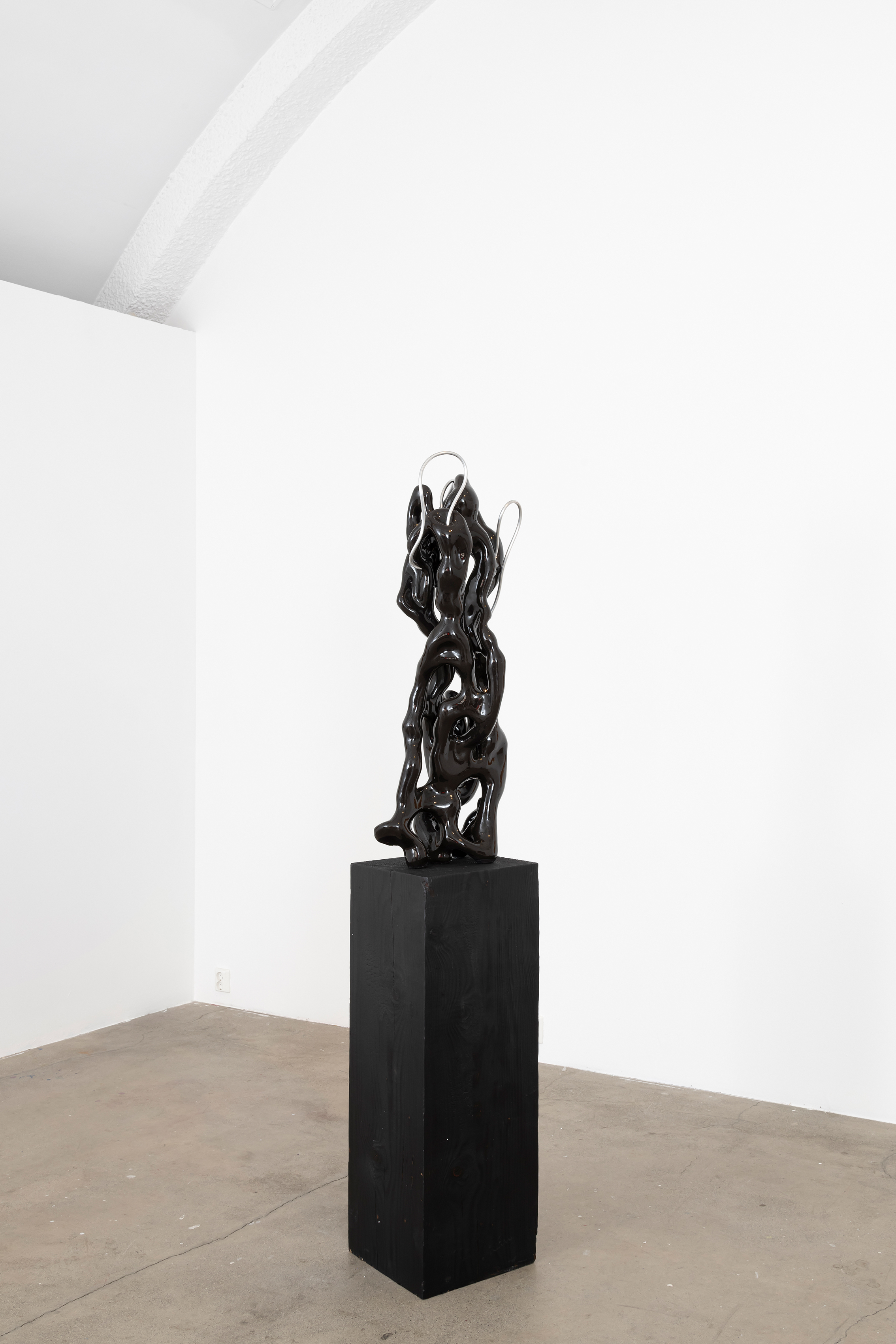

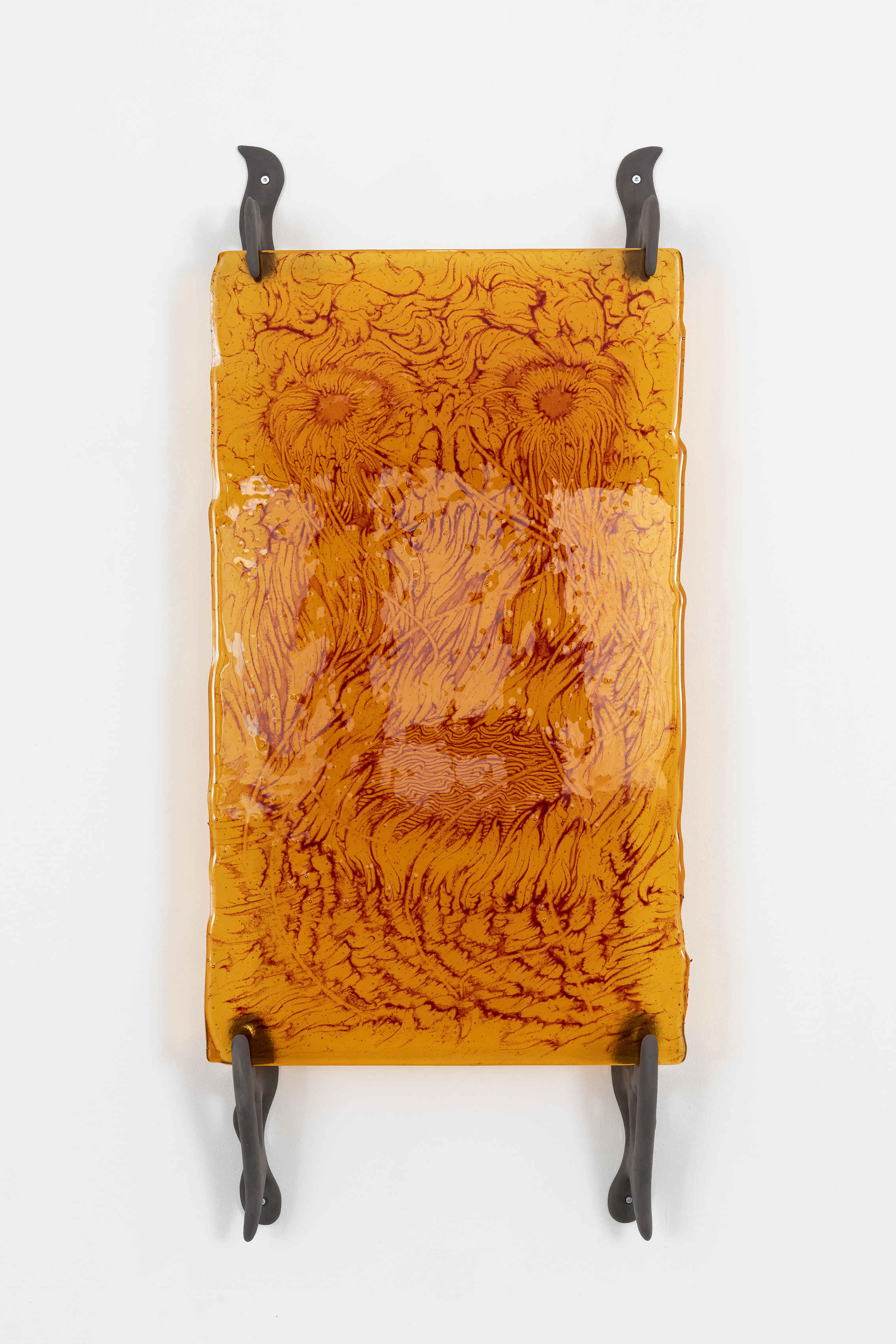
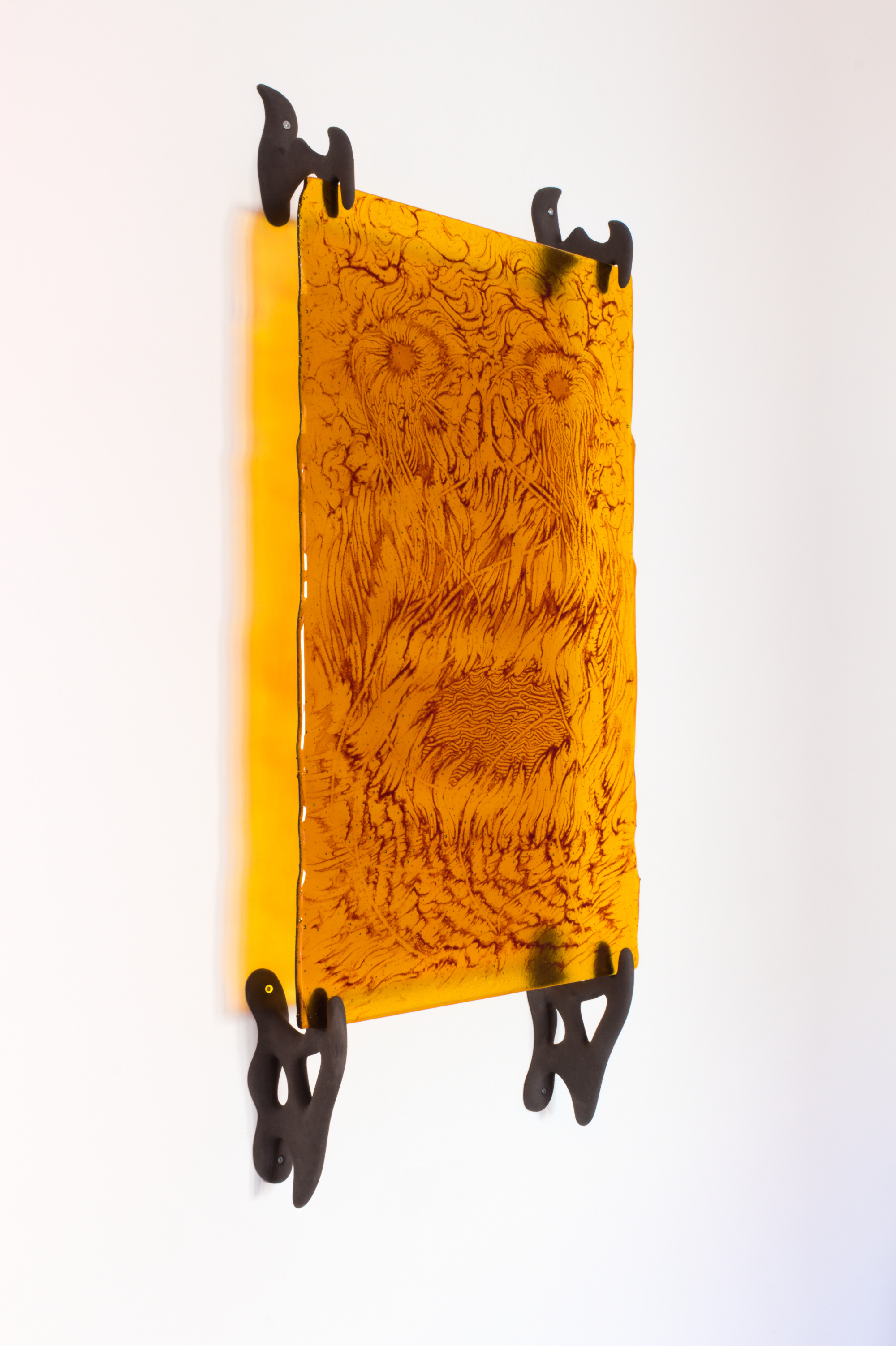
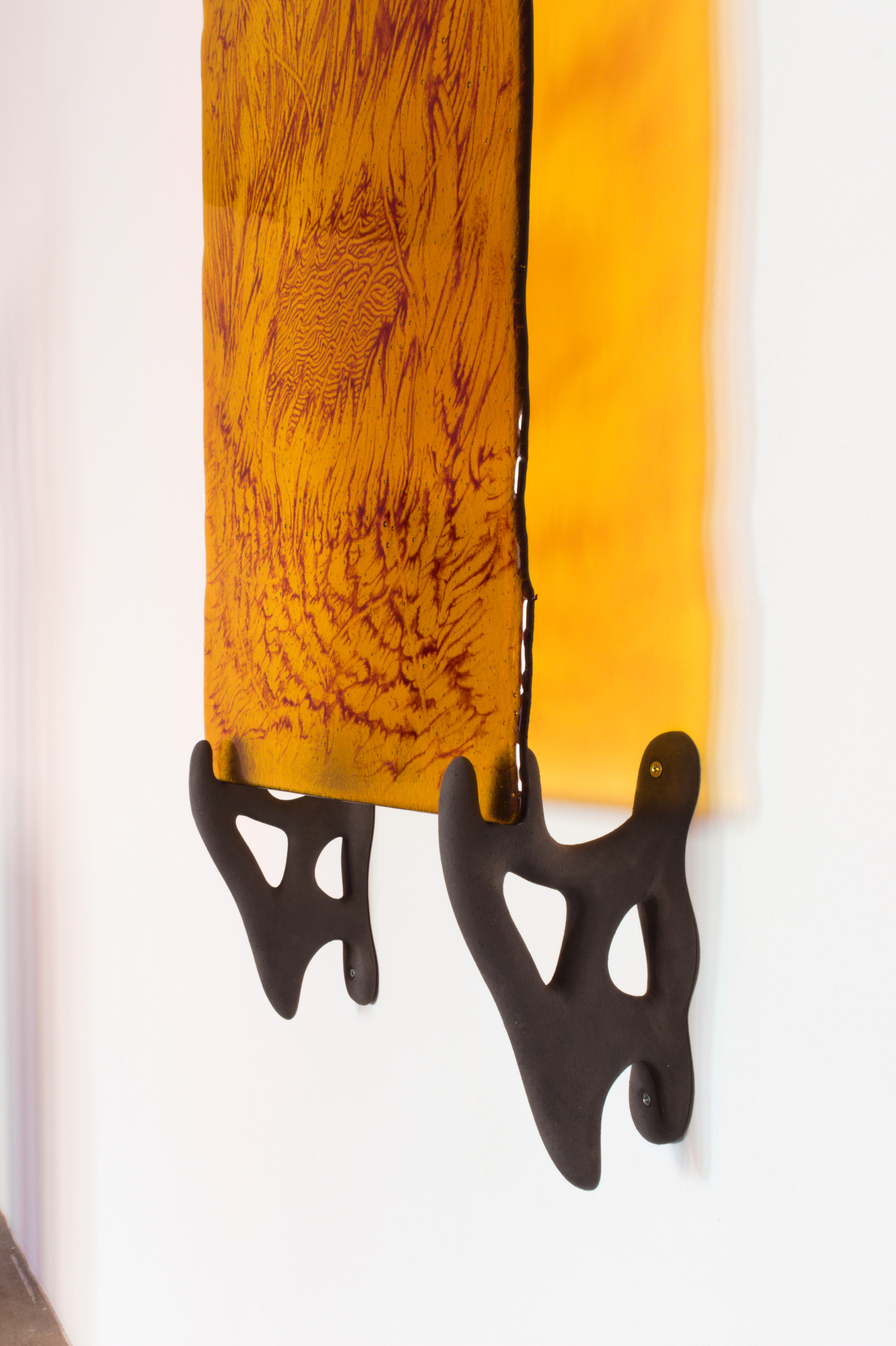
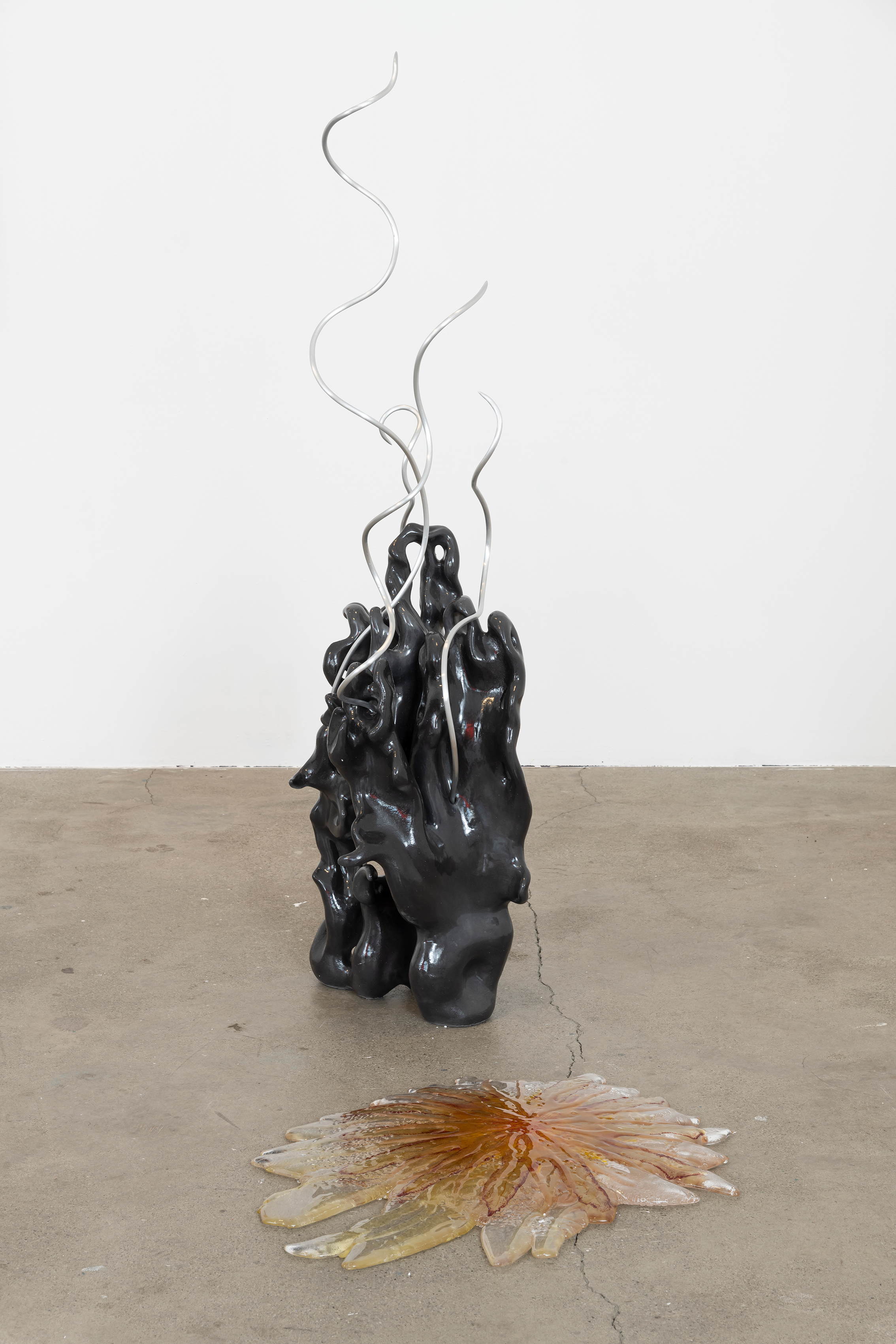
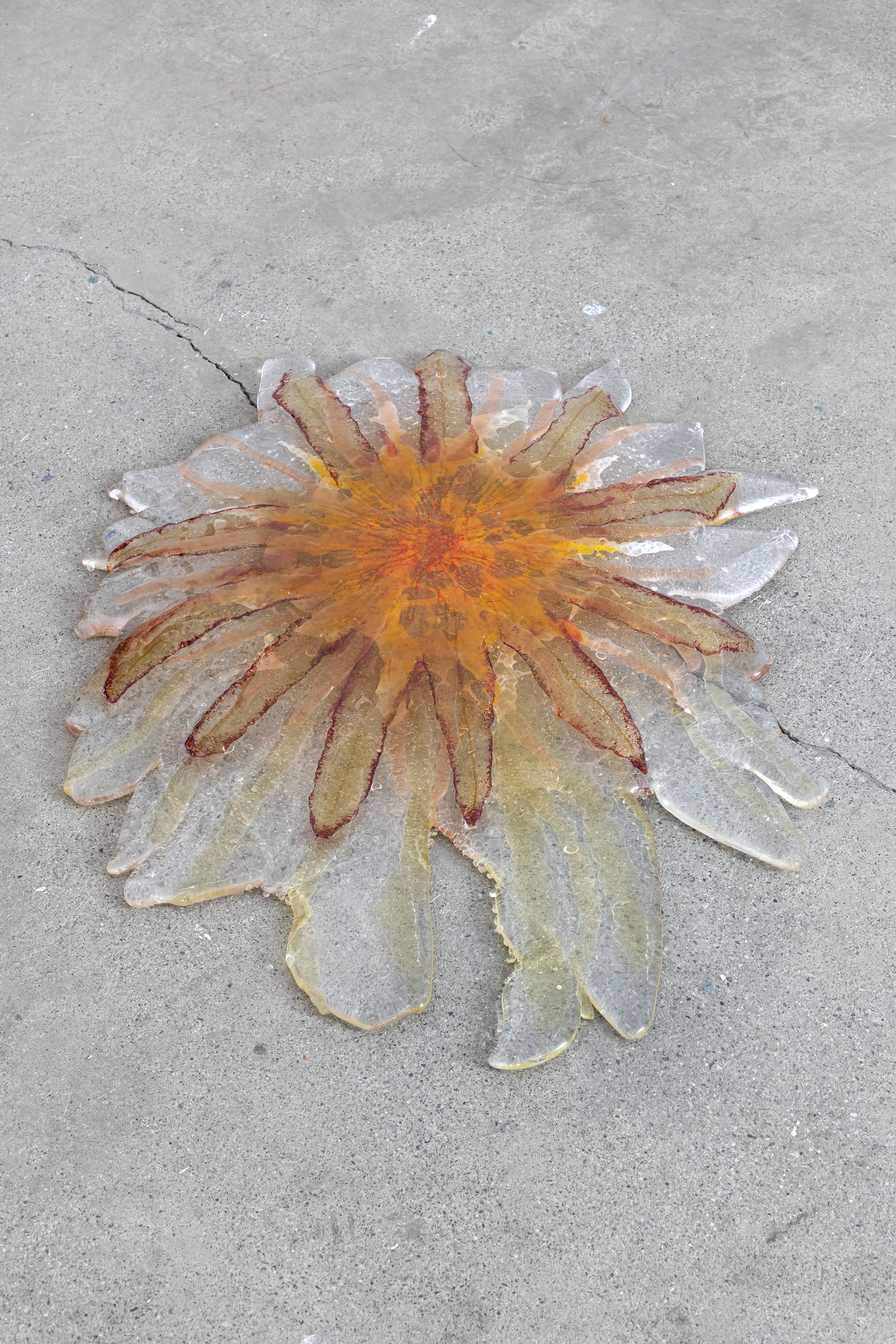
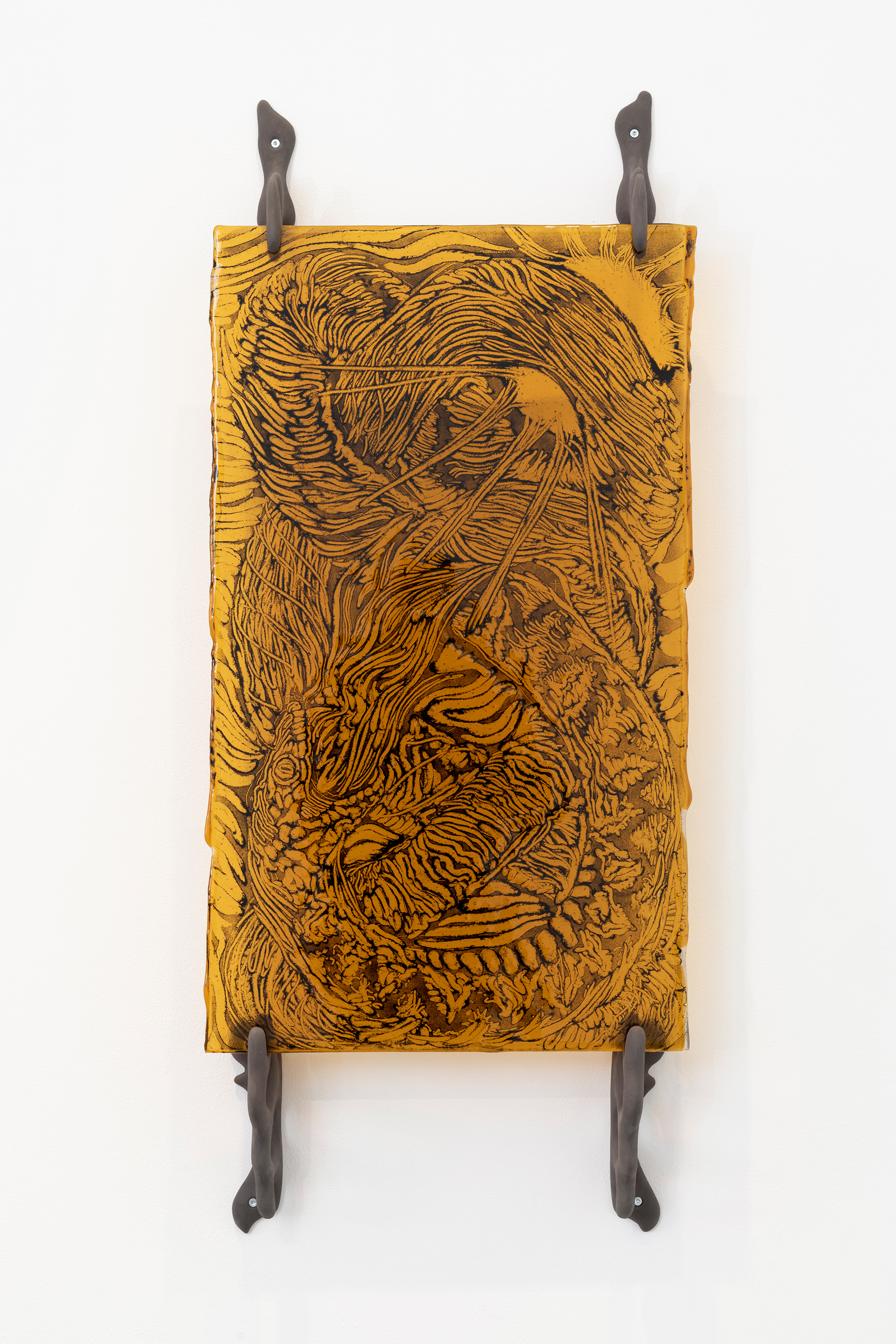

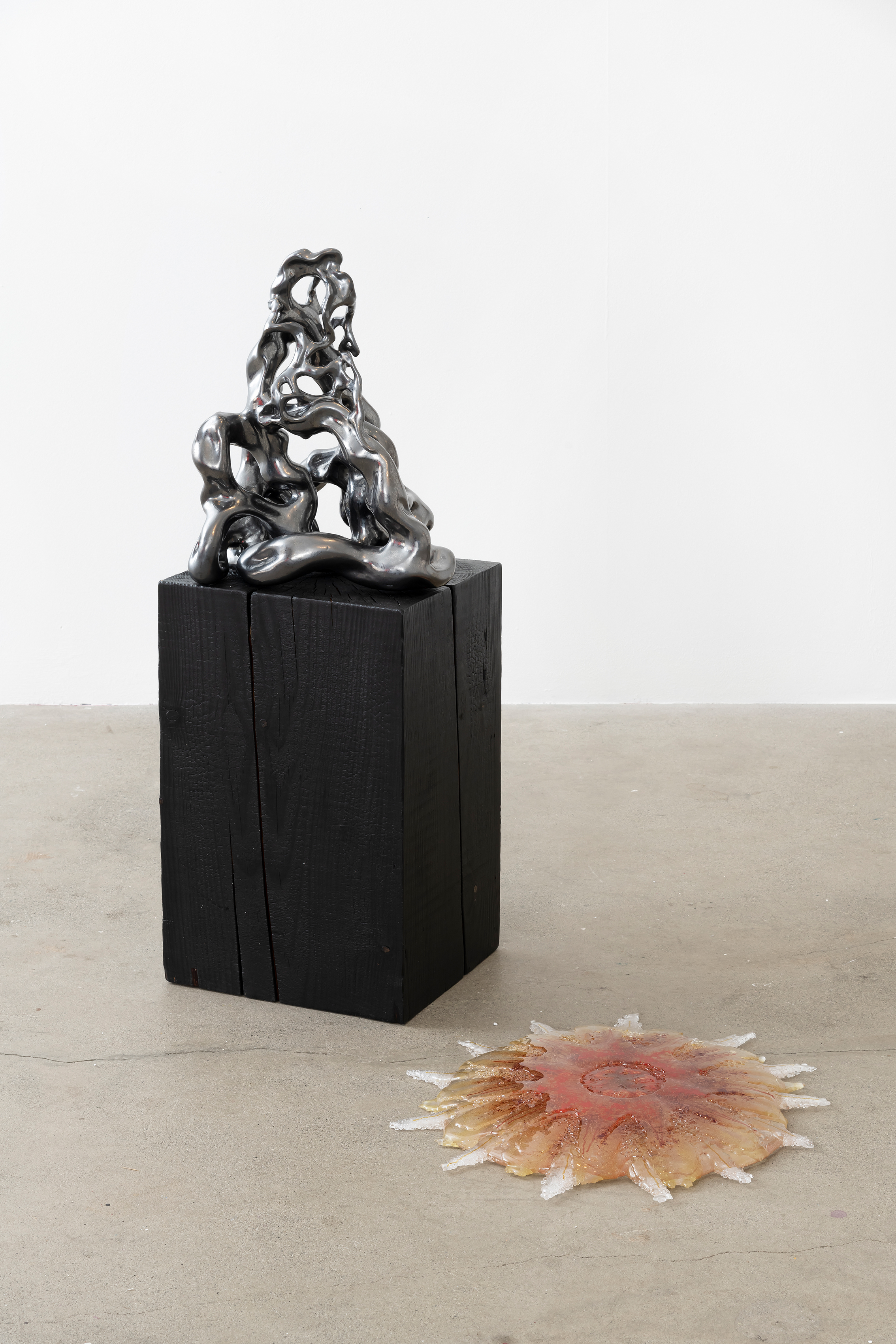
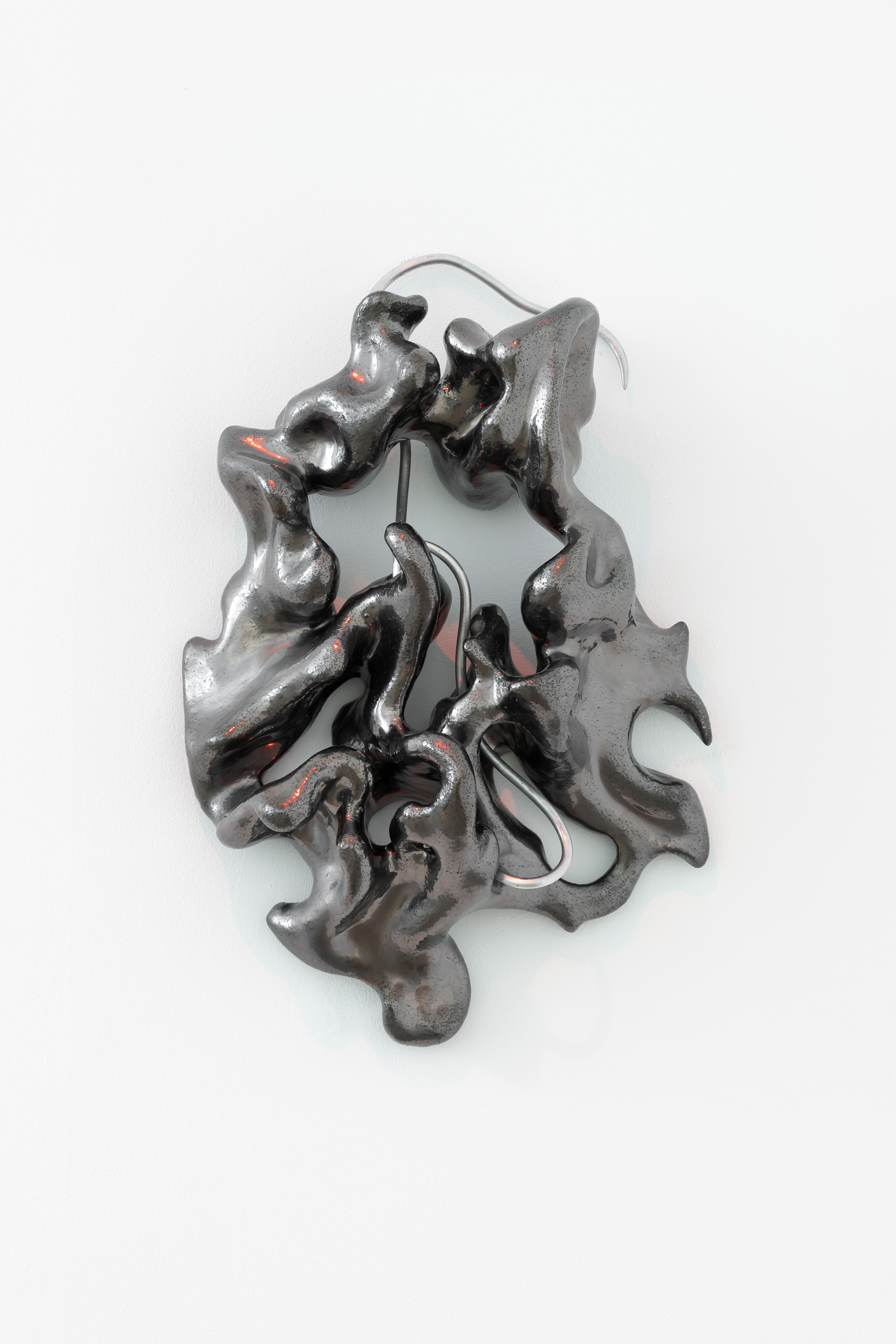
Miasma Protoplasma
25. June – 25. July 2021
Aldea, Center for Contemporary art, Design and Technology, Bergen
Documentation: Dale Rothenberg26. August – 19. September 2021
BO, Oslo
Documentation: Adrian Bugge11. march 2022 — 10. april 2022
Platform, Stockholm
Documentation: Lou MouwCurator: Cameron MacLeod
Text: Anthea Buys
Review: Hygienens attraksjon, Victoria Durnak, Kunstkritikk
Interview: I en sammensmelting av maskiner og anatomisk uro, Hedda Grevle Ottesen, BO
Miasma Protoplasma describes a parallel existence where historical ideas about disease and contagion manifest as an alienated environment. Referring to the miasma theory, which explained airborne disease before the paradigm of microbiology as a death bringing mist and disease carrying air, the show consists of sculptures assuming the form of bloodsucking animals and cyborg associative objects. The works explore handmade processes and traditional sculpting mediums in relation to digital sculpting, combining materials like aluminium, various 3D-printed filaments, blown glass, casted concrete, CNC-milled wood fibre, hand built ceramics and manufactured neon. By combining physical and virtual sculpting the works use disparate models of object understanding as a method of addressing the body in relation to an invisible health threat and uncertain environment; navigating through overlapping theories and conflicting constructs.
Flash fiction written for the exhibition by Anthea Buys:
The RoomOn the seventh of fourteen sweaty nights – the heatwave was unrelenting – I found the room you’re standing in now. It wasn’t empty, but it wasn’t full either. Eight objects lay on the floor in the dark. It was my job to find one of them, although I didn’t know which.
The room, as you know, is in the basement of what might have been the town’s hospital. Like the churches and the grocery stores, hospitals belonged to a bygone time, a time out of joint with the present we know.
On the first and second floors rows of metal bed frames still line the halls. The later hospitals all favoured this layout, itself a revival of the field hospitals of the twentieth century’s great wars, because by that time the notion of contagion was largely irrelevant. Everyone was already sick. Everyone had made everyone else sick. They – the doctors, the politicians, the people – had just begun to accept that bespoke medical attention was an outdated, even fanciful notion.
Today these halls are materially homogenous, braids of concrete, metal and plastic. The mattresses and bedding belonging to the rows of beds have long since vanished. Every few beds there is a tree-like metal stand whose hooks sometimes have empty plastic sacks hanging from them. Tiny needles lie in clusters where the floor meets the walls as if swept there, perhaps at the time that the landfills were declared full, which was about the same time as the incineration of medical waste was banned.
The higher floors of the building are inaccessible. The elevator shafts are filled with debris up to the first and sometimes even the second floor, and the entrances to the flights of stairs have been bricked shut.
The basement has the same footprint as the first and second floors, but a much lower ceiling. If you jump you should be able to touch it with no difficulty. The room is engulfed by complete and palpable darkness, darkness of the sort your eyes simply can’t tolerate, blindness. To find the objects I had to crawl on my hands and knees, although I first encountered one by bumping into it. The objects were interspersed in the environment and seem placed rather than strewn. They were all hard and cold to the touch, round in some parts, sharp in others, maybe delicate – it’s impossible to say.
When you really want to find an object you have to look with your eyes closed. So the darkness of the room was not an impediment to my search. On the contrary, it forced me to circumnavigate the visual instinct and reach instead for something postural, latent in the body, a secret communication from vessel to vessel.
After the night that I found the room, I returned to it four times, each on a separate night, each night seemingly hotter and longer than the night before. Each time I thought I came closer to finding the object, but the heat and the thickness of the air brought on in me an overwhelming fatigue and I had to stop before sunrise. By the fourth night, my body had become a fluent reader of the text of the room, and it knew with some confidence the distances between objects, their textures and volumes. But on that night, my body found the room empty. I crawled across the breadth of the room, snaking my way back and forth, and wherever an object had been there was nothing but a small cloud of cold air and a dampness on the ground.
I left perplexed. Perhaps I had simply run out of time. The heatwave ran its course and I didn’t return to the room.
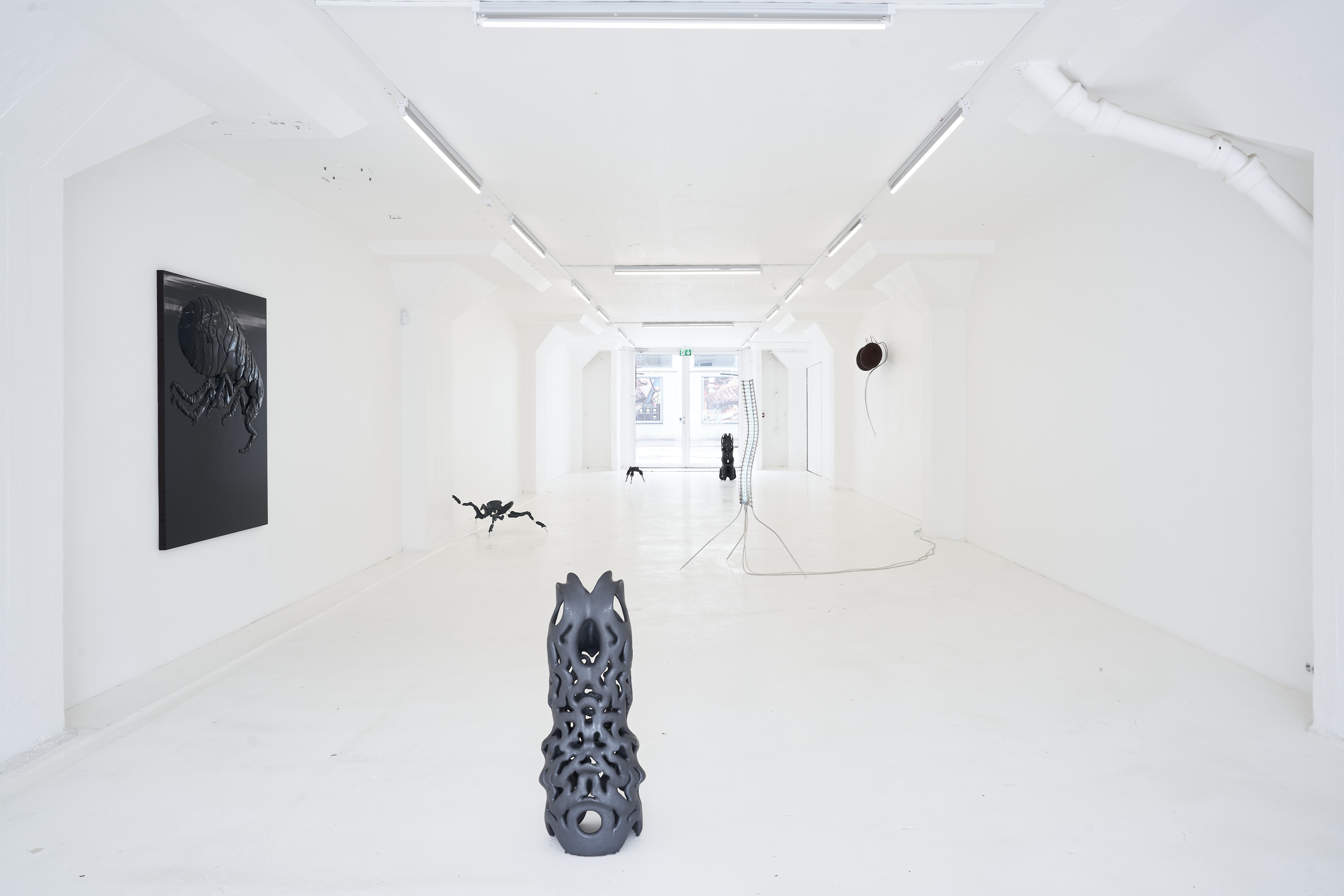
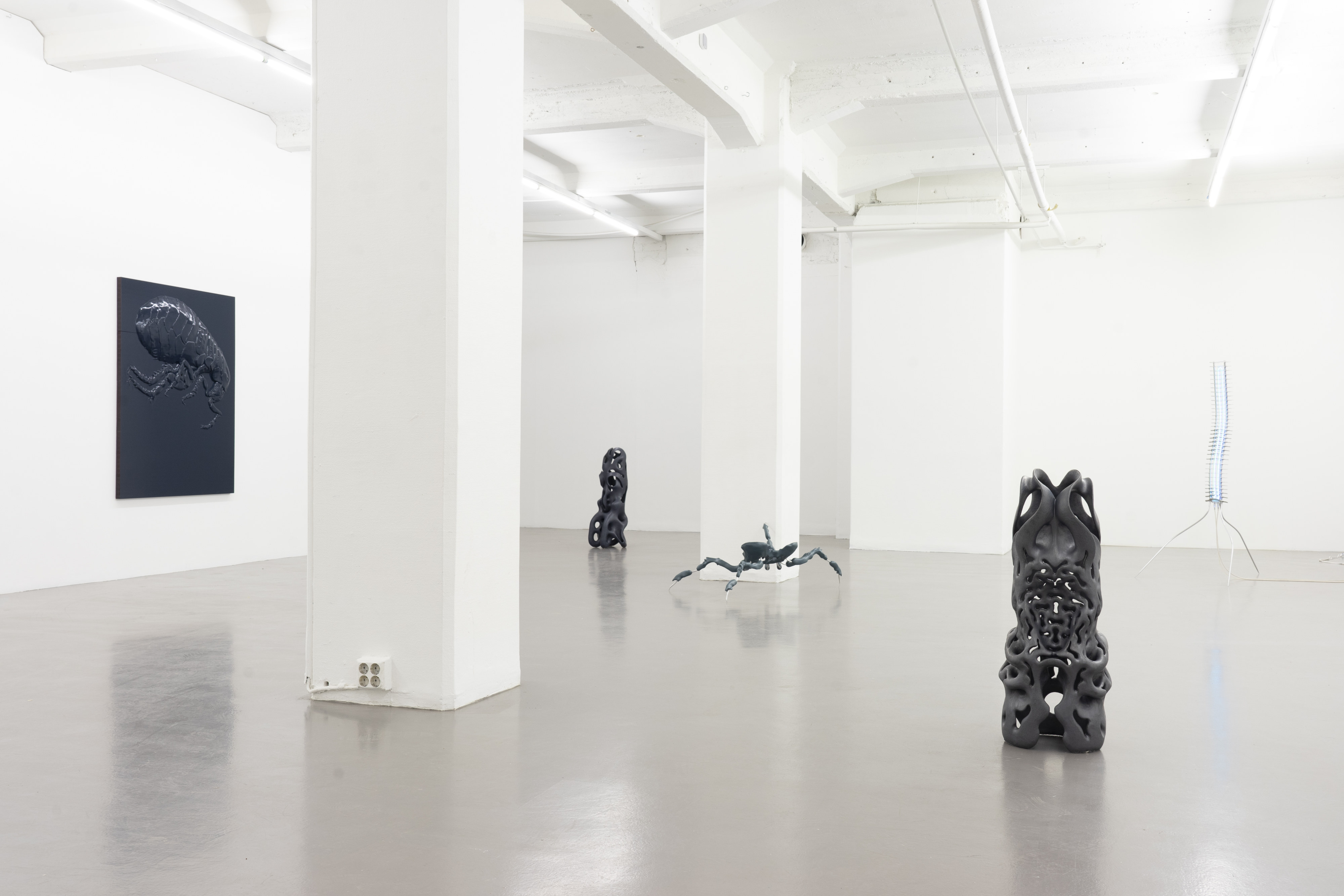

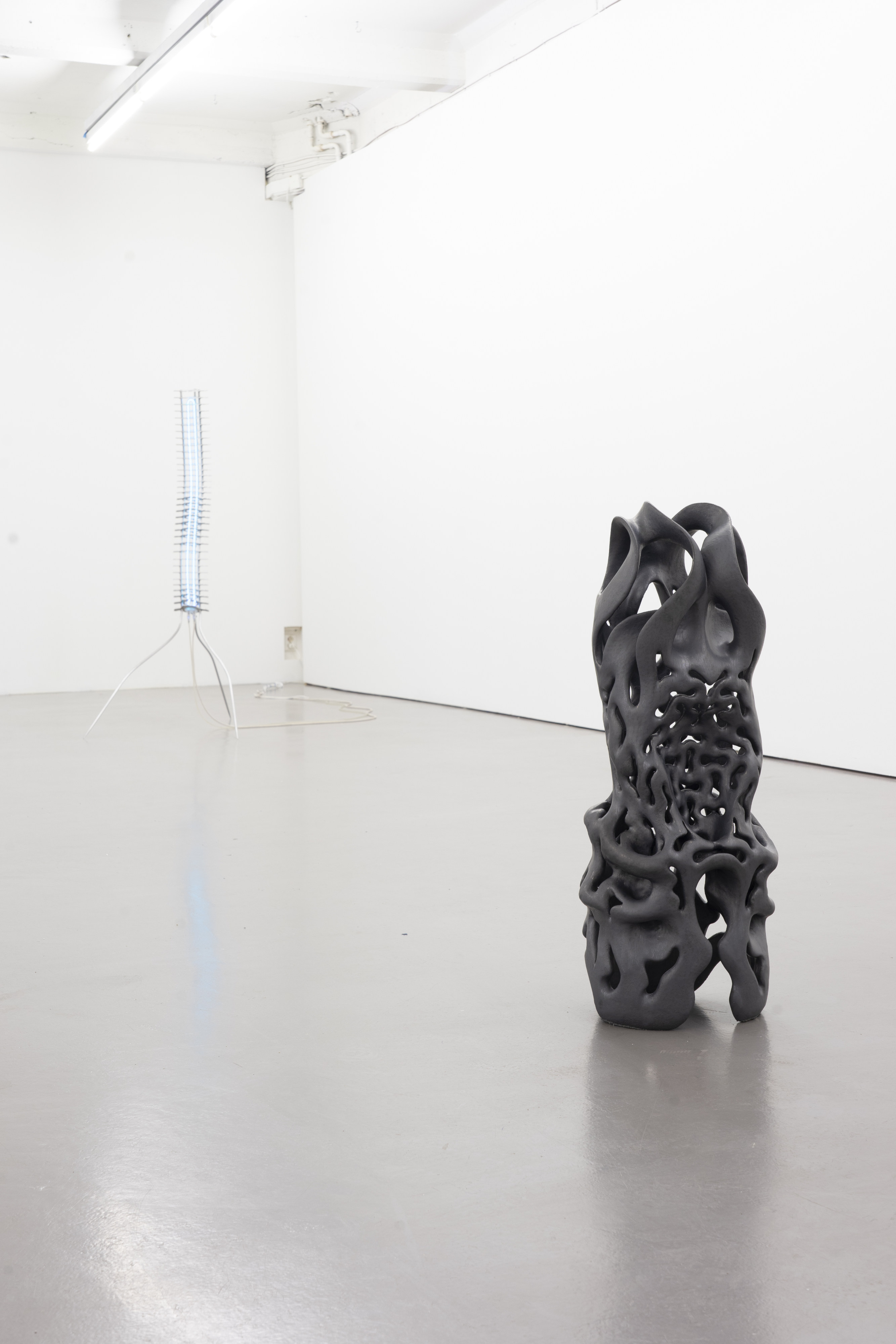


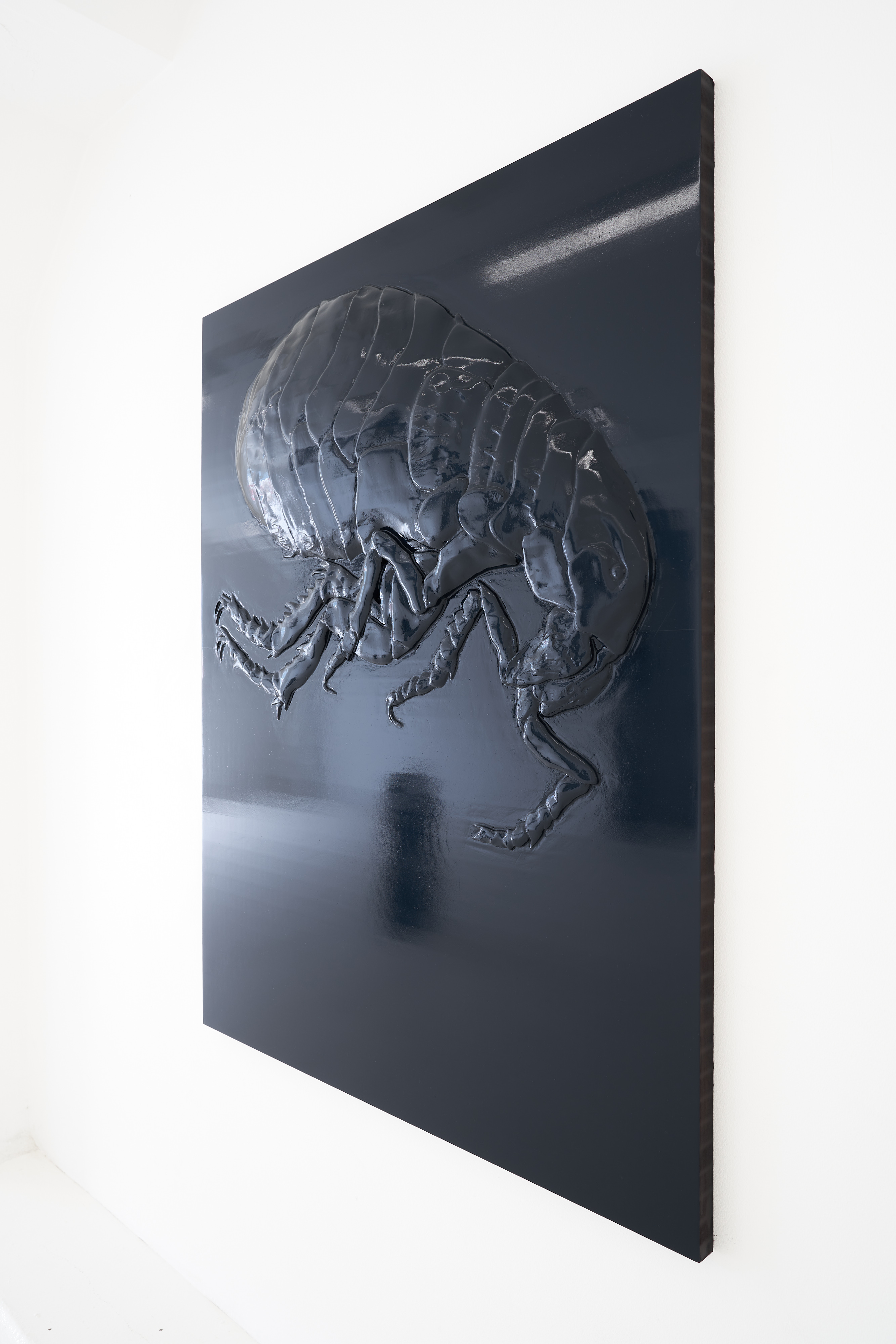
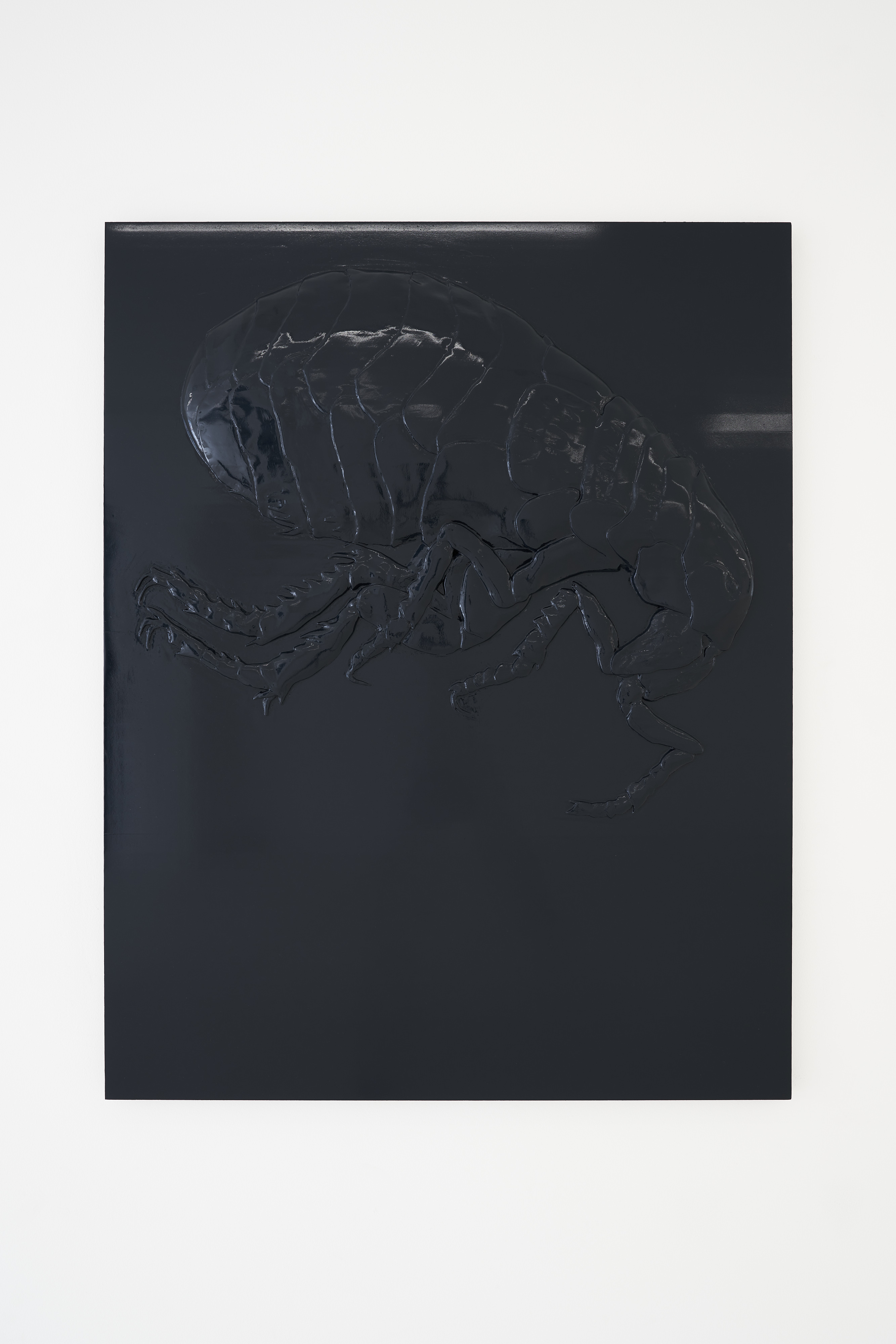


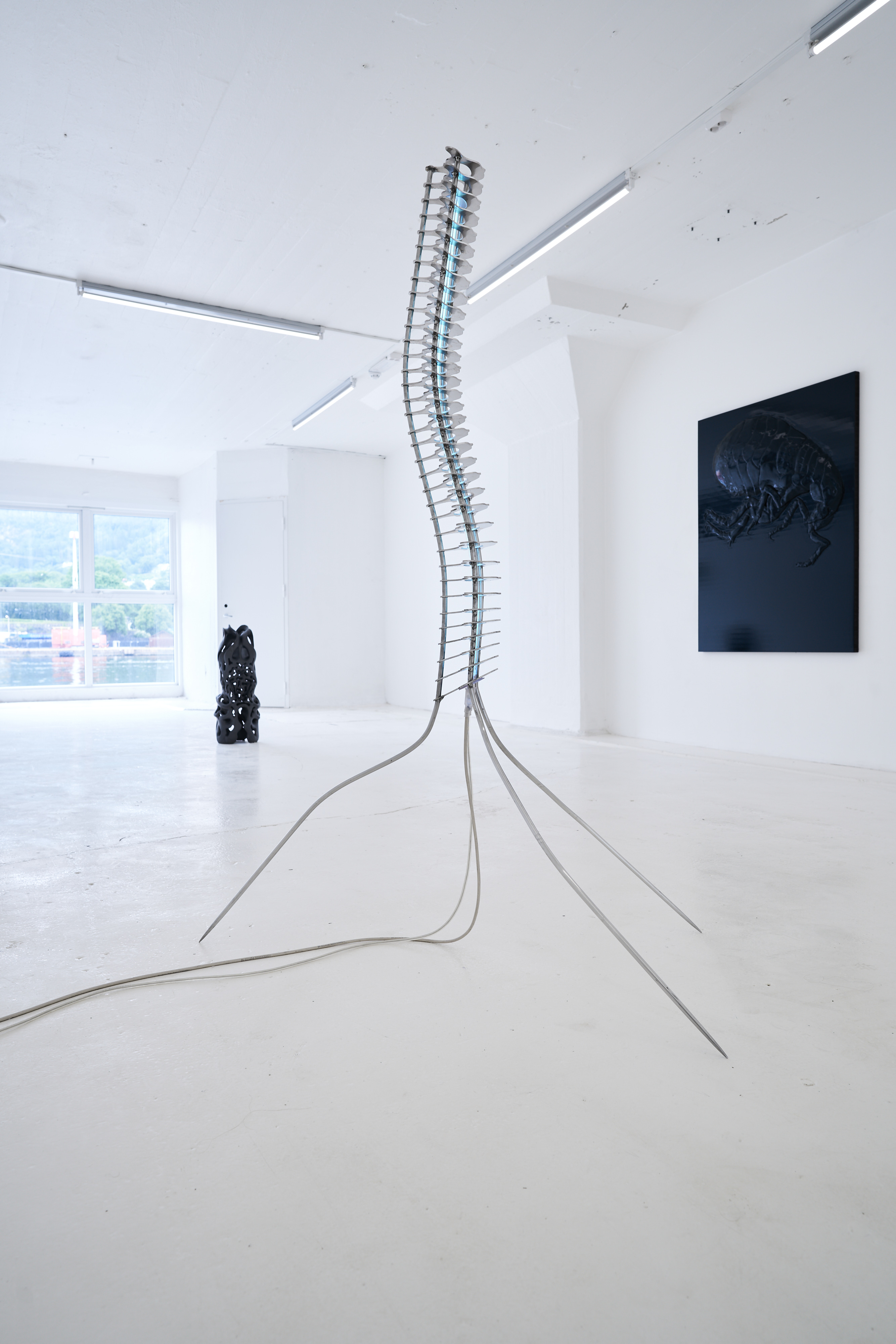
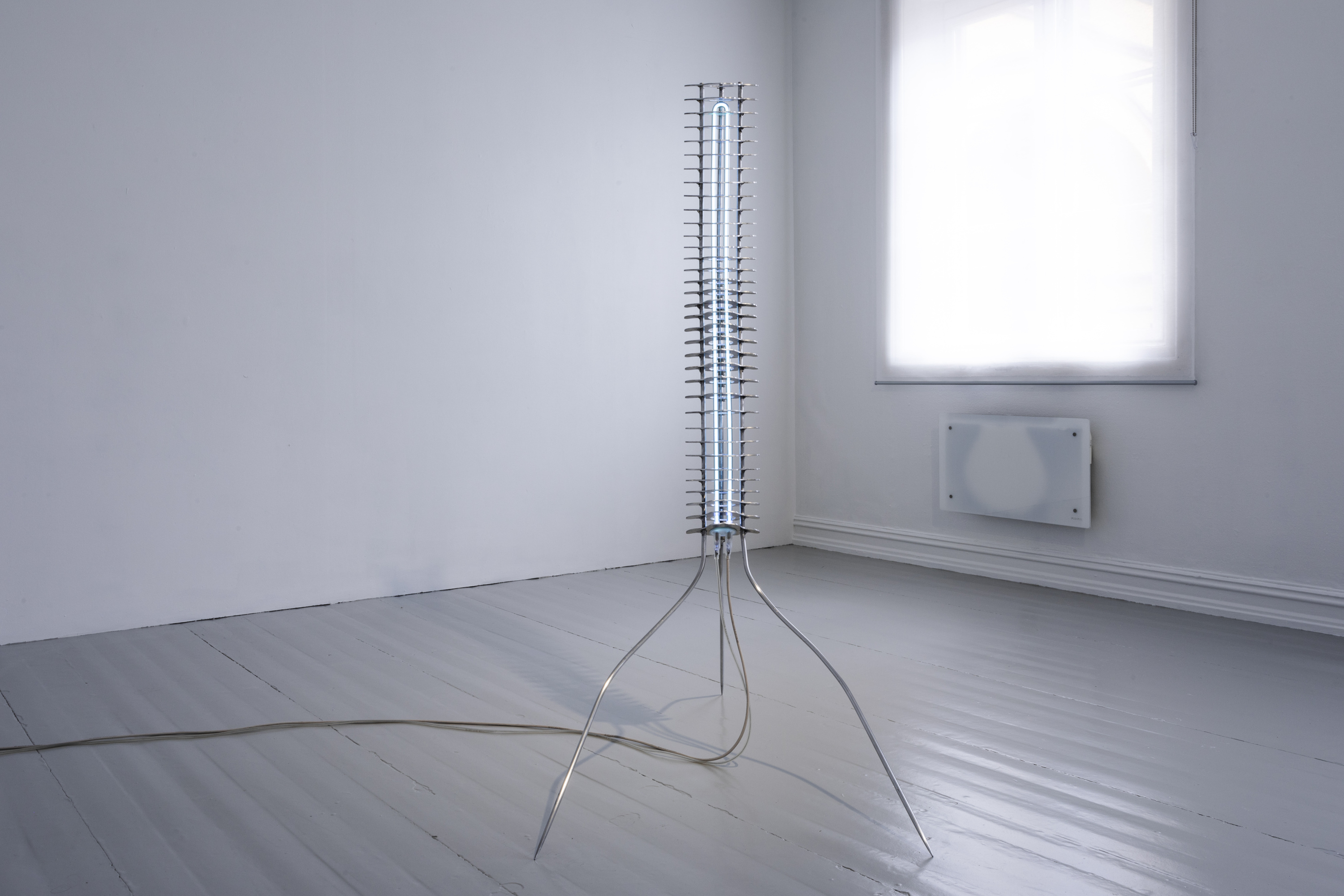
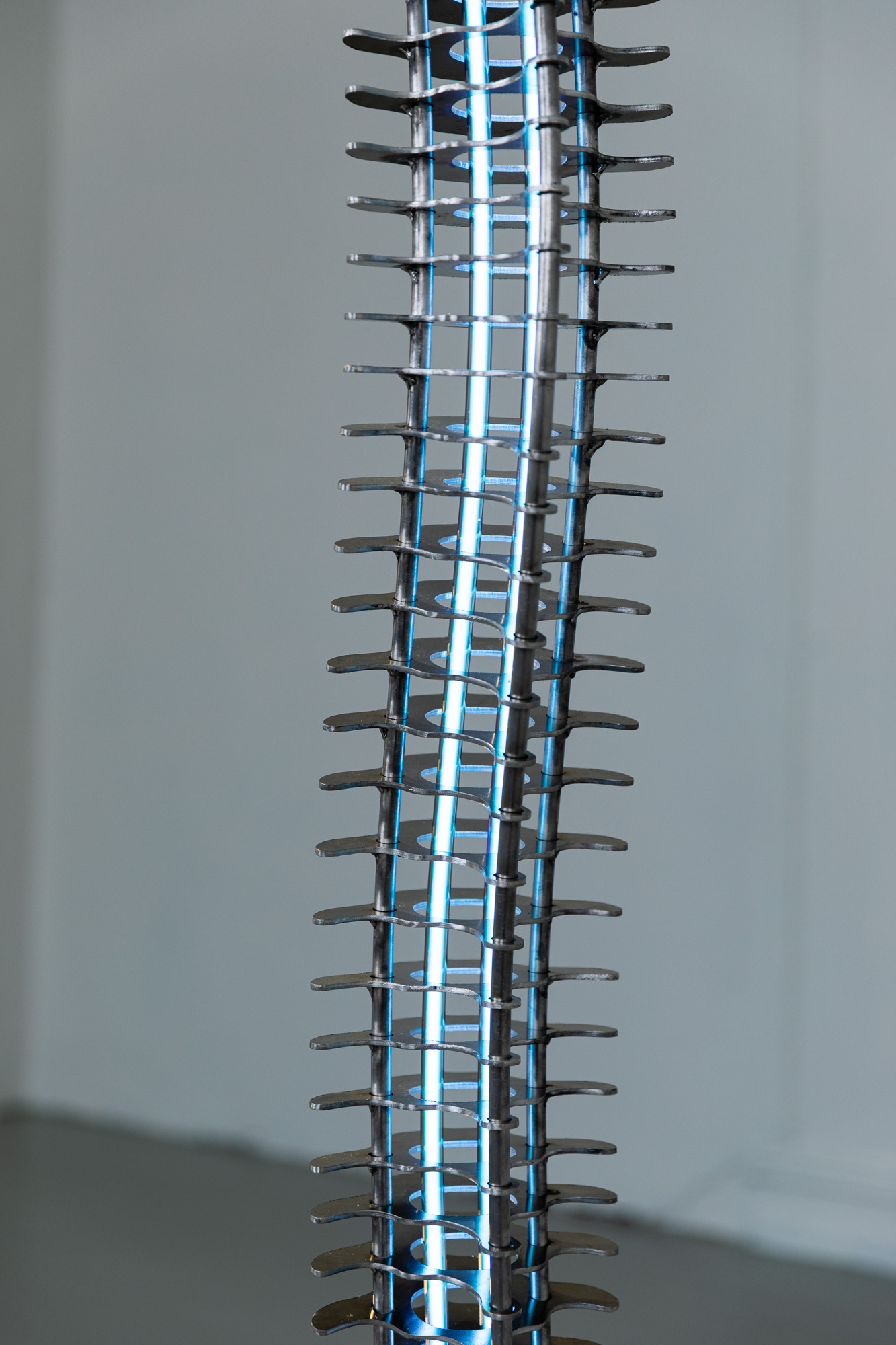
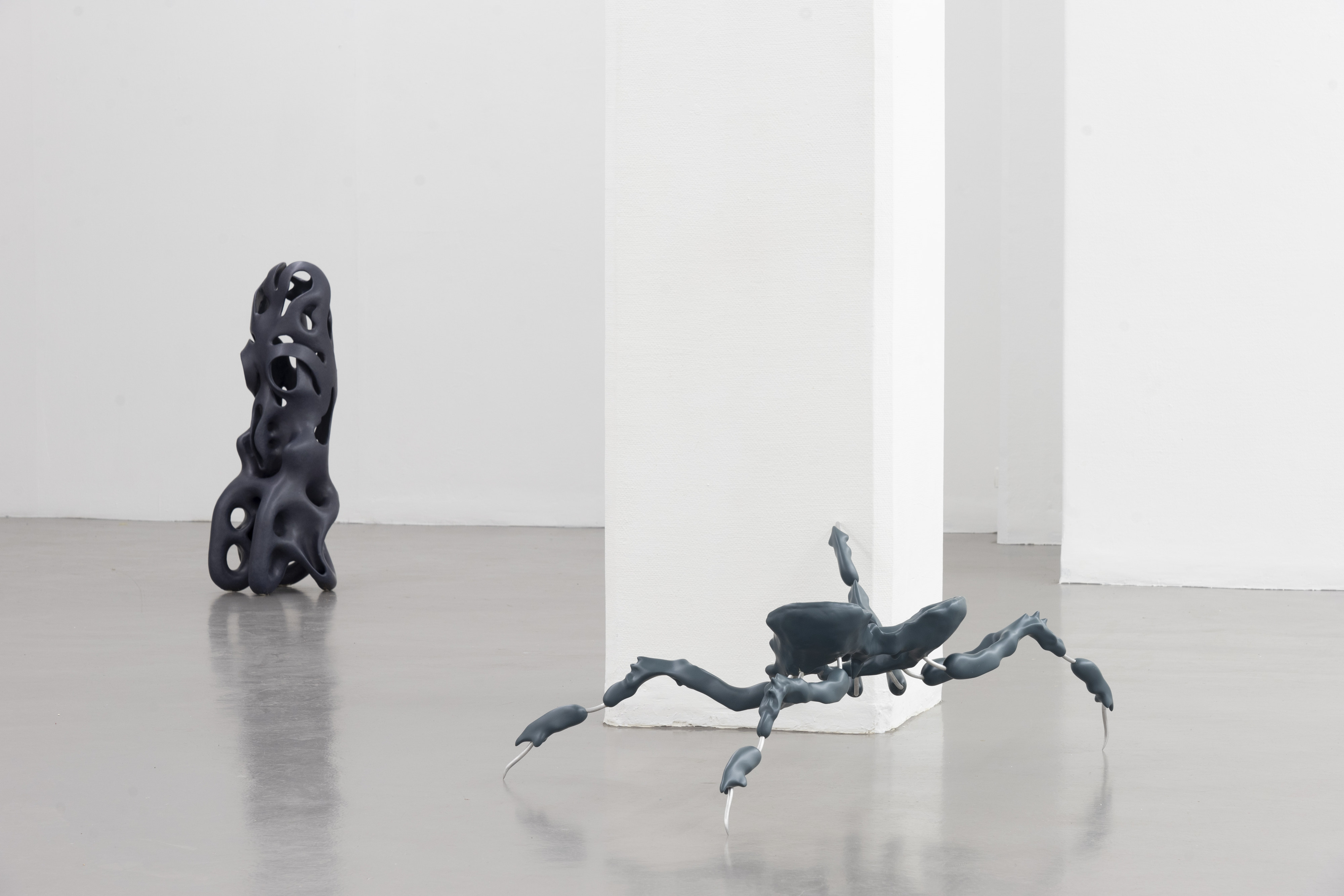
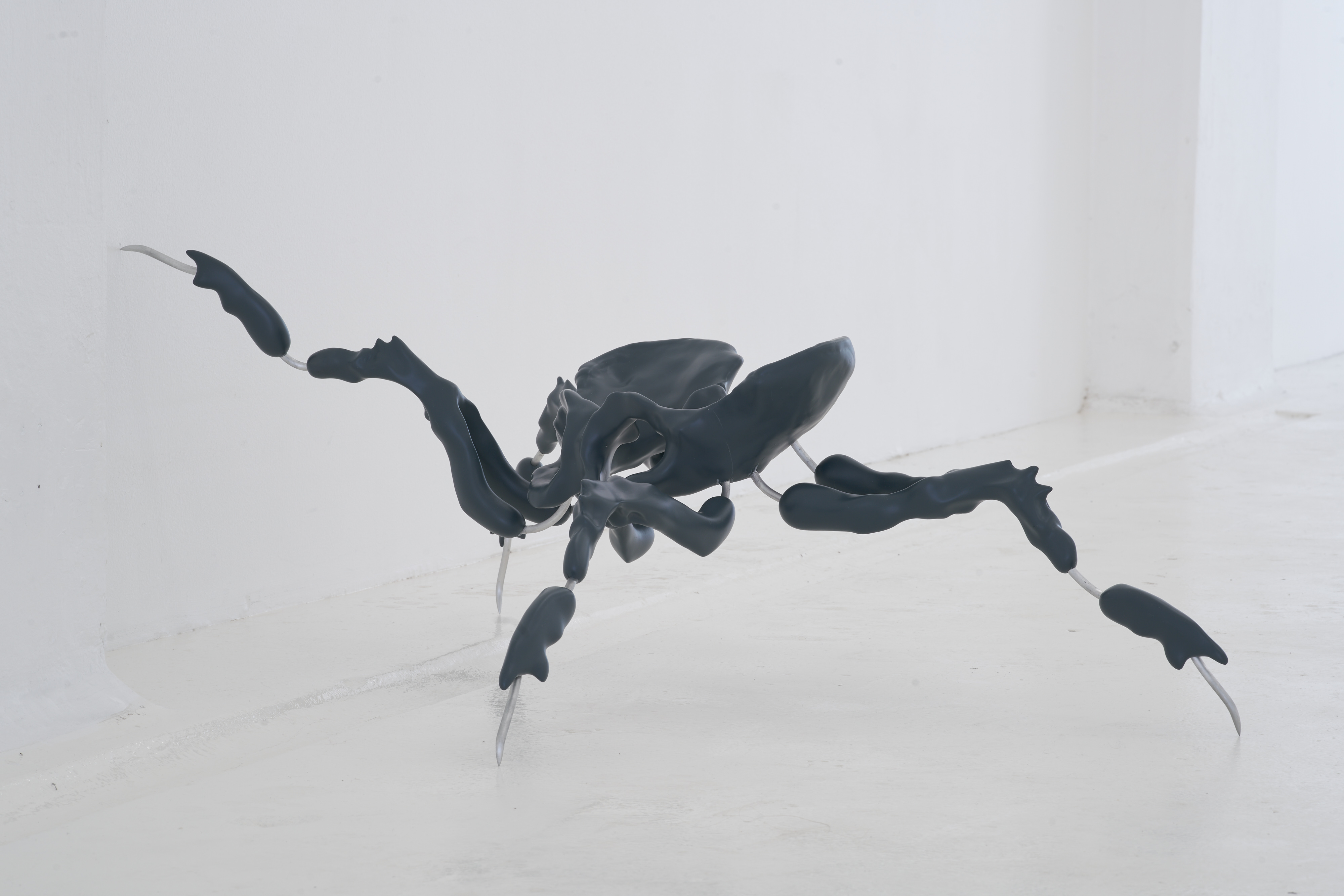
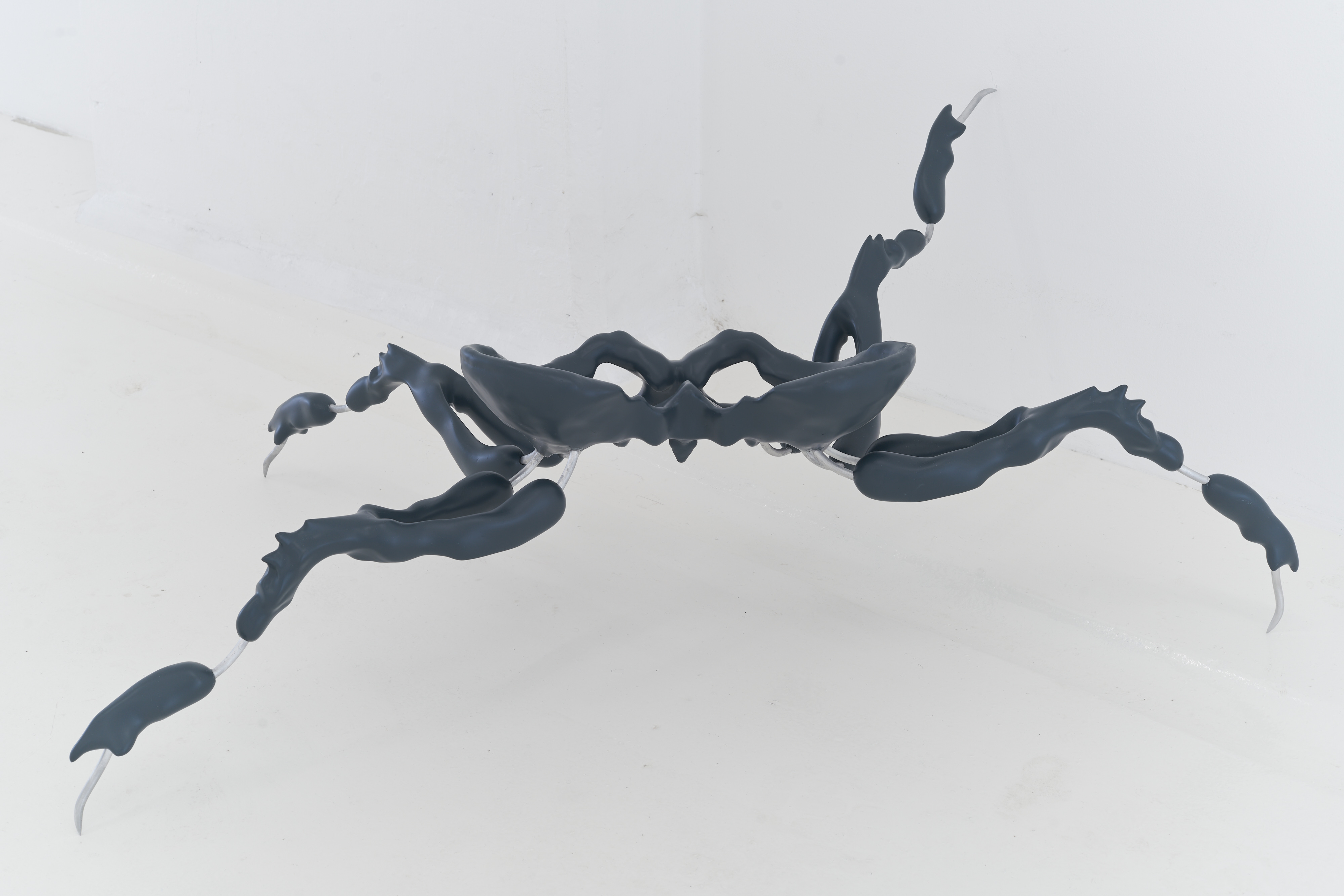
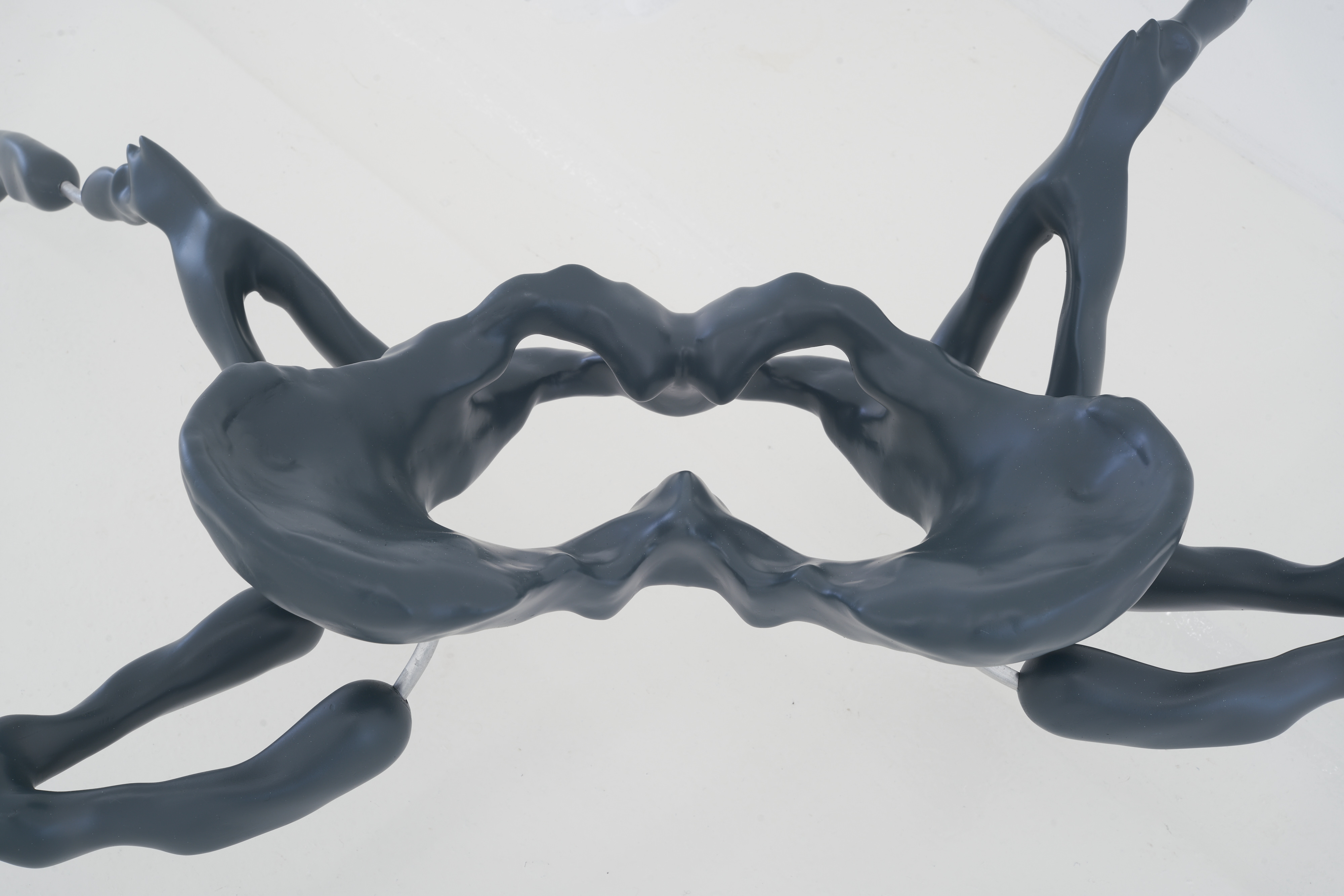
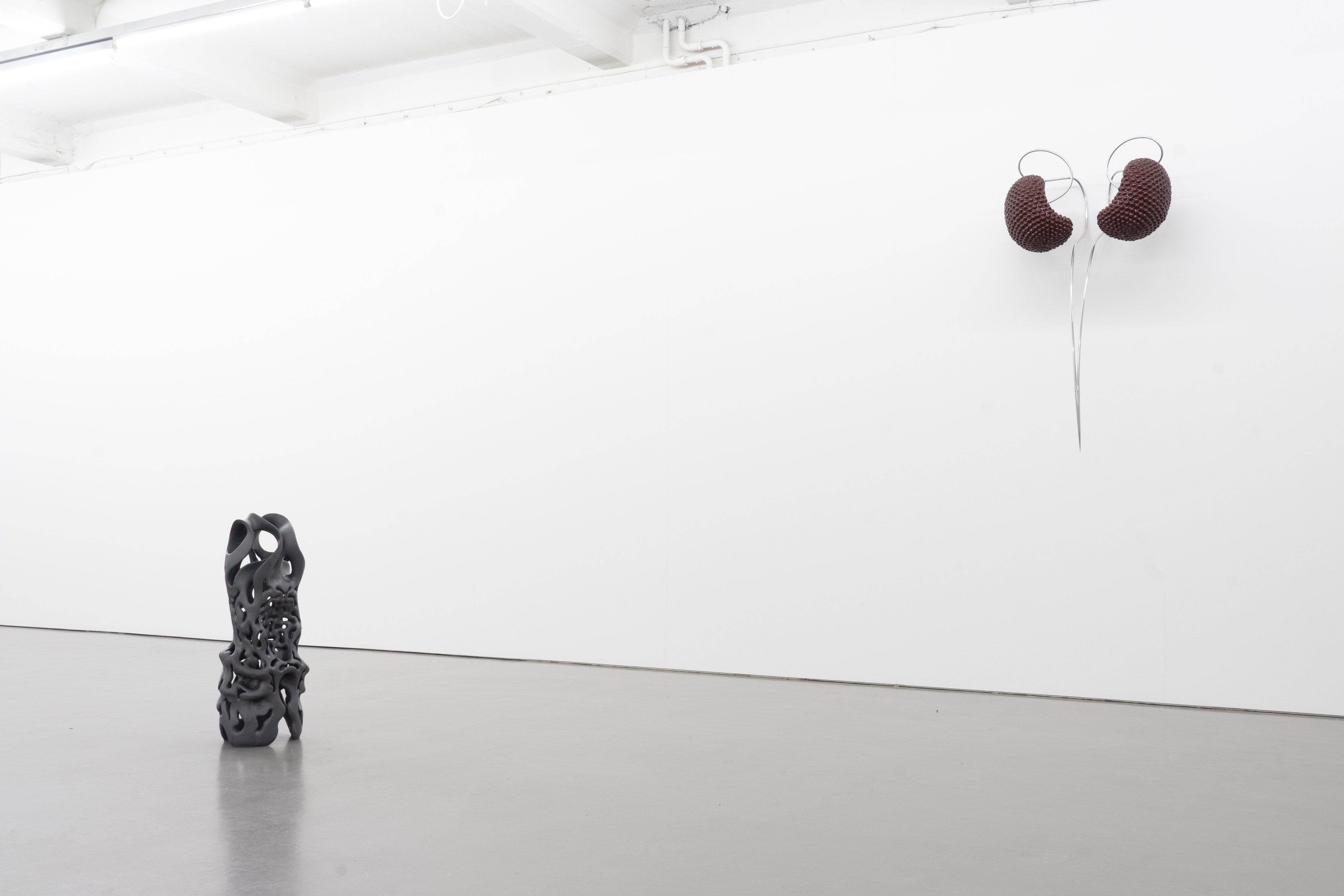
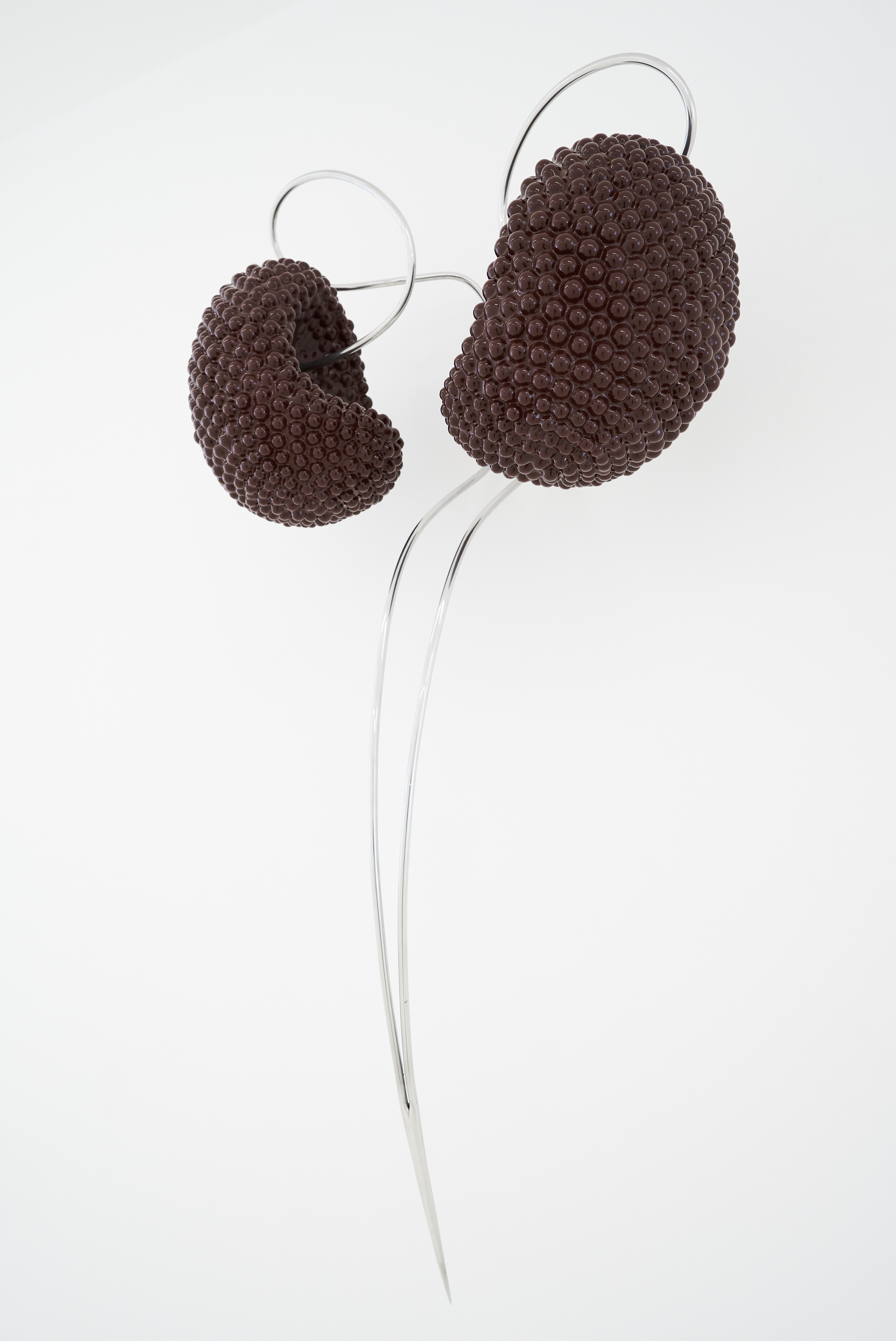
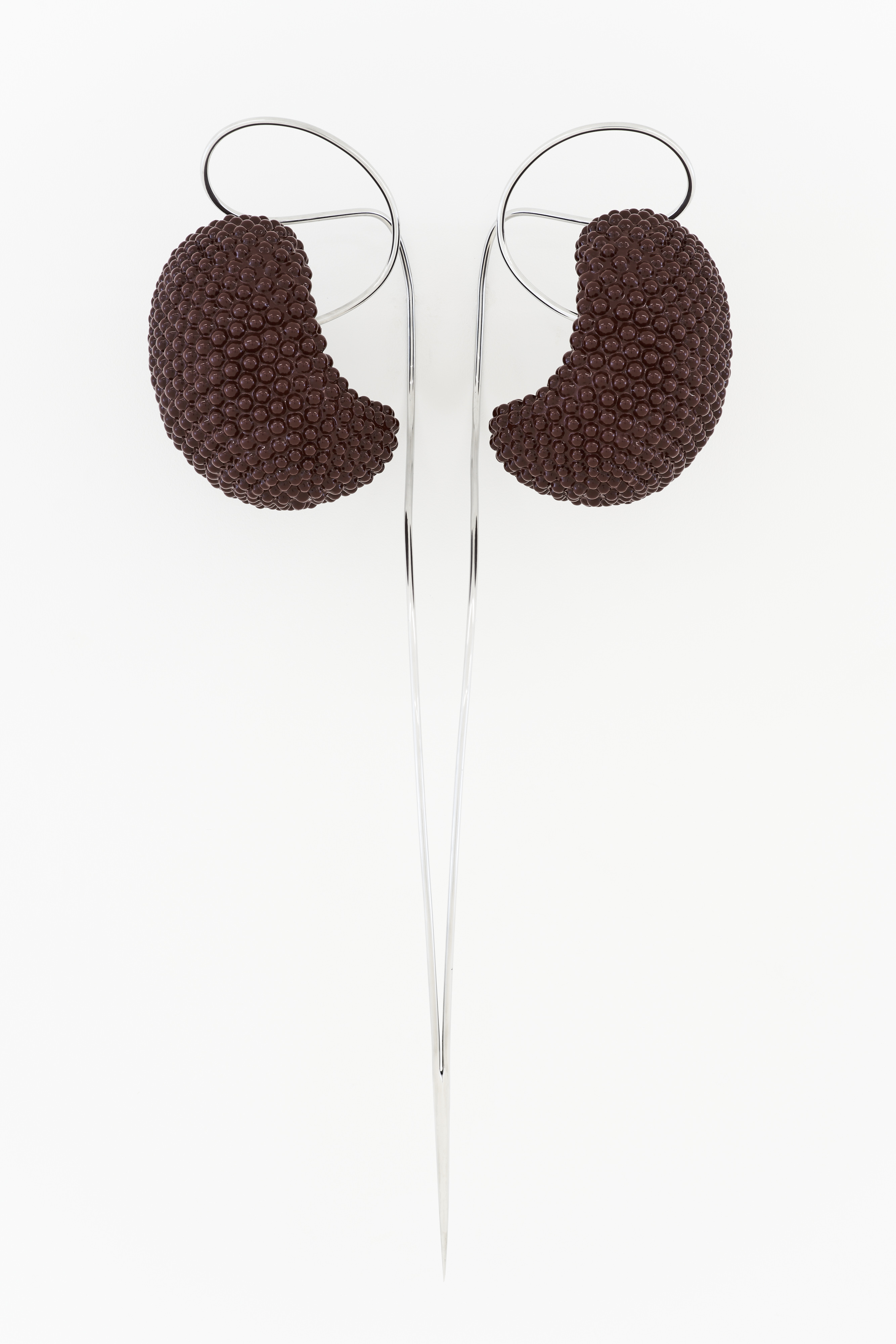
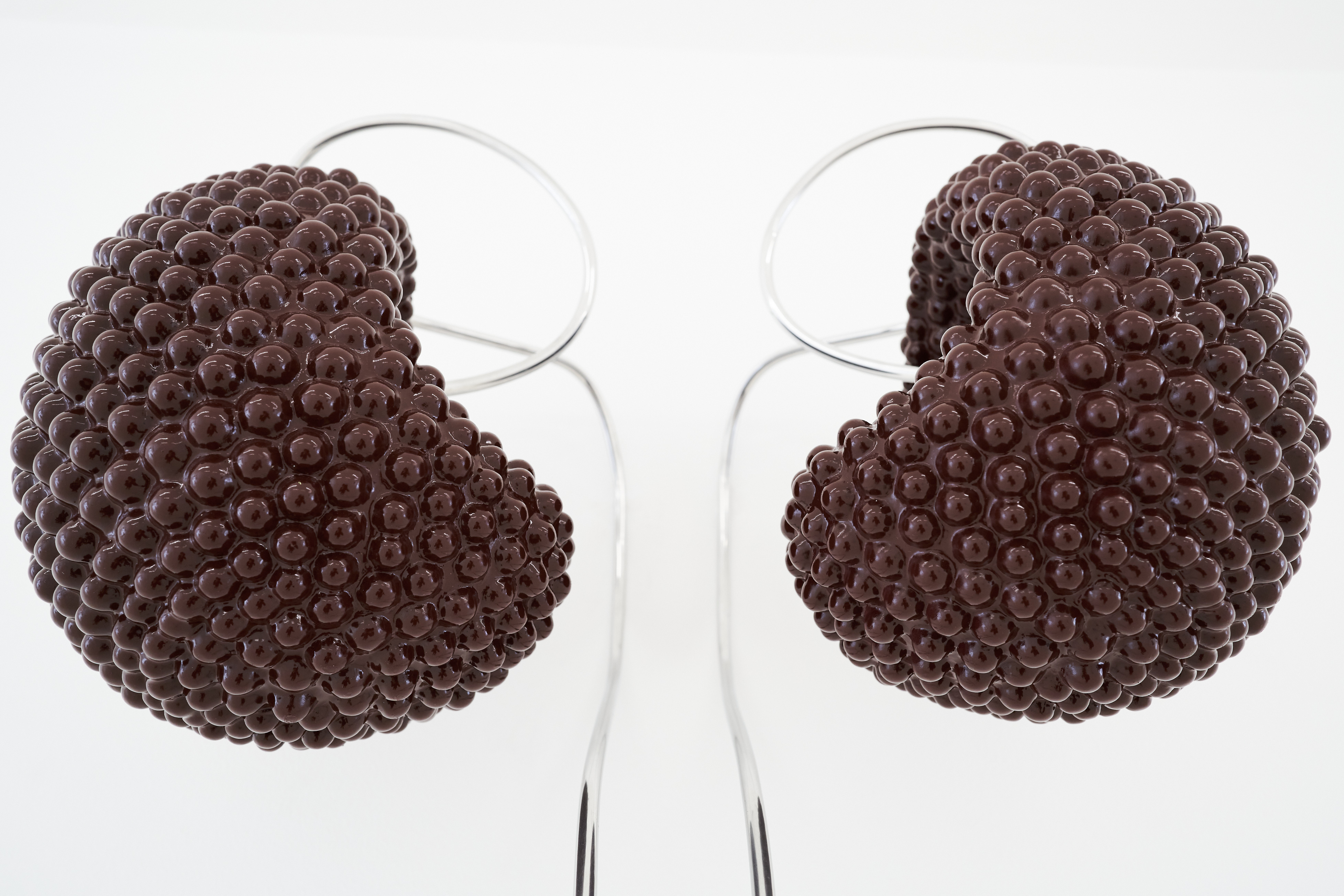





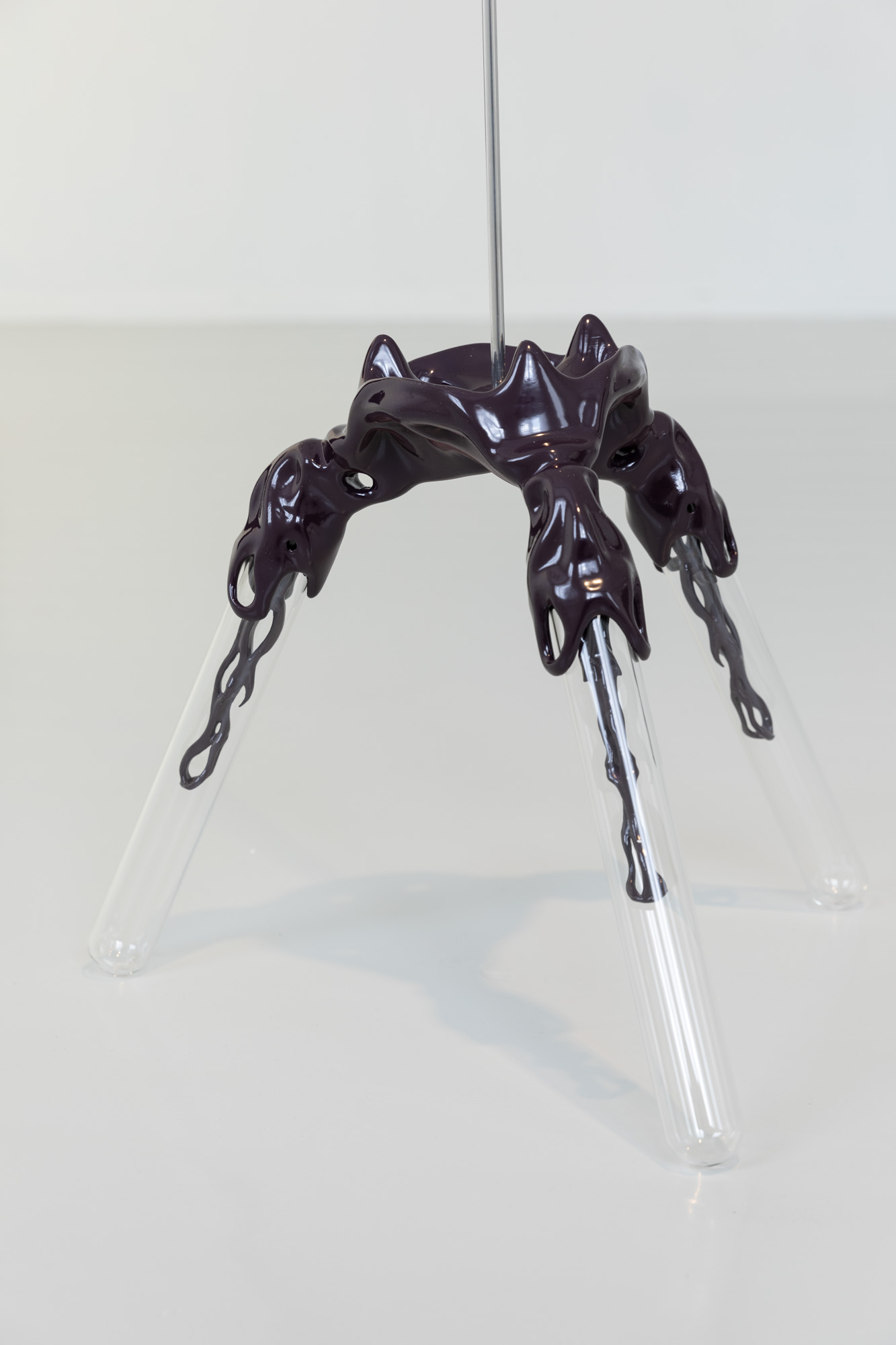

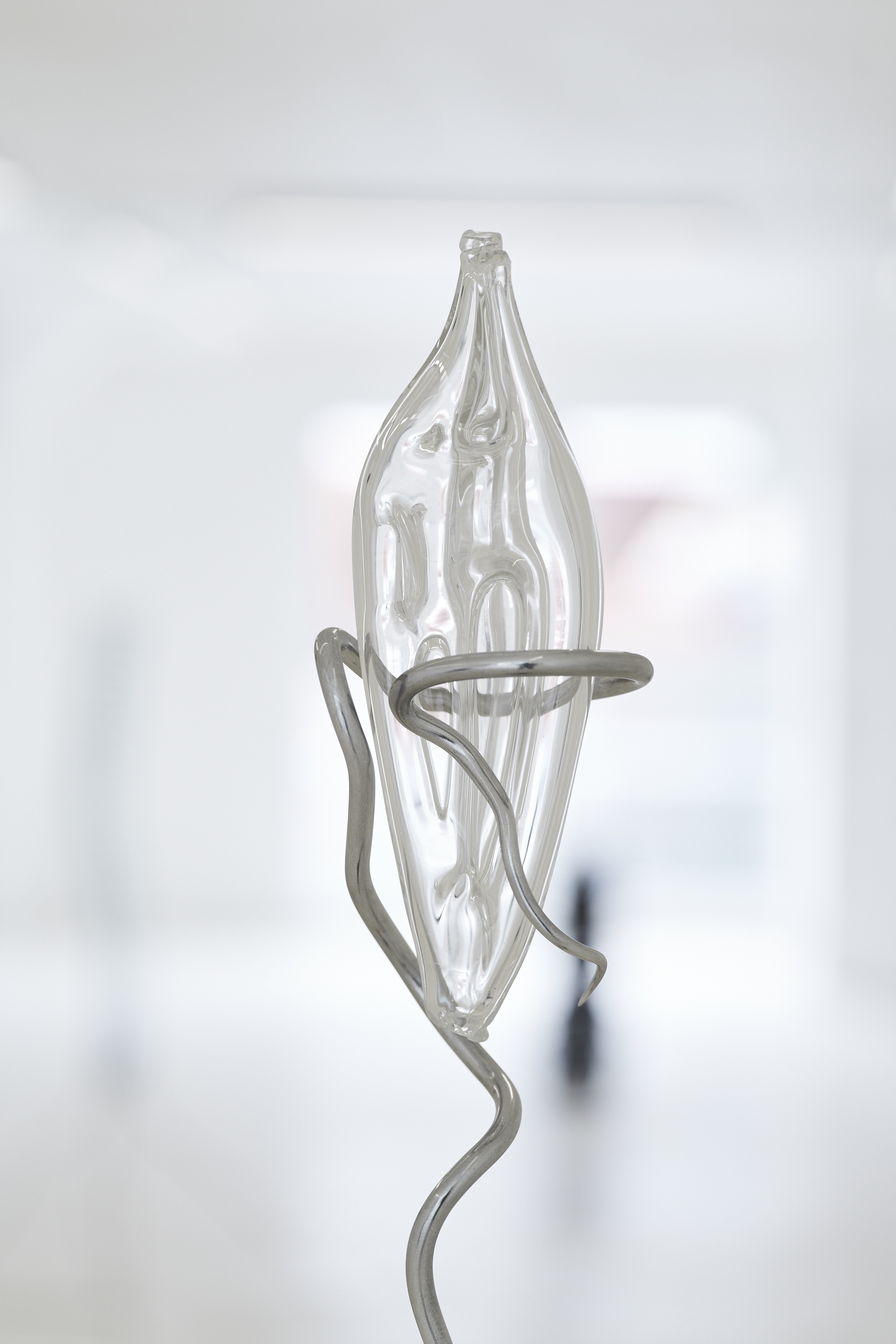
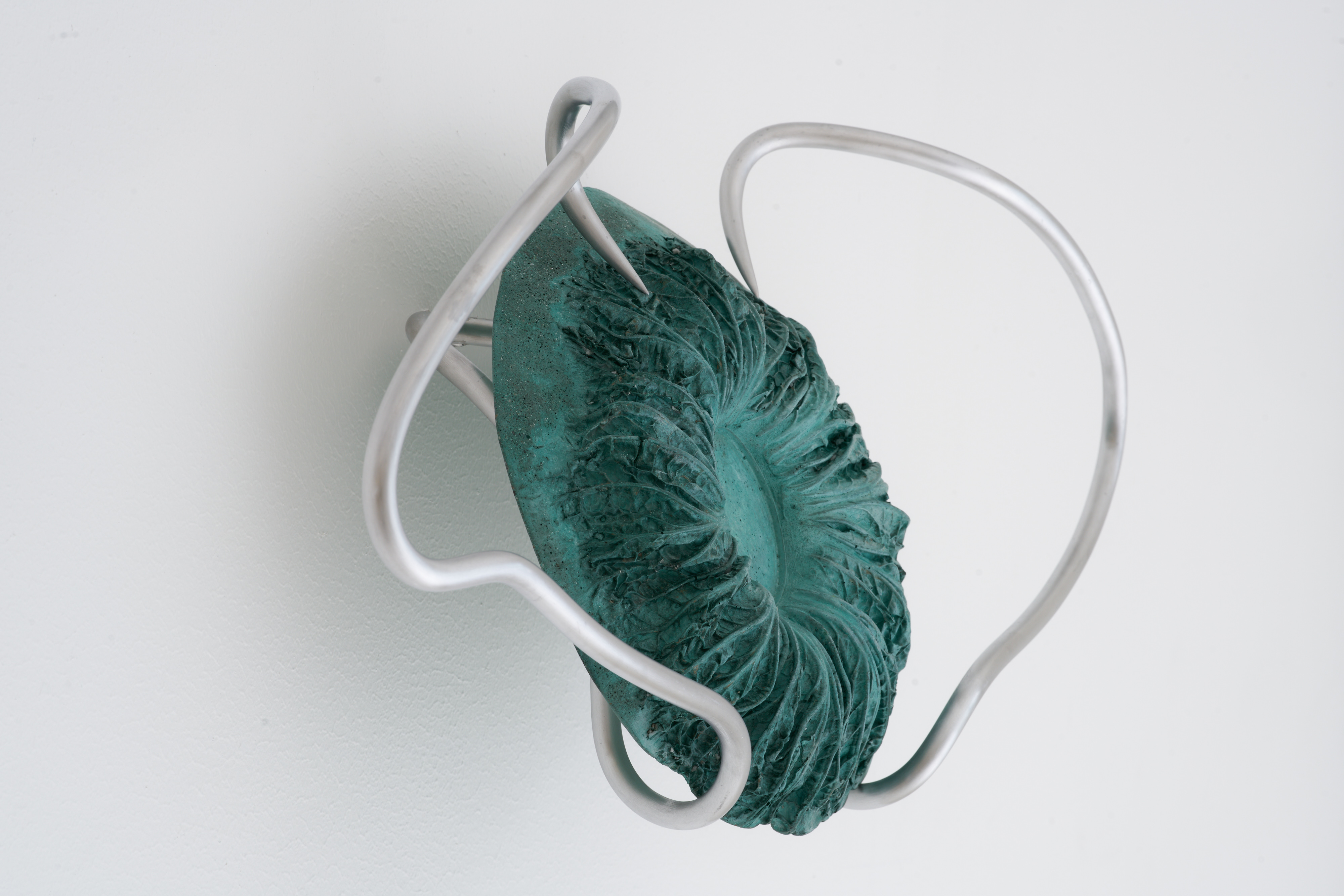

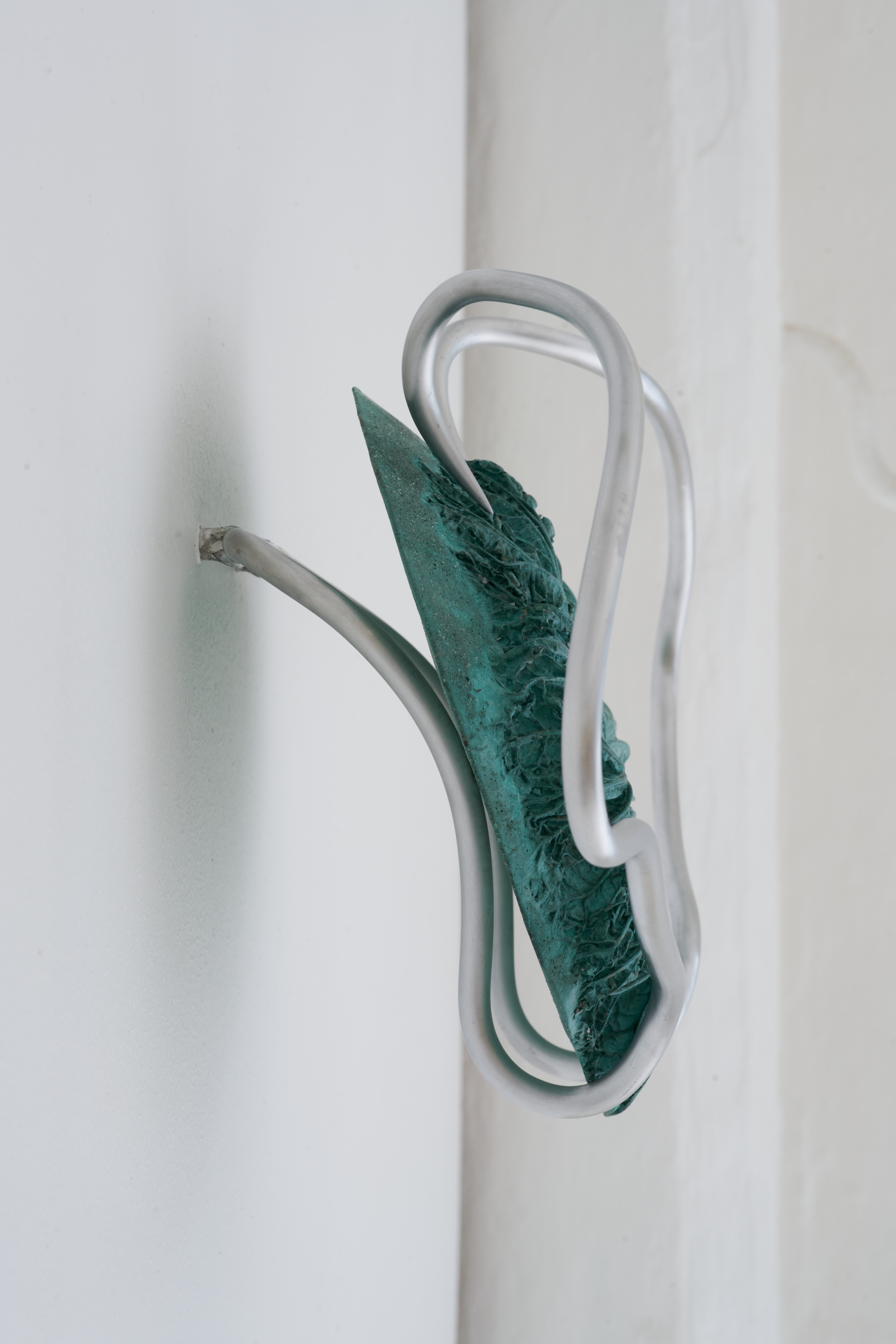
Balsamarium
30. January – 4. April 2021
Nordnorsk Kunstnersenter (North Norwegian Art Centre), Svolvær
Curator: Torill Østby Haaland
Documentation: Kjell Ove Storvik
Reviews:
BALSAM FOR HELBREDELSE, ELLER DØD?, Øystein Voll, Se Kunst Magasin
Morells paradoksale univers by Ina Gravem Johansen, KUNST
Linda Morell: Balsamarium from NNKS / LIAF on Vimeo.
A spine, of sorts, made of ceramics; a glistening, colourful intestine like shape made of glass; a stomach? A heart? A leg. An arm. Linda Morell’s universe is filled with objects that are reminiscent of something human, something bodily. Yet, it is as if the human is disturbingly absent. The organ like objects lay scattered, amputated. Some of them seem to be morphing into something else entirely, and gaining new functionality. Several of them are placed on small tables that evoke associations to something from an operating room, but with submerged bowl like table tops, as if their purpose is to collect the fluids from something that is leaking. The bodies in this room are synthetic and deconstructed. They might resemble prostheses, anatomical models, or parts for a robot. So, who is it meant for, the healing fluid that runs from the cut aloe vera leaves? Who is the intended user of the draped textile that hangs on a rack on the wall? Are the dried plants in the large leg shaped urn, placed against the wall, meant to provide a relaxing atmosphere for someone? If so, what is the meaning of the sharp metal that conjures such painful associations? The sculptures relate to the human body and suggest something healing and caring, while also brutally repelling us.
The brushed steel, the glass and the glazed ceramic surfaces glisten. We have all become used to the clinical and the clean over the past year. Surfaces are continuously being disinfected. Avoiding contamination has become a part of every day life; like a reflex. Morell takes her inspiration from a past long before the covid pandemic. The health temples of ancient Greece, where science and spirituality went hand in hand, has been her staring point for investigating our current relationship to the body and to health. And just as much as glistening, spotless surfaces Morells works deals with what is inside. With the body, with containers, and with the body as a container.
Humourism has its origin in the Greek nature philosophers, and their idea that everything has its origin in the four basic elements of fire, earth, air and water. In the human body, the four elements were represented by the liver, the spleen, the heart and the brain, and the theory was that these four organs in turn discharged the liquids yellow bile, black bile, blood and slime. The idea was that these liquids had to be in balance in order for Man to maintain good health. Too much or lack of one of them tantamount to illness. The body was like a vessel for these four elements, where the landscape within alternated between suffering from drought, cold, heat and moistness. A thing of the past, one might think. Yet Morell has studied how elements from these ancient ideas about the body has lived on alongside modern medical science, and how they intertwine with it in order to create new myths of the optimized body.
“Such as the food is, such is the blood: and such as the blood is, such is the flesh,” wrote Thomas Coghan in the book The Haven of Health in 1584. At this time, humourism permeated medicine. Yet even today, the saying “you are what you eat” is a fairly uncontroversial one. As of the 2000s, detox became a common practice in order to cleanse ones body of inner poisons. The human body was yet again a vessel; an object with vague functions that one attempted to gain control over, shape and construct. The pandemic that hit us on a global scale in 2020 has again proved how inaccessible bodily functions can be to us. In spite of medical research on a grand scale, there is still a lot we do not know. We do not always know who is infected, how sick we may get, nor if or how we regain full health. The ambiguity in Morell’s objects can be read as a timeless expression for the inaccessible and the uncertainties related to the body and its functions.
– Torill Østby Haaland
The brushed steel, the glass and the glazed ceramic surfaces glisten. We have all become used to the clinical and the clean over the past year. Surfaces are continuously being disinfected. Avoiding contamination has become a part of every day life; like a reflex. Morell takes her inspiration from a past long before the covid pandemic. The health temples of ancient Greece, where science and spirituality went hand in hand, has been her staring point for investigating our current relationship to the body and to health. And just as much as glistening, spotless surfaces Morells works deals with what is inside. With the body, with containers, and with the body as a container.
Humourism has its origin in the Greek nature philosophers, and their idea that everything has its origin in the four basic elements of fire, earth, air and water. In the human body, the four elements were represented by the liver, the spleen, the heart and the brain, and the theory was that these four organs in turn discharged the liquids yellow bile, black bile, blood and slime. The idea was that these liquids had to be in balance in order for Man to maintain good health. Too much or lack of one of them tantamount to illness. The body was like a vessel for these four elements, where the landscape within alternated between suffering from drought, cold, heat and moistness. A thing of the past, one might think. Yet Morell has studied how elements from these ancient ideas about the body has lived on alongside modern medical science, and how they intertwine with it in order to create new myths of the optimized body.
“Such as the food is, such is the blood: and such as the blood is, such is the flesh,” wrote Thomas Coghan in the book The Haven of Health in 1584. At this time, humourism permeated medicine. Yet even today, the saying “you are what you eat” is a fairly uncontroversial one. As of the 2000s, detox became a common practice in order to cleanse ones body of inner poisons. The human body was yet again a vessel; an object with vague functions that one attempted to gain control over, shape and construct. The pandemic that hit us on a global scale in 2020 has again proved how inaccessible bodily functions can be to us. In spite of medical research on a grand scale, there is still a lot we do not know. We do not always know who is infected, how sick we may get, nor if or how we regain full health. The ambiguity in Morell’s objects can be read as a timeless expression for the inaccessible and the uncertainties related to the body and its functions.
– Torill Østby Haaland
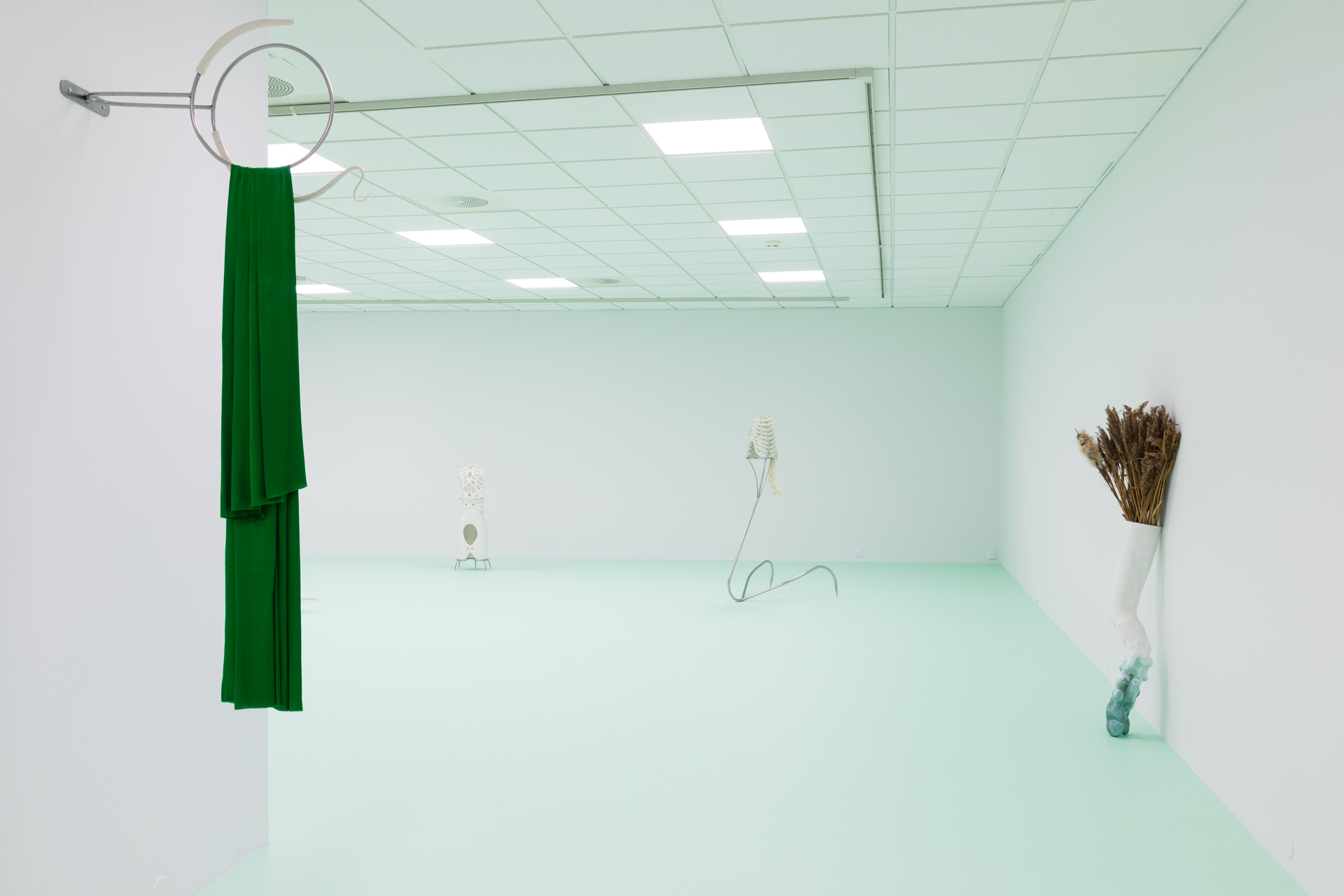












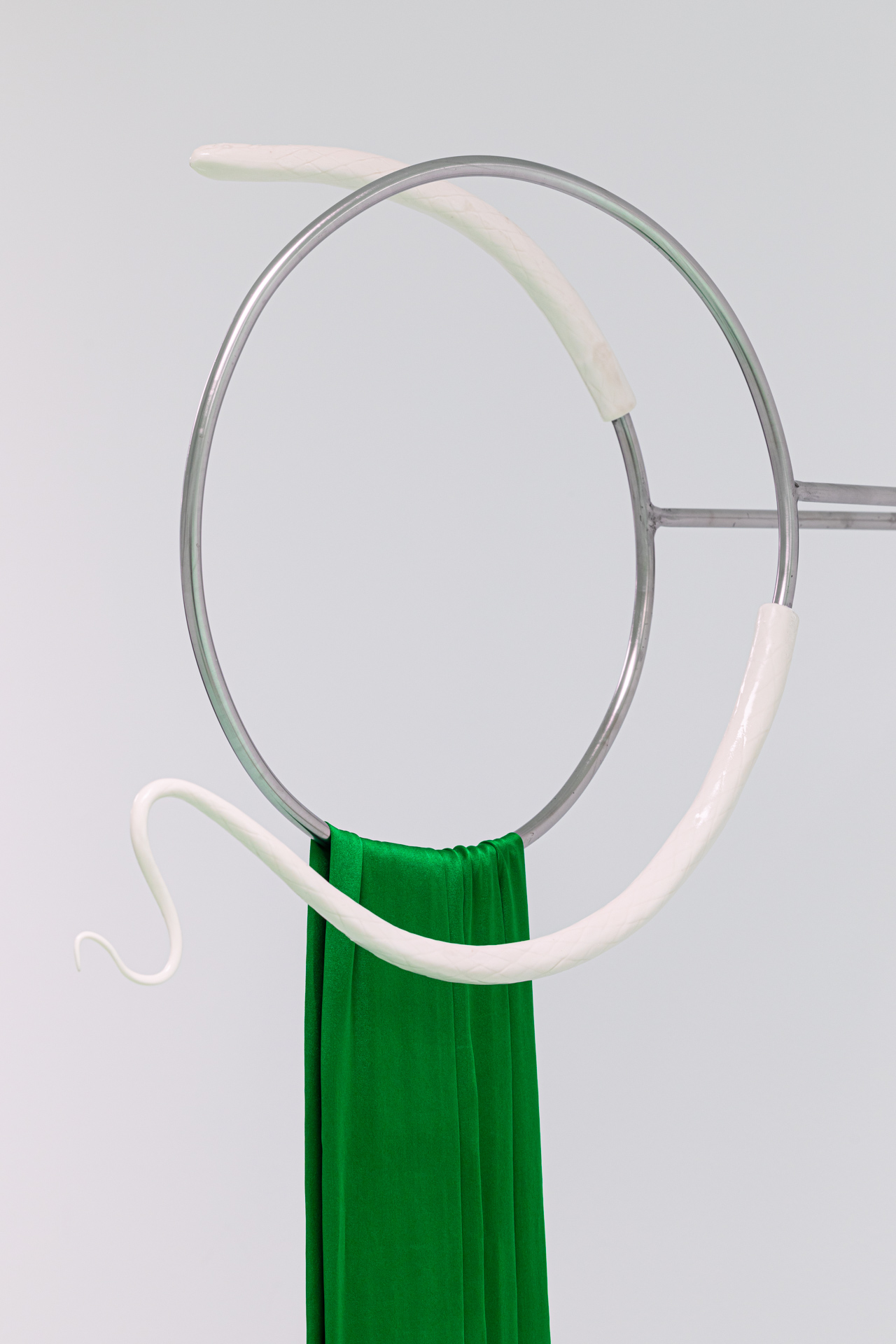






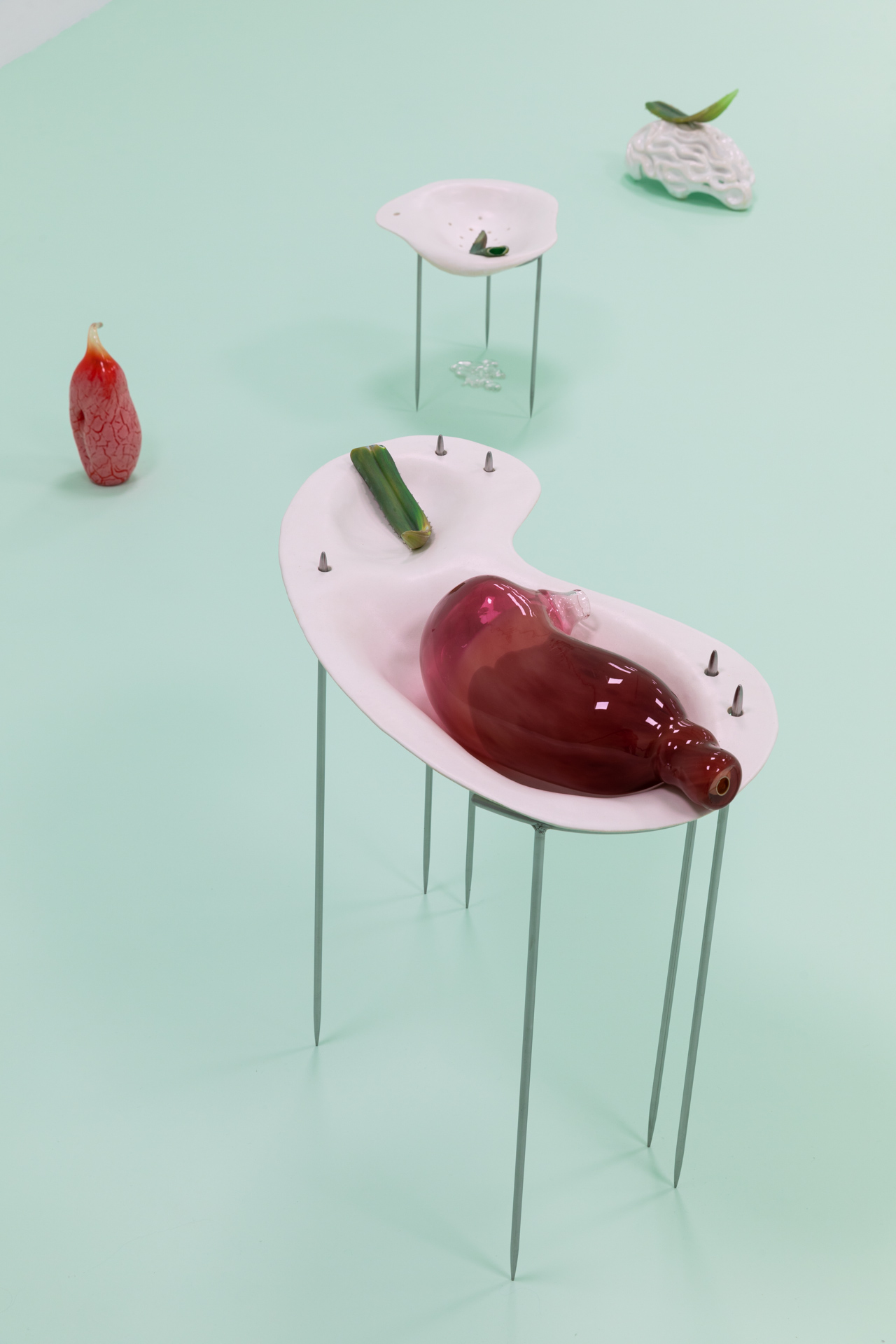






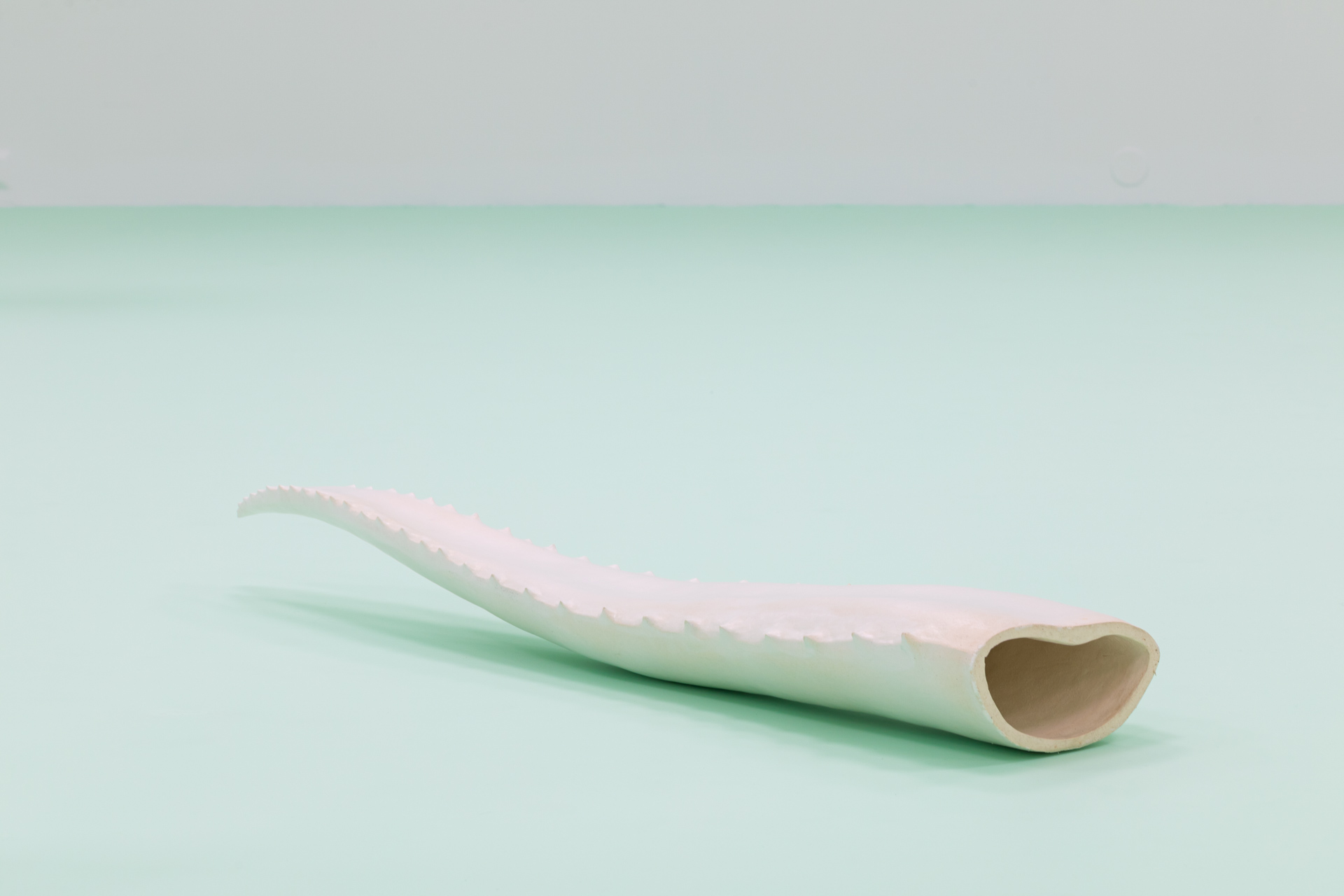





Den Suggestiva Kroppen / The suggestive body
23. September 2021 - 16. January 2022
Konstmuseet i Norr, Kiruna
Curator: Hampus Bergander
Video from the group exhibition The suggestive body.
